Paul van Yperen's Blog, page 271
May 22, 2018
Anna-Maria Ferrero (1934-2018)
On 21 May 2018, Italian actress Anna-Maria Ferrero has passed away in Paris. With her fragile beauty and assured talent, Ferrero made a respectable impact in the Italian cinema of the 1950s. As a teenager she started playing leads in films by Michelangelo Antonioni, Mario Monicelli, Mauro Bolognini and other major directors, and she would star in many stage plays and films opposite Vittorio Gassman. She was married to actor Jean Sorel.

Italian postcard by Bromofoto, Milano, no. 340. Photo: Minerva Film.
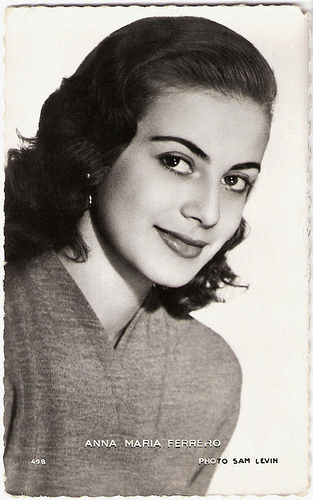
French postcard by P.I., Paris, no. 49 B. Photo: Sam Lévin.

Vintage card. Photo: Video.

Italian postcard by Bromofoto, Milano (Milan), no. 466. Photo: publicity still for Febbre di vivere/Eager to live (Claudio Gora, 1953) with Sandro Milani.
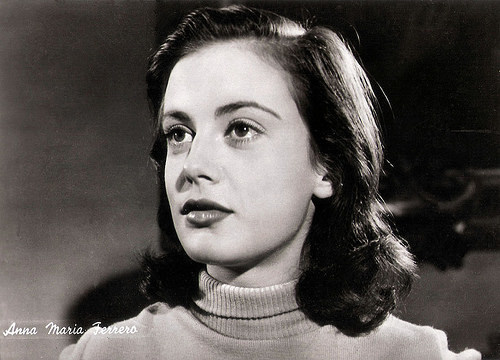
Italian postcard by Bromofoto, no. 408.
Graphic-for-its-times Sexual Content
Anna-Maria Ferrero was born Anna-Maria Isabella Guerra in Rome in 1934. Anna-Maria later changed her last name in honour of famous musical director and conductor Willy Ferrero, who was her godfather.
At the age of 15, she made her screen debut in Il cielo è rosso/The sky is red (Claudio Gora, 1950). Director Claudio Gori had spotted her walking through Via Aurora in Rome, and had offered her a screen test.
At AllMovie, Hal Erickson writes: “The Italian The Sky is Red (Il Cielo è Rosso) details the romantic adventures of two postwar couples. Despite being confined to a quarantined zone (quarantined for political, rather than health reasons), love finds a way. The Neorealistic elements are passable, but what really 'sold' this film abroad was its graphic-for-its-times sexual content. The cast is headed by Jacques Sernas and Marina Berti , another step in the right direction box office-wise.”
Her next roles were in Domani è un altro giorno/Tomorrow is another day (Léonide Moguy, 1951) starring Pier Angeli , and opposite Raf Vallone in Il Cristo proibito/The forbidden Christ (1951), the only film directed by famous author Curzio Malaparte.
In Le infedeli/The Unfaithfuls (Mario Monicelli, Steno, 1953), she appeared with Gina Lollobrigida . Her delicate, photogenic beauty and assured talent attracted director Michelangelo Antonioni, who cast her opposite Franco Interlenghi in the Italian episode of his I vinti/Youth and Perversion (Michelangelo Antonioni, 1953), three stories of well-off youths who commit murders, one taking place in Paris, another in Rome, and another in London.
The following year she co-starred with Marcello Mastroianni in Cronache di poveri amanti/Chronicle of Poor Lovers (Carlo Lizzani, 1954). Her rich role in this film was noted by the critics and the film went on to win the International Prize at the Cannes Film Festival.
Next she starred opposite Alberto Sordi in Una parigina a Roma/A Parisian in Rome (Erich Kobler, 1954), and with comedy star Totò in Totò e Carolina/Toto and Carolina (Mario Monicelli, 1955). On television she starred in 1956 in the drama Cime tempestose/Wuthering Heights alongside Massimo Girotti .
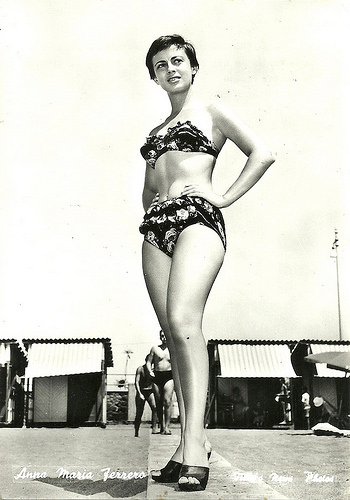
Italian postcard in the Italy's News Photos by Bromofoto, Milano, no. 1244.

Italian postcard by Bromostampa, Milano, no. 295.

German postcard by Universum-Film Aktiengesellschaft (Ufa), Berlin-Tempelhof, no. FK 1217. Retail price: 25 Pfg. Photo: Dial-Unitalia Film, Rome.
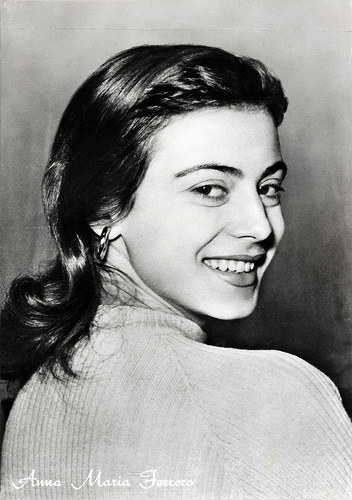
Italian postcard by Rotalfoto, Milano, no. 363. Photo: Universalfoto.
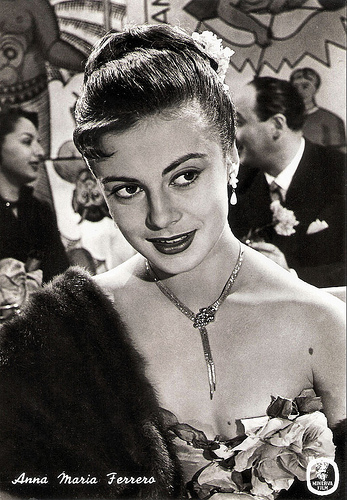
Italian postcard by Bromofoto, no. 721. Photo: Minerva Film. Publicity still for Canzoni di mezzo secolo/Half a Century of Song (Domenico Paolella, 1954).
Gassman and Sorel
Although her career would only span some 15 years, Anna-Maria Ferrero achieved reasonable status in the Italian cinema. She acted rarely outside Italy, but she was featured in the star-studded Paramount epic War and Peace (King Vidor, 1956) starring Audrey Hepburn , Mel Ferrer and Henry Fonda.
Another co-star in this production filmed in Cinecittà was Vittorio Gassman , who had been her partner since 1953. The couple often worked together. On stage, she had joined his theatre company and worked there for several seasons. Notable were her Ophelia in Hamlet, Desdemona in Othello and her title role in the musical Irma la Douce.
In the cinema, Ferrero and Gassman starred together in the Alexandre Dumas' drama Kean/Kean: Genius or Scoundrel (Vittorio Gassman, Francesco Rosi, 1956), the adventure Giovanni dalle bande nere/The violent patriot (Sergio Grieco, 1956), the romantic comedy Le sorprese dell'amore/Surprise of love (Luigi Comencini, 1959), the drama La notte brava/Bad Girls Don't Cry (Mauro Bolognini, 1959) and the comedy Il mattatore/Love and larceny (Dino Risi, 1960). In 1960 their relationship ended.
Ferrero had some spirited performances in the adventurous Il gobbo/The Hunchback of Rome (Carlo Lizzani, 1961), and L'oro di Roma/Gold of Rome (Carlo Lizzani, 1961), both with Gérard Blain .
The following year she married the French actor Jean Sorel , with whom she starred in the comedy Un marito in condominio/A husband in the condominium (Angelo Dorigo, 1963).
Ettore Scola directed her opposite Nino Manfredi in Cocaina di domenica/Cocaine on Sunday, an episode of the anthology film Controsesso/Countersex (1965), in which a husband and wife start snorting cocaine after the friend who owned the bottle with the drug is arrested.
Then, at the age of 37, Anna Maria Ferrero suddenly ended her career. Her retirement surprised many, but she never made a come-back to the film world.
At the time of her death, Anna Maria Ferrero was still married to Jean Sorel . She was 84.

Italian postcard by Vetta Traldi, Milano in the Divi del Cinema series, no. 51. Sent by mail in 1955.
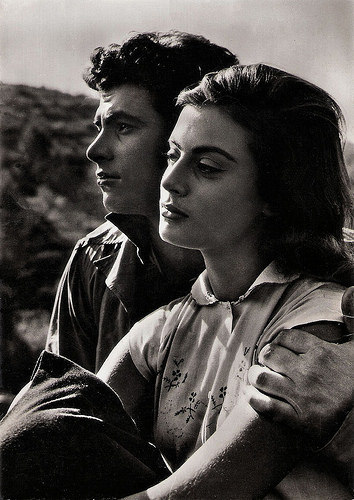
Italian postcard by Rotalfoto, Milano. Photo: Ponti - De Laurentiis. Publicity still for Totò e Carolina/Totò and Carolina (Mario Monicelli, 1955) with Maurizio Arena .
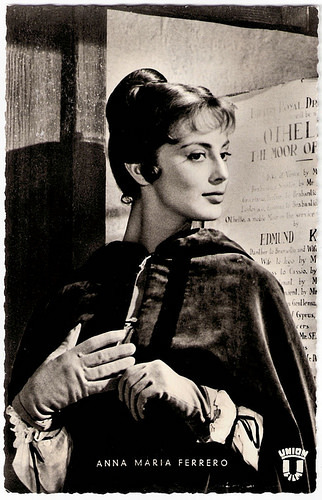
German postcard by Kunst und Bild, Berlin-Charlottenburg, no. I 282. Photo: Union Film. Publicity still for Kean - Genio e sregolatezza/Kean: Genius or Scoundrel (Vittorio Gassman, Francesco Rosi, 1957).

Italian postcard by Rotalfoto, Milano, no. N. 138.
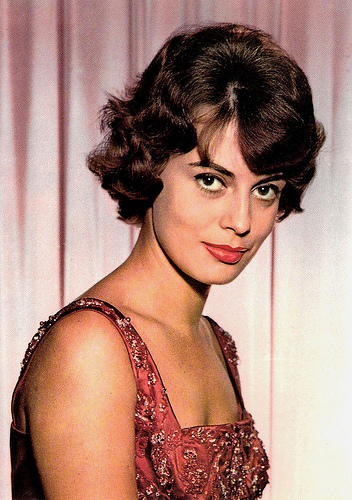
Italian postcard by Rotalfoto, Milano (Milan), no. 60.
Sources: (IMDb), Hal Erickson (AllMovie), Wikipedia (English and Italian) and .

Italian postcard by Bromofoto, Milano, no. 340. Photo: Minerva Film.

French postcard by P.I., Paris, no. 49 B. Photo: Sam Lévin.

Vintage card. Photo: Video.

Italian postcard by Bromofoto, Milano (Milan), no. 466. Photo: publicity still for Febbre di vivere/Eager to live (Claudio Gora, 1953) with Sandro Milani.

Italian postcard by Bromofoto, no. 408.
Graphic-for-its-times Sexual Content
Anna-Maria Ferrero was born Anna-Maria Isabella Guerra in Rome in 1934. Anna-Maria later changed her last name in honour of famous musical director and conductor Willy Ferrero, who was her godfather.
At the age of 15, she made her screen debut in Il cielo è rosso/The sky is red (Claudio Gora, 1950). Director Claudio Gori had spotted her walking through Via Aurora in Rome, and had offered her a screen test.
At AllMovie, Hal Erickson writes: “The Italian The Sky is Red (Il Cielo è Rosso) details the romantic adventures of two postwar couples. Despite being confined to a quarantined zone (quarantined for political, rather than health reasons), love finds a way. The Neorealistic elements are passable, but what really 'sold' this film abroad was its graphic-for-its-times sexual content. The cast is headed by Jacques Sernas and Marina Berti , another step in the right direction box office-wise.”
Her next roles were in Domani è un altro giorno/Tomorrow is another day (Léonide Moguy, 1951) starring Pier Angeli , and opposite Raf Vallone in Il Cristo proibito/The forbidden Christ (1951), the only film directed by famous author Curzio Malaparte.
In Le infedeli/The Unfaithfuls (Mario Monicelli, Steno, 1953), she appeared with Gina Lollobrigida . Her delicate, photogenic beauty and assured talent attracted director Michelangelo Antonioni, who cast her opposite Franco Interlenghi in the Italian episode of his I vinti/Youth and Perversion (Michelangelo Antonioni, 1953), three stories of well-off youths who commit murders, one taking place in Paris, another in Rome, and another in London.
The following year she co-starred with Marcello Mastroianni in Cronache di poveri amanti/Chronicle of Poor Lovers (Carlo Lizzani, 1954). Her rich role in this film was noted by the critics and the film went on to win the International Prize at the Cannes Film Festival.
Next she starred opposite Alberto Sordi in Una parigina a Roma/A Parisian in Rome (Erich Kobler, 1954), and with comedy star Totò in Totò e Carolina/Toto and Carolina (Mario Monicelli, 1955). On television she starred in 1956 in the drama Cime tempestose/Wuthering Heights alongside Massimo Girotti .

Italian postcard in the Italy's News Photos by Bromofoto, Milano, no. 1244.

Italian postcard by Bromostampa, Milano, no. 295.

German postcard by Universum-Film Aktiengesellschaft (Ufa), Berlin-Tempelhof, no. FK 1217. Retail price: 25 Pfg. Photo: Dial-Unitalia Film, Rome.

Italian postcard by Rotalfoto, Milano, no. 363. Photo: Universalfoto.

Italian postcard by Bromofoto, no. 721. Photo: Minerva Film. Publicity still for Canzoni di mezzo secolo/Half a Century of Song (Domenico Paolella, 1954).
Gassman and Sorel
Although her career would only span some 15 years, Anna-Maria Ferrero achieved reasonable status in the Italian cinema. She acted rarely outside Italy, but she was featured in the star-studded Paramount epic War and Peace (King Vidor, 1956) starring Audrey Hepburn , Mel Ferrer and Henry Fonda.
Another co-star in this production filmed in Cinecittà was Vittorio Gassman , who had been her partner since 1953. The couple often worked together. On stage, she had joined his theatre company and worked there for several seasons. Notable were her Ophelia in Hamlet, Desdemona in Othello and her title role in the musical Irma la Douce.
In the cinema, Ferrero and Gassman starred together in the Alexandre Dumas' drama Kean/Kean: Genius or Scoundrel (Vittorio Gassman, Francesco Rosi, 1956), the adventure Giovanni dalle bande nere/The violent patriot (Sergio Grieco, 1956), the romantic comedy Le sorprese dell'amore/Surprise of love (Luigi Comencini, 1959), the drama La notte brava/Bad Girls Don't Cry (Mauro Bolognini, 1959) and the comedy Il mattatore/Love and larceny (Dino Risi, 1960). In 1960 their relationship ended.
Ferrero had some spirited performances in the adventurous Il gobbo/The Hunchback of Rome (Carlo Lizzani, 1961), and L'oro di Roma/Gold of Rome (Carlo Lizzani, 1961), both with Gérard Blain .
The following year she married the French actor Jean Sorel , with whom she starred in the comedy Un marito in condominio/A husband in the condominium (Angelo Dorigo, 1963).
Ettore Scola directed her opposite Nino Manfredi in Cocaina di domenica/Cocaine on Sunday, an episode of the anthology film Controsesso/Countersex (1965), in which a husband and wife start snorting cocaine after the friend who owned the bottle with the drug is arrested.
Then, at the age of 37, Anna Maria Ferrero suddenly ended her career. Her retirement surprised many, but she never made a come-back to the film world.
At the time of her death, Anna Maria Ferrero was still married to Jean Sorel . She was 84.

Italian postcard by Vetta Traldi, Milano in the Divi del Cinema series, no. 51. Sent by mail in 1955.

Italian postcard by Rotalfoto, Milano. Photo: Ponti - De Laurentiis. Publicity still for Totò e Carolina/Totò and Carolina (Mario Monicelli, 1955) with Maurizio Arena .

German postcard by Kunst und Bild, Berlin-Charlottenburg, no. I 282. Photo: Union Film. Publicity still for Kean - Genio e sregolatezza/Kean: Genius or Scoundrel (Vittorio Gassman, Francesco Rosi, 1957).

Italian postcard by Rotalfoto, Milano, no. N. 138.

Italian postcard by Rotalfoto, Milano (Milan), no. 60.
Sources: (IMDb), Hal Erickson (AllMovie), Wikipedia (English and Italian) and .
Published on May 22, 2018 22:00
May 21, 2018
Károly Huszár (Charles Puffy)
Fat Hungarian stage and film comedian Károly Huszár (1884–1942 or 1943) was the most popular slapstick star of the Hungarian silent era. He later worked in both Germany and Hollywood, also using the names Karl Huszár-Puffy and Charles Puffy. He played minor roles in feature films and was the star of a series of slapstick shorts for Universal. Besides his film work, he frequently appeared on stage, mostly as a comedian.
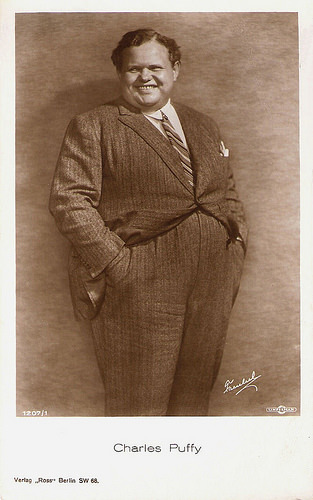
German postcard by Ross Verlag, no. 1207/1, 1927-1928. Photo: Roman Freulich / Unfilman (Universal).
290 pounds
Károly Huszár or Charles Puffy was born as Károly Hochstadt (according to some sources: Hochstein) in Budapest, Austria-Hungary (now Hungary) in 1884.
At 16, the still thin Hochstadt became the long distance swimming champion of Germany. He studied acting at the Országos Színészegyesület Színészképző Iskoláját (National Actor Association's Actor Training School).
Then he worked 16 years on stage in Budapest, where he became a star of the cabarets, and also wrote some comedies.
He started his film career as Károly Huszár in such silent shorts as Víg egyveleg, avagy Pufi és társai/Merry Pompi, or Pufi and his companions (Kornél Tábori, 1914) and Pufi cipöt vesz/Puffy buys shoes (Kornél Tábori, 1914).
In these films he played a character called 'Pufi'. It became his nickname and stage name. ‘Pufi’ means ‘Fatty’ in Hungarian and indeed the thin swimming champion had a legendary appetite and had gained quite some pounds. In his prime Pufi weighted ca. 290 pounds.
In 1917 he worked with director Michael Curtiz (then still Mihály Kertész) at Tavasz a télben/Spring in Winter (1917), and Az Ezredes/The Colonel (1917) with the young Béla Lugosi . That year he also worked with another famous director-to-be, Alexander Korda (as Korda Sándor), at Szent Péter esernyöje/St. Peter's Umbrella (1917) with Victor Varconi .
In 1920 he made his first film in Germany, Putschliesel (Erich Schönfelder, 1920) featuring Ossi Oswalda . He was featured as Karl Huszar-Puffy.
The next year, such films followed as Der Mord ohne Täter/The murder without offender (Ewald André Dupont, 1921), the serial Der Mann ohne Namen/The Man Without a Name (Georg Jacoby, 1921) featuring Harry Liedtke , and Der Roman eines Dienstmädchens/The Novel of a Handmaid (Reinhold Schünzel, 1921) with Liane Haid .
That year, he worked twice with director Friedrich Zelnik (later Fredric Zenik) and his star-producer Lya Mara , on Miss Beryll... die Laune eines Millionärs/Miss Beryll, the mood of a millionaire (Friedrich Zelnik, 1921) and on Aus den Memoiren einer Filmschauspielerin/From the memoirs of a film actress (Friedrich Zelnik, 1921).
However, the most famous director he worked with that year was Fritz Lang. Puffy appeared as the emperor of China in the fantasy Der müde Tod/Destiny (Fritz Lang, 1921).
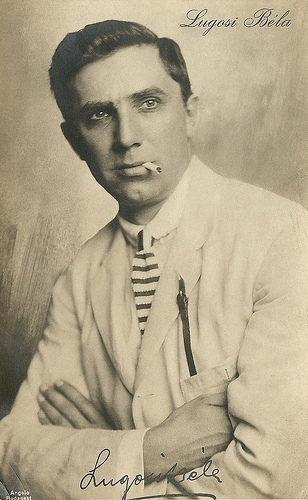
Béla Lugosi . Hungarian postcard. Photo: Angelo, Budapest. Collection: Didier Hanson.
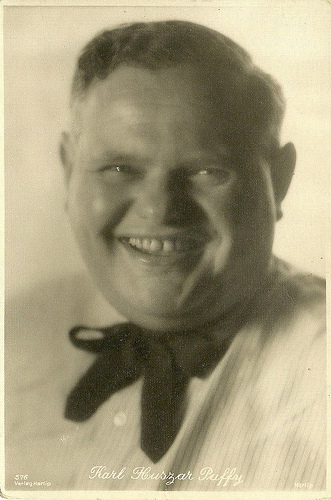
Vintage postcard by Verlag Hartiq, no. 576. Photo by Hartiq. Collection: Didier Hanson.
Charles Puffy
In 1922 Károly Huszár made his American debut in Arctic Adventure (Chester Withey, 1922). That year he also had a part in Fritz Lang’s classic crime thriller Dr. Mabuse, der Spieler - Ein Bild der Zeit/Dr. Mabuse: The Gambler (1922) starring Rudolf Klein-Rogge as arch-criminal Dr. Mabuse. He also appeared opposite film legend Henny Porten in Sie und die Drei/She and the Three (Ewald André Dupont, 1922).
In 1923, Universal offered him a contract to make a series of comedy shorts in Hollywood under the name Charles Puffy. He starred in some 26 shorts between 1924 and 1927 including City Bound (Richard Smith, 1925), Unwelcome (Richard Smith, 1925) and Ah! Gay Vienna! (Harry Sweet, 1927).
He also appeared in minor roles in such feature films as Open All Night (Paul Bern, 1924) starring Viola Dana and Jetta Goudal , the melodramas The Rose of Paris (Irving Cummings, 1924) featuring Mary Philbin as a poor French orphan, and The Love Thief (John McDermott, 1926).
In Hollywood, Puffy also worked with several European directors. He played supporting parts in Benjamin Christensen’s melodrama Mockery (1927) starring Lon Chaney , in Ewald André Dupont’s comedy Love Me and the World Is Mine (1927) and in Alexander Korda’s comedy The Private Life of Helen of Troy (1927).
One of his most interesting Hollywood films is The Man Who Laughs (1928) directed by the German Expressionist filmmaker Paul Leni. The film is an adaptation of Victor Hugo's novel of the same name and stars Conrad Veidt as Gwynplaine and Mary Philbin as the blind Dea. Universal put over $1,000,000 into The Man Who Laughs, an extremely high budget for an American film at the time.
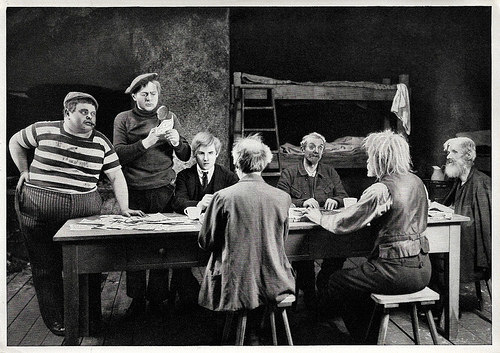
German collectors card by Ross Verlag in the series Vom Werden deutscher Filmkunst - Der Stumme Film, picture no. 94, group 40. Photo: Ufa. Publicity still with Károly Huszár (left) and Rudolf Klein-Rogge (second from left) in Dr. Mabuse, der Spieler/Dr. Mabuse, King of Crime (Fritz Lang, 1922). Caption: Dr. Mabuse, who prints false money, lets the false notes sort by blind people who can not betray him.
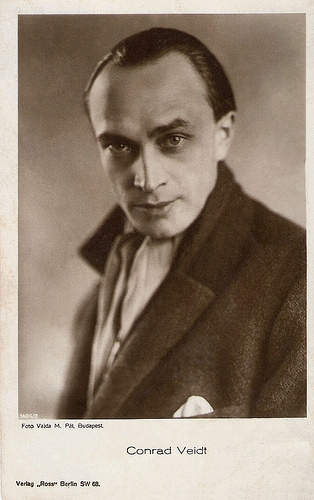
Conrad Veidt . German postcard by Ross Verlag, Berlin, nr. 1426/2, 1927-1928. Photo: Vaida M. Pál, Budapest.
Holocaust
At the time of the introduction of the sound film, Károly Huszár returned to Germany. He appeared twice in minor roles opposite Marlene Dietrich , in Ich küsse Ihre Hand, Madame/I Kiss Your Hand Madame (Robert Land, 1929), and in her breakthrough film Der blaue Engel/The Blue Angel (Josef von Sternberg, 1930) in which Puffy played the club owner.
After several of such bit roles Puffy played a leading part in the comedy Der nächtse Bitte/Next please (Erich Schönfelder, 1930) opposite Adele Sandrock . However, the following years he was seen only in supporting parts.
Károly Huszár reunited with Alexander Korda for Die Männer um Lucie/The Men around Lucie (Alexander Korda, 1931) with Liane Haid.
In 1933, after the Nazis came to power, he returned to Hungary, where he continued to play supporting parts. Among these Hungarian films are Pardon, tévedtem/Romance in Budapest (Steve Sekely, Géza von Bolváry, 1933) with Franziska Gaál and Paul Hörbiger , Helyet az öregeknek/Room for the Aged (Béla Gaál, 1934) with Szõke Szakáll , and Kleine Mutti/Little Mother (Hermann Kosterlitz a.k.a. Henry Koster, 1935) featuring Franziska Gaál .
His final Hungarian film was Nehéz apának lenni/It's Hard to be a Dad (Márton Keleti, 1938).
Károly Huszár’s death place and date are still unconfirmed. Puffy was Jewish, and decided to flee Hungary when the Holocaust started. About what then happened the sources differ.
A source mentions that Károly Huszár and his wife tried to get into the United States in 1941. Some sources say that he died in Tokyo, Japan in 1942. Others that his train was stopped by the Soviet army and he was imprisoned in a Gulag labour camp in Karaganda, Kazakhstan where he performed in the camp theatre company. Reportedly he died there from diphtheria in 1943, but other sources say he and his wife died of starvation.
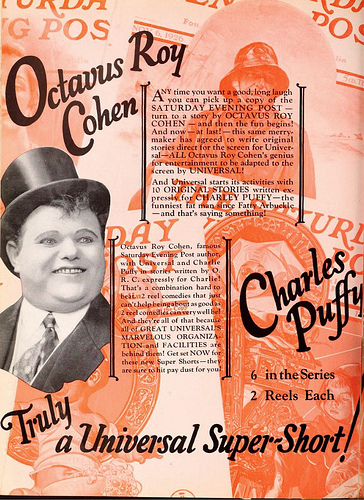
Advertisement 'Octavus Roy Cohen, Charles Puffy, Truly a Universal Super Shot'. Collection: Stonemason@Flickr.
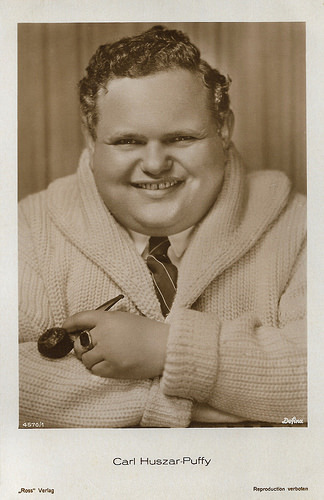
German postcard by Ross Verlag, no. 4570, 1929-1930. Photo: Defina.
Sources: Hans J. Wollstein (AllMovie), Jan-Christopher Horak (Film History), The Missing Link, Wikipedia (German and English) and .

German postcard by Ross Verlag, no. 1207/1, 1927-1928. Photo: Roman Freulich / Unfilman (Universal).
290 pounds
Károly Huszár or Charles Puffy was born as Károly Hochstadt (according to some sources: Hochstein) in Budapest, Austria-Hungary (now Hungary) in 1884.
At 16, the still thin Hochstadt became the long distance swimming champion of Germany. He studied acting at the Országos Színészegyesület Színészképző Iskoláját (National Actor Association's Actor Training School).
Then he worked 16 years on stage in Budapest, where he became a star of the cabarets, and also wrote some comedies.
He started his film career as Károly Huszár in such silent shorts as Víg egyveleg, avagy Pufi és társai/Merry Pompi, or Pufi and his companions (Kornél Tábori, 1914) and Pufi cipöt vesz/Puffy buys shoes (Kornél Tábori, 1914).
In these films he played a character called 'Pufi'. It became his nickname and stage name. ‘Pufi’ means ‘Fatty’ in Hungarian and indeed the thin swimming champion had a legendary appetite and had gained quite some pounds. In his prime Pufi weighted ca. 290 pounds.
In 1917 he worked with director Michael Curtiz (then still Mihály Kertész) at Tavasz a télben/Spring in Winter (1917), and Az Ezredes/The Colonel (1917) with the young Béla Lugosi . That year he also worked with another famous director-to-be, Alexander Korda (as Korda Sándor), at Szent Péter esernyöje/St. Peter's Umbrella (1917) with Victor Varconi .
In 1920 he made his first film in Germany, Putschliesel (Erich Schönfelder, 1920) featuring Ossi Oswalda . He was featured as Karl Huszar-Puffy.
The next year, such films followed as Der Mord ohne Täter/The murder without offender (Ewald André Dupont, 1921), the serial Der Mann ohne Namen/The Man Without a Name (Georg Jacoby, 1921) featuring Harry Liedtke , and Der Roman eines Dienstmädchens/The Novel of a Handmaid (Reinhold Schünzel, 1921) with Liane Haid .
That year, he worked twice with director Friedrich Zelnik (later Fredric Zenik) and his star-producer Lya Mara , on Miss Beryll... die Laune eines Millionärs/Miss Beryll, the mood of a millionaire (Friedrich Zelnik, 1921) and on Aus den Memoiren einer Filmschauspielerin/From the memoirs of a film actress (Friedrich Zelnik, 1921).
However, the most famous director he worked with that year was Fritz Lang. Puffy appeared as the emperor of China in the fantasy Der müde Tod/Destiny (Fritz Lang, 1921).

Béla Lugosi . Hungarian postcard. Photo: Angelo, Budapest. Collection: Didier Hanson.

Vintage postcard by Verlag Hartiq, no. 576. Photo by Hartiq. Collection: Didier Hanson.
Charles Puffy
In 1922 Károly Huszár made his American debut in Arctic Adventure (Chester Withey, 1922). That year he also had a part in Fritz Lang’s classic crime thriller Dr. Mabuse, der Spieler - Ein Bild der Zeit/Dr. Mabuse: The Gambler (1922) starring Rudolf Klein-Rogge as arch-criminal Dr. Mabuse. He also appeared opposite film legend Henny Porten in Sie und die Drei/She and the Three (Ewald André Dupont, 1922).
In 1923, Universal offered him a contract to make a series of comedy shorts in Hollywood under the name Charles Puffy. He starred in some 26 shorts between 1924 and 1927 including City Bound (Richard Smith, 1925), Unwelcome (Richard Smith, 1925) and Ah! Gay Vienna! (Harry Sweet, 1927).
He also appeared in minor roles in such feature films as Open All Night (Paul Bern, 1924) starring Viola Dana and Jetta Goudal , the melodramas The Rose of Paris (Irving Cummings, 1924) featuring Mary Philbin as a poor French orphan, and The Love Thief (John McDermott, 1926).
In Hollywood, Puffy also worked with several European directors. He played supporting parts in Benjamin Christensen’s melodrama Mockery (1927) starring Lon Chaney , in Ewald André Dupont’s comedy Love Me and the World Is Mine (1927) and in Alexander Korda’s comedy The Private Life of Helen of Troy (1927).
One of his most interesting Hollywood films is The Man Who Laughs (1928) directed by the German Expressionist filmmaker Paul Leni. The film is an adaptation of Victor Hugo's novel of the same name and stars Conrad Veidt as Gwynplaine and Mary Philbin as the blind Dea. Universal put over $1,000,000 into The Man Who Laughs, an extremely high budget for an American film at the time.

German collectors card by Ross Verlag in the series Vom Werden deutscher Filmkunst - Der Stumme Film, picture no. 94, group 40. Photo: Ufa. Publicity still with Károly Huszár (left) and Rudolf Klein-Rogge (second from left) in Dr. Mabuse, der Spieler/Dr. Mabuse, King of Crime (Fritz Lang, 1922). Caption: Dr. Mabuse, who prints false money, lets the false notes sort by blind people who can not betray him.

Conrad Veidt . German postcard by Ross Verlag, Berlin, nr. 1426/2, 1927-1928. Photo: Vaida M. Pál, Budapest.
Holocaust
At the time of the introduction of the sound film, Károly Huszár returned to Germany. He appeared twice in minor roles opposite Marlene Dietrich , in Ich küsse Ihre Hand, Madame/I Kiss Your Hand Madame (Robert Land, 1929), and in her breakthrough film Der blaue Engel/The Blue Angel (Josef von Sternberg, 1930) in which Puffy played the club owner.
After several of such bit roles Puffy played a leading part in the comedy Der nächtse Bitte/Next please (Erich Schönfelder, 1930) opposite Adele Sandrock . However, the following years he was seen only in supporting parts.
Károly Huszár reunited with Alexander Korda for Die Männer um Lucie/The Men around Lucie (Alexander Korda, 1931) with Liane Haid.
In 1933, after the Nazis came to power, he returned to Hungary, where he continued to play supporting parts. Among these Hungarian films are Pardon, tévedtem/Romance in Budapest (Steve Sekely, Géza von Bolváry, 1933) with Franziska Gaál and Paul Hörbiger , Helyet az öregeknek/Room for the Aged (Béla Gaál, 1934) with Szõke Szakáll , and Kleine Mutti/Little Mother (Hermann Kosterlitz a.k.a. Henry Koster, 1935) featuring Franziska Gaál .
His final Hungarian film was Nehéz apának lenni/It's Hard to be a Dad (Márton Keleti, 1938).
Károly Huszár’s death place and date are still unconfirmed. Puffy was Jewish, and decided to flee Hungary when the Holocaust started. About what then happened the sources differ.
A source mentions that Károly Huszár and his wife tried to get into the United States in 1941. Some sources say that he died in Tokyo, Japan in 1942. Others that his train was stopped by the Soviet army and he was imprisoned in a Gulag labour camp in Karaganda, Kazakhstan where he performed in the camp theatre company. Reportedly he died there from diphtheria in 1943, but other sources say he and his wife died of starvation.

Advertisement 'Octavus Roy Cohen, Charles Puffy, Truly a Universal Super Shot'. Collection: Stonemason@Flickr.

German postcard by Ross Verlag, no. 4570, 1929-1930. Photo: Defina.
Sources: Hans J. Wollstein (AllMovie), Jan-Christopher Horak (Film History), The Missing Link, Wikipedia (German and English) and .
Published on May 21, 2018 22:00
May 20, 2018
Nina & Frederik
The Danish couple Frederik (1932-1994) and Nina van Pallandt (1932) were as Nina & Frederik a famous singing duo in the late 1950s and the 1960s. They had many international hits and also acted in several films together. After the couple split up in 1969, Nina had a solo career as a singer and a Hollywood actress. Frederik joined a major Australian crime syndicate, for which he provided transportation for drug trafficking.
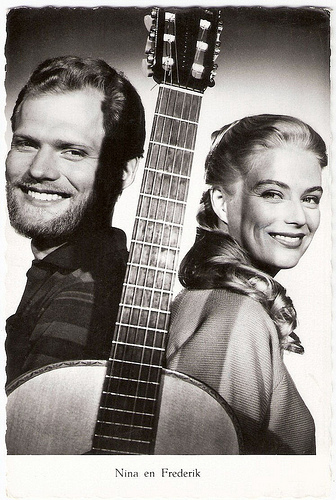
Dutch postcard by C.K.Z., Zeist. Photo: publicity still for the romantic musical Mandolinen und Monschein/Mandolins and Moonlight (Hans Deppe, 1959).
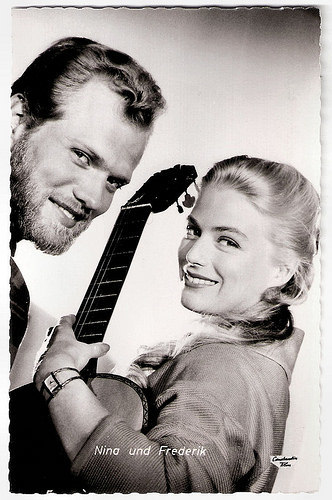
German postcard by Kolibri-Verlag G.m.b.H., Minden/Westf, no. 829. Photo: Arca / Cinepress / Constantin. Publicity still for Mandolinen und Mondschein/Mandolins and moonlight (Hans Deppe, 1959).
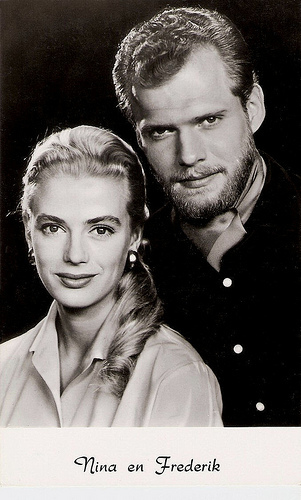
Dutch postcard by Gebr. Spanjersberg N.V., Rotterdam, no. 5655.
Baron Frederik
Frederik, Baron van Pallandt was born in 1932 in Copenhagen, Danmark. He was the son of the Dutch ambassador in Denmark at the time. He met Nina Magdalene Möller (born in 1932, in Hellerup, Danmark) already in 1938, while their families were friends.
Frederik studied agriculture at the University of Trinidad. When he met Nina again in 1957 in Copenhagen they started a duo singing easy listening songs in cabarets. Nina & Frederik performed with growing success in Scandinavia, Western Europe and America.
Nina was married at the time. In1955, she had married Hugo Wessel, the son of Denise Orme and Theodore W. 'Tito' Wessel, a Danish millionaire and one-time Danish chargé d'affaires in Chile.
In 1958 Nina & Frederik appeared together in a beer commercial, named on IMDb Nina & Frederik Western (Erik Dibbern, 1958), and they made their feature debut in Verdens rigeste pige/The Richest Girl in the World (Lau Lauritzen, Alice O'Fredericks, 1958).
Soon, their first film was followed by Kærlighedens melodi/Formular to Love (Bent Christensen, 1959) and the German Schlager film Mandolinen und Mondschein/Mandolins and Moonlight (Hans Deppe, 1959) starring Christine Görner and Claus Biederstaedt .
In 1959 Nina & Frederik issued their first record, and in 1960 they married. In those years they achieved worldwide popularity with songs like Listen to the Ocean, Mango buy me Mango, Sucu, Sucu, and Little Donkey. They moved effortlessly from folk to calypso to pop to protest songs like Bob Dylan’s Blowin' in the Wind.
They played in famous concert halls, like the London Palladium in 1966. But in 1969 Nina & Frederik separated and in 1975 they divorced.
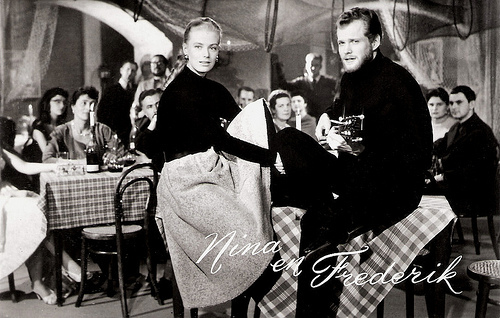
Dutch postcard by Uitg. Takken, Utrecht, no. AX 3988. Photo: Corona. Publicity still for Verdens rigeste pige/The Richest Girl in the World (Lau Lauritzen, Alice O'Fredericks, 1958).
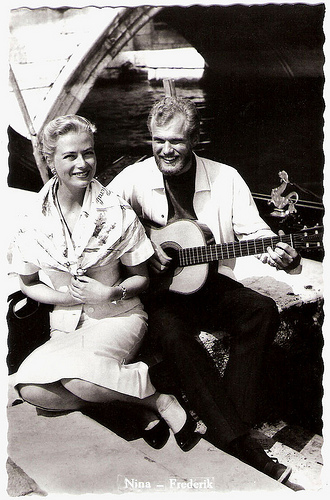
Dutch postcard by C.K.Z., Zeist, no. 232. Photo: publicity still for Mandolinen und Mondschein/Mandolins and Moonlight (Hans Deppe, 1959).
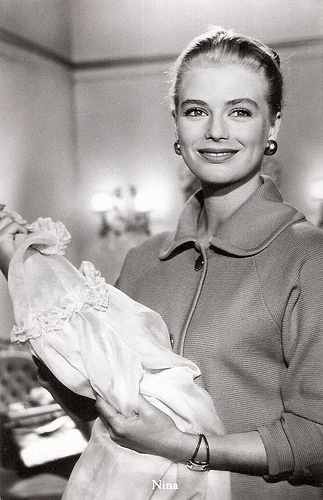
Dutch postcard by Hercules, Haarlem, no. 245. Photo: Gofilex. Publicity still for Mandolinen und Mondschein/Mandolins and Moonlight (Hans Deppe, 1959).
Jet-setter Nina
After their divorce, Nina van Pallandt kept working in show business. In 1969 she contributed the song Do You Know How Christmas Trees Are Grown? to the James Bond-film On Her Majesty's Secret Service (Peter R. Hunt, 1969) starring George Lazenby.
Where Do You Go To (My Lovely) is another 1969 song by Peter Sarstedt. It was a #1 hit in the UK-charts for six weeks in 1969. One theory is that Nina was the mysterious Marie-Claire in the song about a young jet-setter who moved in high circles but was from a lowly origin.
In 1972 Nina became famous in the US as the mistress of hoaxer Clifford Irving, who went to jail when his biography of Howard Hughes, allegedly written with Hughes' co-operation, proved to be a fake. Hughes himself came out of seclusion to repudiate the work. Van Pallandt helped expose Irving's fraud by revealing that he was vacationing with her in Mexico at the time he was allegedly interviewing Hughes.
She appeared, as herself, in Orson Welles ' non-fiction film Vérités et mensonges/F For Fake (1974).
The height of Van Pallandt's film career was her appearance in four films directed by Robert Altman: The Long Goodbye (1973), A Wedding (1978), Quintet (1979), and O.C. and Stiggs (1985).
She also appeared in secondary parts in Cloud Dancer (Barry Brown, 1980) with David Carradine, Cutter's Way (Ivan Passer, 1981) with Jeff Bridges, and the fantasy adventure The Sword and the Sorcerer (Albert Pyun, 1982).
In Europe she played in the German exploitation film Euer Weg führt durch die Hölle/Jungle Warriors (Ernst R. von Theumer, 1984), the Spanish drama Así como habían sido/The Way They Were (Andrés Linares, 1987) with Antonio Banderas , and the Danish road movie Time Out (Jon Bang Carlsen, 1988) with Patricia Arquette.
On TV, she appeared as a guest on several episodes of The Morecambe & Wise Show for BBC television during 1969 and the early 1970s . In 1988, she acted in the Tales of the Unexpected episode A Time to Die (Paul Annett, 1988).
In American Gigolo (1980, Paul Schrader), she worked with Richard Gere, who would later play Clifford Irving in The Hoax (Lasse Hallström, 2006), about Irving's fake autobiography of Howard Hughes. In the film Nina is portrayed by Julie Delpy .
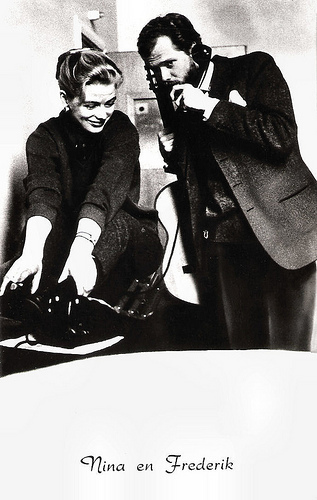
Dutch postcard by Gebr. Spanjersberg N.V., Rotterdam, no. 5449.
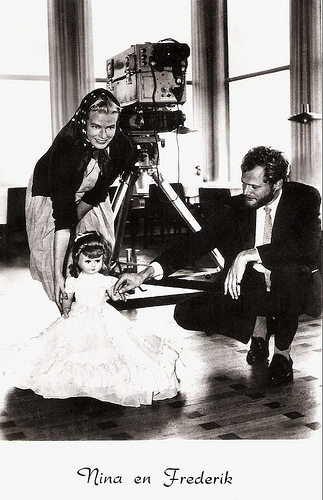
Dutch postcard by Gebr. Spanjersberg N.V., Rotterdam, no. 5655.
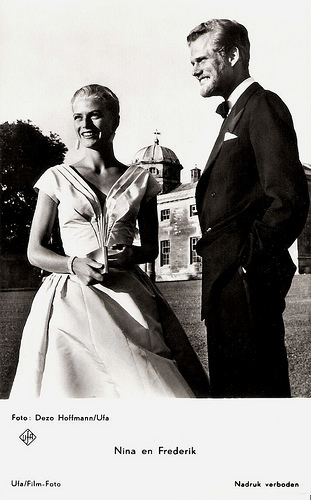
Dutch postcard by DRC, no. 1407. Photo: Dezo Hoffmann / Ufa.
Drug-trafficking Frederik
A year after his divorce from Nina, Frederik van Pallandt married Maria-Jesus de Los Rios Coello de Portugal.
Frederik invested his chart profits in a number of ventures, farming for a while in Ibiza - where Nina was a close neighbour - and in 1984, he bought the copyrights of Burke's Peerage, a publication containing genealogical records of historical families. Burke’s Peerage was then bought by Joseph Goldberg, who reprinted the immediate previous edition.
In the 1990s, he settled in the Philippines. There he became involved with an Australian syndicate involved in the trafficking of cannabis, using his yacht the Tiaping to transport the shipments.
On 15 May 1994, both Frederik and his Filipina girlfriend Susannah were shot dead in a hut at Puerto Galera in the Philippines. Rumours say the murderer was another member of the syndicate.
Nina flew out to the Philippines to bring Frederik's body home to Europe. He was buried near his parents' grave in IJhorst in the Netherlands.
Frederik and Nina had three children: Floris Nicolas Ali, Baron van Pallandt (1961-2006), who worked as a scriptwriter and director for Dutch television, Kirsa Eleonore Clara, Baroness van Pallandt (1963), and Ana Maria Else, Baroness van Pallandt (1965).
Frederik had also a son with his second wife, Daniel Tilopa, Baron van Pallandt (1977).
In the 1970s, Nina van Pallandt married for a third time to Robert Kirby, a South African actor and satirist. The marriage was brief.
Several Nina & Frederik songs from Verdens rigeste pige/The Richest Girl in the World (1958). Source: id4mytube (YouTube).
Nina & Frederick sing Mango vendor in Mandolinen und Mondschein/Mandolins and Moonlight (Hans Deppe, 1959). Source: Alte Film- und Fernsehschätze (YouTube).
Trailer of The Hoax (2006). Source: rocka1969 (YouTube).
Sources: (IMDb), Hal Erickson (AllMovie), Karl Dallas (The Independent), Wikipedia and .

Dutch postcard by C.K.Z., Zeist. Photo: publicity still for the romantic musical Mandolinen und Monschein/Mandolins and Moonlight (Hans Deppe, 1959).

German postcard by Kolibri-Verlag G.m.b.H., Minden/Westf, no. 829. Photo: Arca / Cinepress / Constantin. Publicity still for Mandolinen und Mondschein/Mandolins and moonlight (Hans Deppe, 1959).

Dutch postcard by Gebr. Spanjersberg N.V., Rotterdam, no. 5655.
Baron Frederik
Frederik, Baron van Pallandt was born in 1932 in Copenhagen, Danmark. He was the son of the Dutch ambassador in Denmark at the time. He met Nina Magdalene Möller (born in 1932, in Hellerup, Danmark) already in 1938, while their families were friends.
Frederik studied agriculture at the University of Trinidad. When he met Nina again in 1957 in Copenhagen they started a duo singing easy listening songs in cabarets. Nina & Frederik performed with growing success in Scandinavia, Western Europe and America.
Nina was married at the time. In1955, she had married Hugo Wessel, the son of Denise Orme and Theodore W. 'Tito' Wessel, a Danish millionaire and one-time Danish chargé d'affaires in Chile.
In 1958 Nina & Frederik appeared together in a beer commercial, named on IMDb Nina & Frederik Western (Erik Dibbern, 1958), and they made their feature debut in Verdens rigeste pige/The Richest Girl in the World (Lau Lauritzen, Alice O'Fredericks, 1958).
Soon, their first film was followed by Kærlighedens melodi/Formular to Love (Bent Christensen, 1959) and the German Schlager film Mandolinen und Mondschein/Mandolins and Moonlight (Hans Deppe, 1959) starring Christine Görner and Claus Biederstaedt .
In 1959 Nina & Frederik issued their first record, and in 1960 they married. In those years they achieved worldwide popularity with songs like Listen to the Ocean, Mango buy me Mango, Sucu, Sucu, and Little Donkey. They moved effortlessly from folk to calypso to pop to protest songs like Bob Dylan’s Blowin' in the Wind.
They played in famous concert halls, like the London Palladium in 1966. But in 1969 Nina & Frederik separated and in 1975 they divorced.

Dutch postcard by Uitg. Takken, Utrecht, no. AX 3988. Photo: Corona. Publicity still for Verdens rigeste pige/The Richest Girl in the World (Lau Lauritzen, Alice O'Fredericks, 1958).

Dutch postcard by C.K.Z., Zeist, no. 232. Photo: publicity still for Mandolinen und Mondschein/Mandolins and Moonlight (Hans Deppe, 1959).

Dutch postcard by Hercules, Haarlem, no. 245. Photo: Gofilex. Publicity still for Mandolinen und Mondschein/Mandolins and Moonlight (Hans Deppe, 1959).
Jet-setter Nina
After their divorce, Nina van Pallandt kept working in show business. In 1969 she contributed the song Do You Know How Christmas Trees Are Grown? to the James Bond-film On Her Majesty's Secret Service (Peter R. Hunt, 1969) starring George Lazenby.
Where Do You Go To (My Lovely) is another 1969 song by Peter Sarstedt. It was a #1 hit in the UK-charts for six weeks in 1969. One theory is that Nina was the mysterious Marie-Claire in the song about a young jet-setter who moved in high circles but was from a lowly origin.
In 1972 Nina became famous in the US as the mistress of hoaxer Clifford Irving, who went to jail when his biography of Howard Hughes, allegedly written with Hughes' co-operation, proved to be a fake. Hughes himself came out of seclusion to repudiate the work. Van Pallandt helped expose Irving's fraud by revealing that he was vacationing with her in Mexico at the time he was allegedly interviewing Hughes.
She appeared, as herself, in Orson Welles ' non-fiction film Vérités et mensonges/F For Fake (1974).
The height of Van Pallandt's film career was her appearance in four films directed by Robert Altman: The Long Goodbye (1973), A Wedding (1978), Quintet (1979), and O.C. and Stiggs (1985).
She also appeared in secondary parts in Cloud Dancer (Barry Brown, 1980) with David Carradine, Cutter's Way (Ivan Passer, 1981) with Jeff Bridges, and the fantasy adventure The Sword and the Sorcerer (Albert Pyun, 1982).
In Europe she played in the German exploitation film Euer Weg führt durch die Hölle/Jungle Warriors (Ernst R. von Theumer, 1984), the Spanish drama Así como habían sido/The Way They Were (Andrés Linares, 1987) with Antonio Banderas , and the Danish road movie Time Out (Jon Bang Carlsen, 1988) with Patricia Arquette.
On TV, she appeared as a guest on several episodes of The Morecambe & Wise Show for BBC television during 1969 and the early 1970s . In 1988, she acted in the Tales of the Unexpected episode A Time to Die (Paul Annett, 1988).
In American Gigolo (1980, Paul Schrader), she worked with Richard Gere, who would later play Clifford Irving in The Hoax (Lasse Hallström, 2006), about Irving's fake autobiography of Howard Hughes. In the film Nina is portrayed by Julie Delpy .

Dutch postcard by Gebr. Spanjersberg N.V., Rotterdam, no. 5449.

Dutch postcard by Gebr. Spanjersberg N.V., Rotterdam, no. 5655.

Dutch postcard by DRC, no. 1407. Photo: Dezo Hoffmann / Ufa.
Drug-trafficking Frederik
A year after his divorce from Nina, Frederik van Pallandt married Maria-Jesus de Los Rios Coello de Portugal.
Frederik invested his chart profits in a number of ventures, farming for a while in Ibiza - where Nina was a close neighbour - and in 1984, he bought the copyrights of Burke's Peerage, a publication containing genealogical records of historical families. Burke’s Peerage was then bought by Joseph Goldberg, who reprinted the immediate previous edition.
In the 1990s, he settled in the Philippines. There he became involved with an Australian syndicate involved in the trafficking of cannabis, using his yacht the Tiaping to transport the shipments.
On 15 May 1994, both Frederik and his Filipina girlfriend Susannah were shot dead in a hut at Puerto Galera in the Philippines. Rumours say the murderer was another member of the syndicate.
Nina flew out to the Philippines to bring Frederik's body home to Europe. He was buried near his parents' grave in IJhorst in the Netherlands.
Frederik and Nina had three children: Floris Nicolas Ali, Baron van Pallandt (1961-2006), who worked as a scriptwriter and director for Dutch television, Kirsa Eleonore Clara, Baroness van Pallandt (1963), and Ana Maria Else, Baroness van Pallandt (1965).
Frederik had also a son with his second wife, Daniel Tilopa, Baron van Pallandt (1977).
In the 1970s, Nina van Pallandt married for a third time to Robert Kirby, a South African actor and satirist. The marriage was brief.
Several Nina & Frederik songs from Verdens rigeste pige/The Richest Girl in the World (1958). Source: id4mytube (YouTube).
Nina & Frederick sing Mango vendor in Mandolinen und Mondschein/Mandolins and Moonlight (Hans Deppe, 1959). Source: Alte Film- und Fernsehschätze (YouTube).
Trailer of The Hoax (2006). Source: rocka1969 (YouTube).
Sources: (IMDb), Hal Erickson (AllMovie), Karl Dallas (The Independent), Wikipedia and .
Published on May 20, 2018 22:00
May 19, 2018
Giorgia Moll
During the 1950s and 1960s, beautiful Italian actress and singer Giorgia Moll (1938) could often be seen on television and in the cinema, especially in many Italian B-films. With her pretty face and dream measurements, she became also a popular cover and pin-up model.
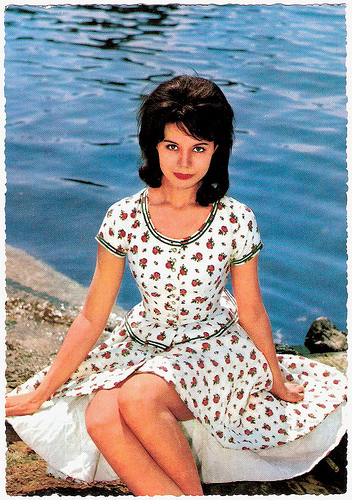
German postcard by Krüger, no. 902/49.
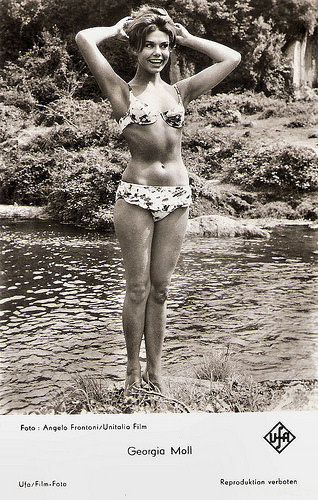
German postcard by Ufa, Berlin-Tempelhof, no. FK 4954. Photo: Angelo Frontoni / Unitalia Film.
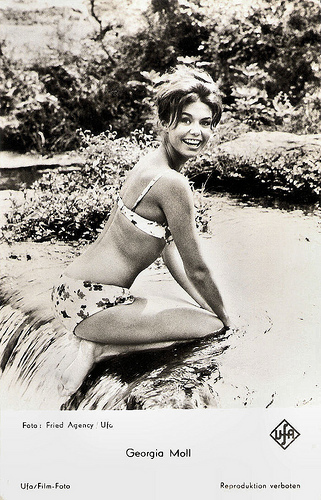
German postcard by Ufa, Berlin-Tempelhof, no. FK 5171. Photo: Fried Agency / Ufa.
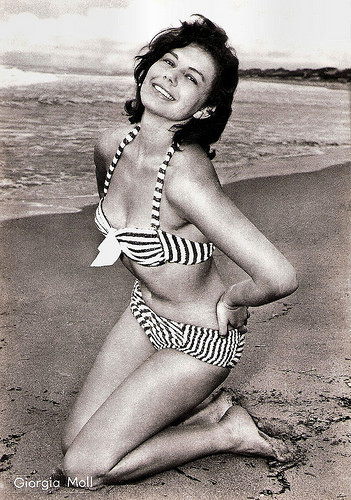
Italian postcard by Bromostampa, Milano, no. 174.
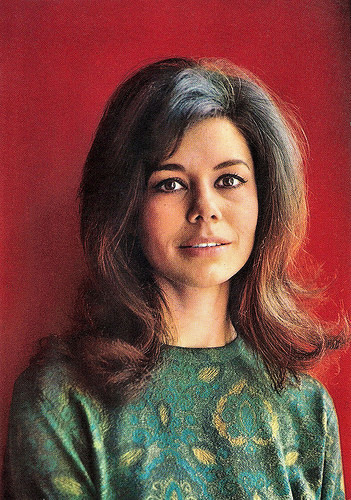
Italian postcard by Rotalfoto, Milano, no. N. 164.
Tempestuous Affair
Giorgia (also Georgia) Moll was born in Prata de Pordenone (some sources say Rome), Italy in 1938 to a German father and an Italian-German mother.
Still very young, she started as a model for advertisements of Carosello reclamizzante, an in Italy well-known toothpaste product. In 1955 she won the beauty contest Miss Cinema.
Producer Carlo Ponti suggested her to take a screentest. Only seventeen, she was hired for her first film, Non scherzare con le donne/Don't Trifle with Women (Giuseppe Bennati, 1955) with Rossana Podestà .
Moll figured in such Italian films as the comedy Lo svitato/Unscrew Him (Carlo Lizzani, 1955) starring Dario Fo, Mio figlio Nerone/My Son Nero (Steno, 1956) with Alberto Sordi and Gloria Swanson , and Mariti in città/Husbands in the City (Luigi Comencini, 1957) opposite Renato Salvatori .
At the time, she was reportedly a girlfriend of Joe Di Maggio, the legendary baseball player and former husband of Marilyn Monroe . Later she had a tempestuous affair with actor John Barrymore Jr., Drew Barrymore’s father.
Most of her films were undistinguished comedies and Peplums, but she did appear in a few well-known productions. Her biggest film was The Quiet American (Joseph L. Mankiewicz, 1958) based on Graham Greene's prophetic novel about U.S. foreign policy failure in pre-war Indochina, and starring American actor and war-hero Audie Murphy.
The film was shot in Cinécitta with some location shooting in Saigon. Moll played Phuong, Murphy's Vietnamese mistress. The part gave her a certain international notoriety. The Quiet American was critically well-received, but was not considered a box office success.
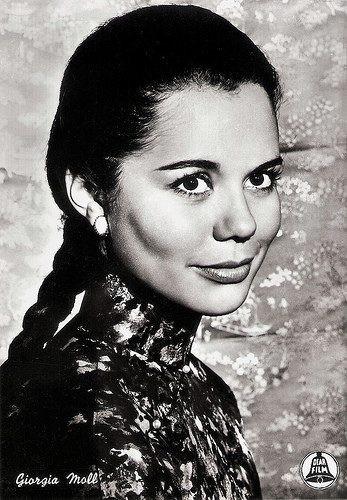
Italian postcard by Bromofoto, Milano, no. 1616. Photo: Dear Film. Publicity still for The Quiet American (Joseph L. Mankiewicz, 1958).
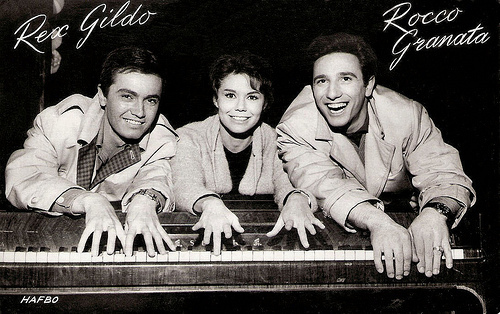
Dutch postcard by Uitg. Takken, Utrecht, no. AX 4687. Photo: Hafbo. Publicity still for the Schlagerfilm Marina (Paul Martin, 1960), which was distributed in Holland as Teenagers Schlager Parade. Moll played the titel character and she poses here between Schlager star Rex Gildo and Rocco Granata , singer of the hit song Marina.
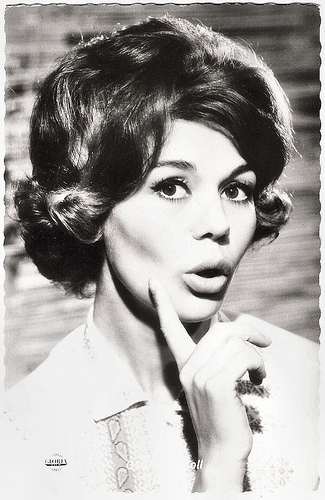
German postcard by Kolibri-Verlag G.m.b.H., Minden/Westf., no. 1357. Photo: Grimm / CCC-film / Gloria. Publicity still for Marina (Paul Martin, 1960).
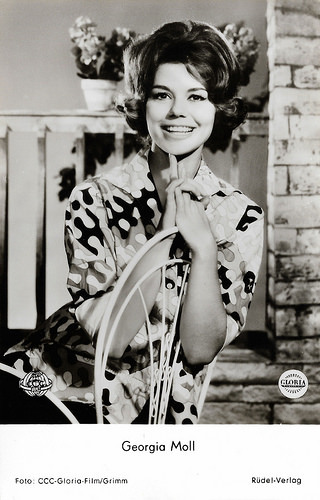
German postcard by Rüdel-Verlag, Hamburg-Bergedorf, no. 3062. Photo: Grimm / CCC-film / Gloria. Publicity still for Marina (Paul Martin, 1960).
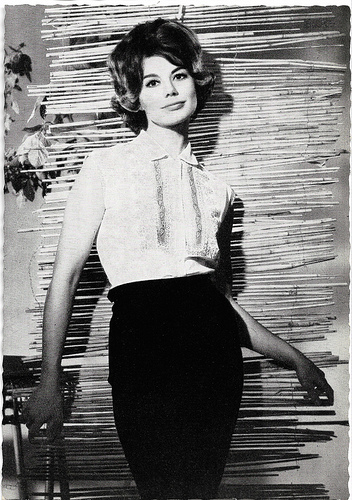
German postcard by Filmvertrieb Ernst Freihoff, Essen, no. 637. Photo: CCC Gloria Film / Grimm. Publicity still for Marina (Paul Martin, 1960).
Unforgettable Tearjerker
Giorgia Moll was critically apprecciated for her dramatic performance in Damiano Damiani's feature debut, the crime drama Il rossetto/Lipstick (1960) with Pierre Brice .
In 1963, she appeared in Jean-Luc Godard’s classic film-about-film Le Mépris/The Contempt (1963), which starred Brigitte Bardot . Moll played Francesca Vanini, the secretary of the authoritarian film producer (Jack Palance), who works as a translator for the film’s protagonist, a script-writer played by Michel Piccoli .
Another classic in which she played a supporting part is the drama Incompresa/Misunderstood (Luigi Comencini, 1967). In this unforgettable tearjerker Anthony Quayle plays a widower who tragically misunderstands his eldest son’s brave front as being unaffected by his mother's death.
During the 1960’s, Georgia Moll also became known as a singer. She recorded some singles, of which Ballata per un amore perduto/Nato in settembre (Ballad for a Lost Love/Born in September, 1964) is best known. Author of the texts of both songs is Piero Ciampi, and the arranger and composer of Nato in settembre is Elvio Monti.
With her harmonious face, her perfect brown hair and her dream measurements, she was also a popular pin-up model in this period, for instance in the magazine Playmen in 1972. After 1970, her appearances became sporadic and she retired from the cinema in 1985.
Her last screen appearances were in the film Tutti dentro/Everybody in Jail (Alberto Sordi, 1984) with Alberto Sordi and Joe Pesci, and the TV film I due prigionieri/The Two Prisoners (Anton Giulio Majano, 1985) with Ray Lovelock and Alain Cuny .
Later, Giorgia Moll became a photographer.
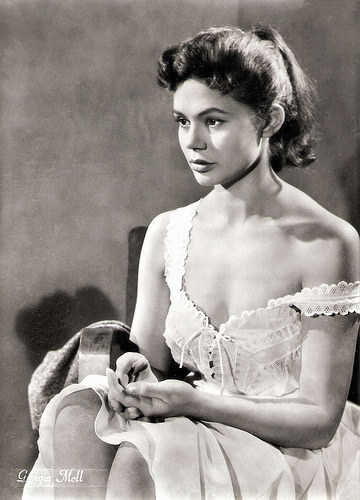
Big Italian card by Bromofoto, Milano. Photo: Günther Wagner / Pelikan.
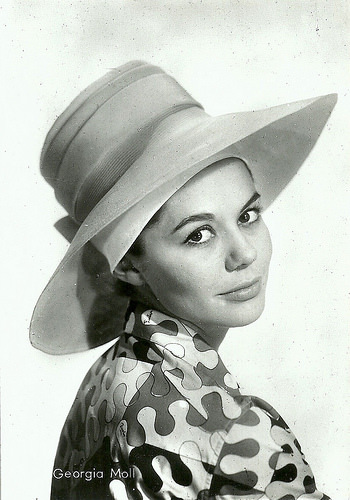
Italian postcard, no. 592.
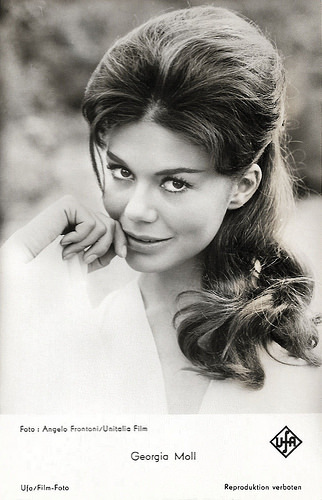
German postcard by Ufa, Berlin-Tempelhof, no. FK 4971. Photo: Angelo Frontoni /Unitalia Film.
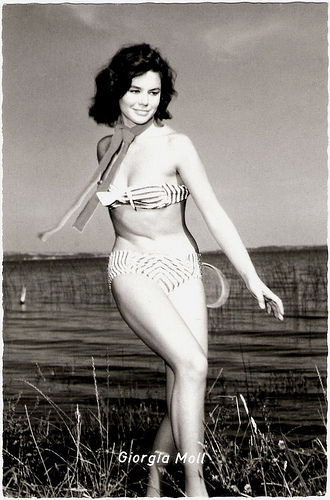
German postcard by Kolibri-Verlag G.m.b.H., Minden/Westf., no. 1666.
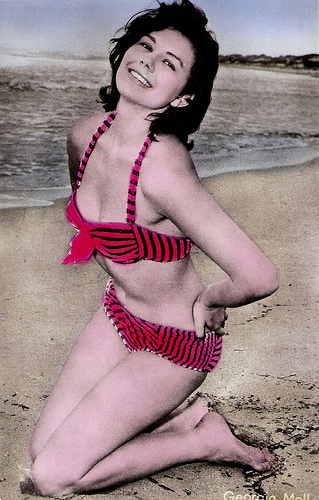
Serbian postcard by Studio Sombor, no. 276.
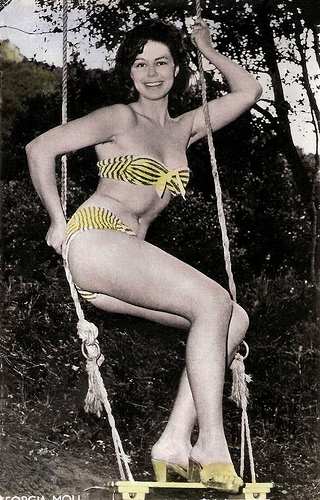
Serbian postcard by Studio Sombor, no. 276. Sent by mail in Yugoslavia in 1965.
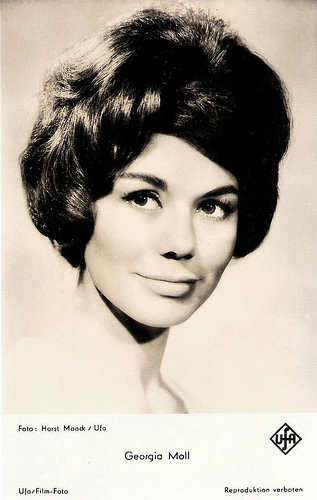
German postcard by Universum-Film Aktiengestellschaft (Ufa), Berlin-Tempelhof, no. FK 4860. Retail price: 25 Pfg. Photo: Horst Maack/Ufa.
Trailer for Le Mépris/The Contempt (1963). Source: The Cultbox (YouTube).
Sources: (IMDb), Glamour Girls of the Silver Screen, Wikipedia (English and Italian) and .

German postcard by Krüger, no. 902/49.

German postcard by Ufa, Berlin-Tempelhof, no. FK 4954. Photo: Angelo Frontoni / Unitalia Film.

German postcard by Ufa, Berlin-Tempelhof, no. FK 5171. Photo: Fried Agency / Ufa.

Italian postcard by Bromostampa, Milano, no. 174.

Italian postcard by Rotalfoto, Milano, no. N. 164.
Tempestuous Affair
Giorgia (also Georgia) Moll was born in Prata de Pordenone (some sources say Rome), Italy in 1938 to a German father and an Italian-German mother.
Still very young, she started as a model for advertisements of Carosello reclamizzante, an in Italy well-known toothpaste product. In 1955 she won the beauty contest Miss Cinema.
Producer Carlo Ponti suggested her to take a screentest. Only seventeen, she was hired for her first film, Non scherzare con le donne/Don't Trifle with Women (Giuseppe Bennati, 1955) with Rossana Podestà .
Moll figured in such Italian films as the comedy Lo svitato/Unscrew Him (Carlo Lizzani, 1955) starring Dario Fo, Mio figlio Nerone/My Son Nero (Steno, 1956) with Alberto Sordi and Gloria Swanson , and Mariti in città/Husbands in the City (Luigi Comencini, 1957) opposite Renato Salvatori .
At the time, she was reportedly a girlfriend of Joe Di Maggio, the legendary baseball player and former husband of Marilyn Monroe . Later she had a tempestuous affair with actor John Barrymore Jr., Drew Barrymore’s father.
Most of her films were undistinguished comedies and Peplums, but she did appear in a few well-known productions. Her biggest film was The Quiet American (Joseph L. Mankiewicz, 1958) based on Graham Greene's prophetic novel about U.S. foreign policy failure in pre-war Indochina, and starring American actor and war-hero Audie Murphy.
The film was shot in Cinécitta with some location shooting in Saigon. Moll played Phuong, Murphy's Vietnamese mistress. The part gave her a certain international notoriety. The Quiet American was critically well-received, but was not considered a box office success.

Italian postcard by Bromofoto, Milano, no. 1616. Photo: Dear Film. Publicity still for The Quiet American (Joseph L. Mankiewicz, 1958).

Dutch postcard by Uitg. Takken, Utrecht, no. AX 4687. Photo: Hafbo. Publicity still for the Schlagerfilm Marina (Paul Martin, 1960), which was distributed in Holland as Teenagers Schlager Parade. Moll played the titel character and she poses here between Schlager star Rex Gildo and Rocco Granata , singer of the hit song Marina.

German postcard by Kolibri-Verlag G.m.b.H., Minden/Westf., no. 1357. Photo: Grimm / CCC-film / Gloria. Publicity still for Marina (Paul Martin, 1960).

German postcard by Rüdel-Verlag, Hamburg-Bergedorf, no. 3062. Photo: Grimm / CCC-film / Gloria. Publicity still for Marina (Paul Martin, 1960).

German postcard by Filmvertrieb Ernst Freihoff, Essen, no. 637. Photo: CCC Gloria Film / Grimm. Publicity still for Marina (Paul Martin, 1960).
Unforgettable Tearjerker
Giorgia Moll was critically apprecciated for her dramatic performance in Damiano Damiani's feature debut, the crime drama Il rossetto/Lipstick (1960) with Pierre Brice .
In 1963, she appeared in Jean-Luc Godard’s classic film-about-film Le Mépris/The Contempt (1963), which starred Brigitte Bardot . Moll played Francesca Vanini, the secretary of the authoritarian film producer (Jack Palance), who works as a translator for the film’s protagonist, a script-writer played by Michel Piccoli .
Another classic in which she played a supporting part is the drama Incompresa/Misunderstood (Luigi Comencini, 1967). In this unforgettable tearjerker Anthony Quayle plays a widower who tragically misunderstands his eldest son’s brave front as being unaffected by his mother's death.
During the 1960’s, Georgia Moll also became known as a singer. She recorded some singles, of which Ballata per un amore perduto/Nato in settembre (Ballad for a Lost Love/Born in September, 1964) is best known. Author of the texts of both songs is Piero Ciampi, and the arranger and composer of Nato in settembre is Elvio Monti.
With her harmonious face, her perfect brown hair and her dream measurements, she was also a popular pin-up model in this period, for instance in the magazine Playmen in 1972. After 1970, her appearances became sporadic and she retired from the cinema in 1985.
Her last screen appearances were in the film Tutti dentro/Everybody in Jail (Alberto Sordi, 1984) with Alberto Sordi and Joe Pesci, and the TV film I due prigionieri/The Two Prisoners (Anton Giulio Majano, 1985) with Ray Lovelock and Alain Cuny .
Later, Giorgia Moll became a photographer.

Big Italian card by Bromofoto, Milano. Photo: Günther Wagner / Pelikan.

Italian postcard, no. 592.

German postcard by Ufa, Berlin-Tempelhof, no. FK 4971. Photo: Angelo Frontoni /Unitalia Film.

German postcard by Kolibri-Verlag G.m.b.H., Minden/Westf., no. 1666.

Serbian postcard by Studio Sombor, no. 276.

Serbian postcard by Studio Sombor, no. 276. Sent by mail in Yugoslavia in 1965.

German postcard by Universum-Film Aktiengestellschaft (Ufa), Berlin-Tempelhof, no. FK 4860. Retail price: 25 Pfg. Photo: Horst Maack/Ufa.
Trailer for Le Mépris/The Contempt (1963). Source: The Cultbox (YouTube).
Sources: (IMDb), Glamour Girls of the Silver Screen, Wikipedia (English and Italian) and .
Published on May 19, 2018 22:00
May 18, 2018
Barbara Rütting
German film actress and author Barbara Rütting (1927) appeared in 45 films between 1952 and 1983. Later she became a well known human rights and animal welfare activist.
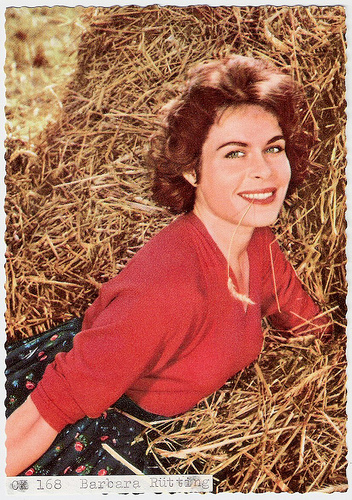
German postcard by UFA (Universum-Film Aktiengesellschaft), Berlin-Tempelhof, no. CK-168. Retail price: 30 Pfg. Photo: Klaus Collignon / UFA.
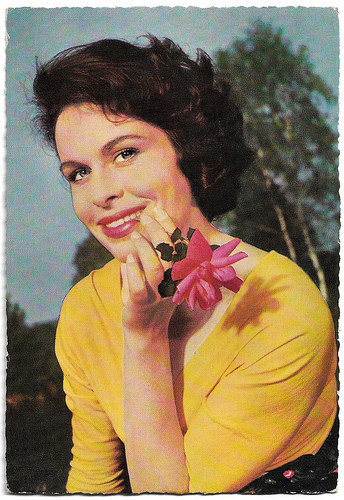
German postcard by WS-Druck, Wanne-Eickel, no F 16. Photo: Klaus Collignon.
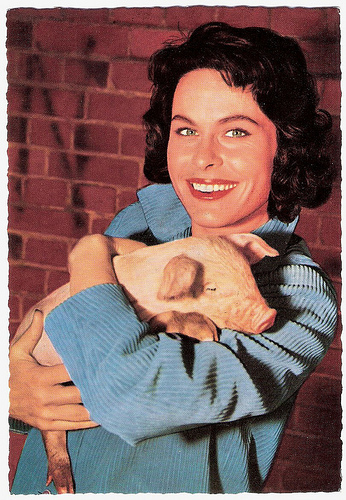
German postcard by WS-Druck, Wanne-Eickel, no. F 115. Photo: Ringpress / Vogelmann / Bavaria.
Best Newcomer
Barbara Rütting was born as Waltraut Irmgard Goltz in Ludwigsfelde-Wietstock, Germany in 1927. She was one of the five children of Johanna and Richard Goltz, who were both teachers.
After her graduation in 1945, she fled to Denmark, where she worked first as a servant and later in a library and as a foreign correspondent. In 1946 she married Hans Rütting.
In 1952 she made her stage debut in the city of Krefeld in Die Tochter des Brunnenmachers (The Daughter of the Well Maker). Many stage roles in theatres all over Germany followed.
That year she also made her first film appearance as the female lead in the comedy Postlagernd Turteltaube/Poste restante turtledove (Gerhard T. Buchholz, 1952). Next she played a Russian soldier in Die Spur führt nach Berlin/International Counterfeiters (Frantisek Cáp, 1952). For this role she was awarded with the Bundesfilmpreis for Best Newcomer.
In the following decade, she played leading roles in such films as the war drama Die letzte Brücke/The Last Bridge (Helmut Käutner, 1954) with Maria Schell , the biographical drama Canaris (Alfred Weidenmann, 1954) opposite O.E. Hasse as the chief of the intelligence service of Nazi Germany, the Heimatfilm Die Geierwally (Frantisek Cáp, 1954) with Carl Möhner , and the crime film Herz ohne Gnade/Heart Without Pity (Viktor Tourjansky, 1958) with Hansjörg Felmy .
Rütting also appeared in foreign films, such as A Time to Love and a Time to Die (Douglas Sirk, 1958) based on the novel by Erich Maria Remarque and starring John Gavin.
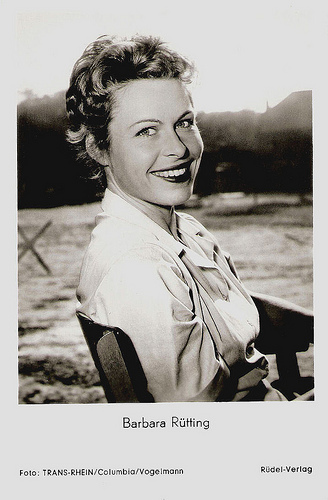
German postcard by Rüdel-Verlag, Hamburg-Bergedorf, no. 1215. Photo: TRANS-RHEIN / Columbia / Vogelmann. Publicity still for Das Zweite Leben/A Double Life (Victor Vicas, 1954).
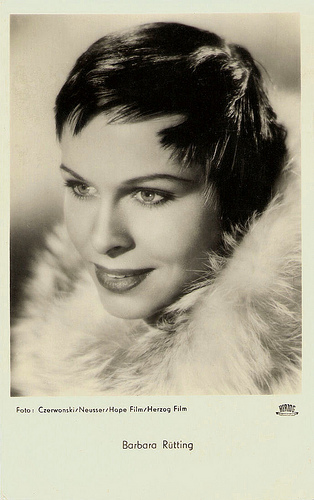
French postcard by Editions P.I., Paris, no. 18H. Photo: Czerwonski / Neusser / Hope Film / Herzog Film. Publicity still for Spionage/Espionage (Franz Antel, 1955).
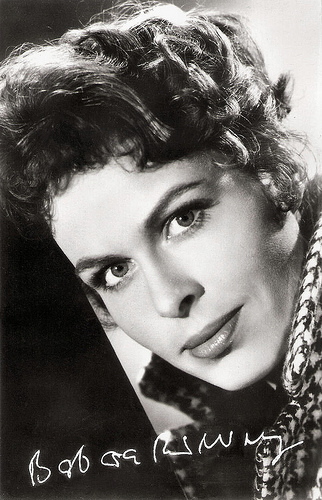
East-German postcard by VEB Progress Film-Vertrieb, no. P 24/480, 1957. Photo: Michaelis / Real-Film. Publicity still for Glücksritter/A Modern Story (Arthur Maria Rabenalt, 1957).
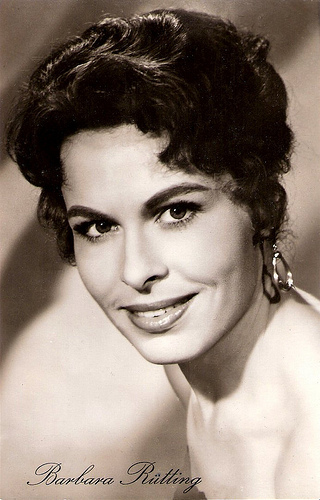
East-German postcard by VEB Progress Filmvertrieb, Berlin, no. P 76/479, 1958. Retail price: 0,20 DM. Photo: Real Film / Michaelis. Publicity still for Glücksritter/A Modern Story (Arthur Maria Rabenalt, 1957).
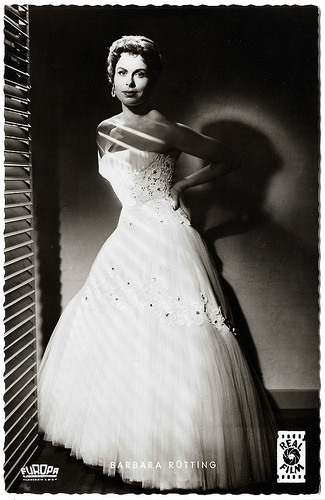
German postcard by Kunst und Bild, Berlin, no. S 726. Photo: Michaelis / Real-Film / Europa. Publicity still for Glücksritter/A Modern Story (Arthur Maria Rabenalt, 1957).
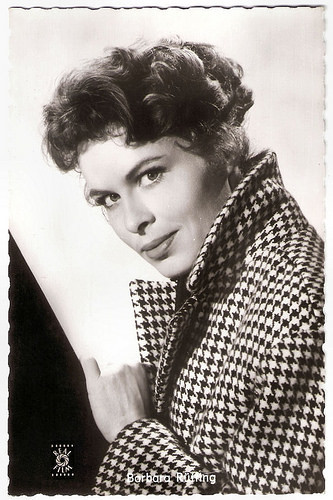
German postcard by Kolibri-Verlag, Minden/Westf. Photo: Real Film. Publicity still for Glücksritter/A Modern Story (Arthur Maria Rabenalt, 1957).
Edgar Wallace Krimis
Barbara Rütting played the female lead opposite Kirk Douglas in Town Without Pity (Gottfried Reinhardt, 1961), a hard hitting, depressing and brutal courtroom drama about the rape of a 16-year old girl ( Christine Kaufmann ).
At IMDb , Michael Elliott writes that there was a lot of controversy around the film at the time: “United Artists put a warning on the film and asked theater owners not to let anyone under 17 into the film. Several theater owners wouldn't even show the film due to its subject matter. I think all of this controversy hurt the film when it was released but I think it's about time film buffs and film historians go back and take a look at this film and include it with the greatest courtroom films out there. This film still manages to shock and be outrageous nearly forty-five years after being released.”
Rütting appeared with Martin Held in the romantic comedy Liebe will gelernt sein/Love wants to be learned (Kurt Hoffmann, 1963), based on a play by Erich Kästner.
She played in such Edgar Wallace krimis as Der Zinker/The Squeaker (Alfred Vohrer, 1963) with Heinz Drache, and Das Phantom von Soho/Murder by Proxy (Franz Josef Gottlieb, 1964) with Dieter Borsche .
Rütting also had a supporting part in the war drama Operation Crossbow (Michael Anderson, 1965) starring Sophia Loren .
When the German cinema got in a deep crisis, Rütting appeared more and more on TV. She guest starred in such popular krimi series as Der Kommissar/The Commissioner (1975), Der Alte/The Old Fox (1980) and Derrick (1981).
In the meanwhile she also was active as an author and since her debut novel Die maßlose Zärtlichkeit (1970, The immoderate tenderness), she wrote several successful children's and (vegetarian) cook books.
In 1983 she retired from acting and since then she became a well known human rights and animal welfare activist. She organised help projects and taught cooking in hospitals for victims of the Chernobyl disaster.
In 2003, she was elected into the Landtag (state parliament) of Bavaria for the Green Party. In 2008 she left both the Landtag and the Green party.
Barbara Rütting was married to Hans Rütting (1946-1951) and to count Heinrich von Einsiedel (1955-1964). Both marriages ended in a divorce. Between 1969 and 1988 her partner was Lutz Hochstraate.
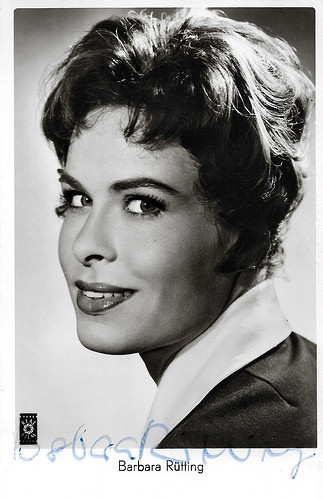
German postcard by Franz Josef Rüdel, Filmpostkartenverlag, Hamburg-Bergedorf. Photo: Real-Film / NF / Gabriele.
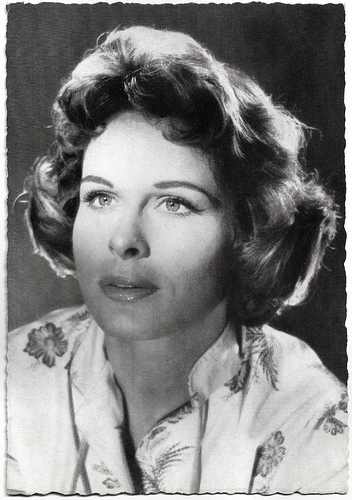
German postcard by WS-Druck, Wanne-Eickel, no. 308. Photo: Rapid / Union / Reiter.
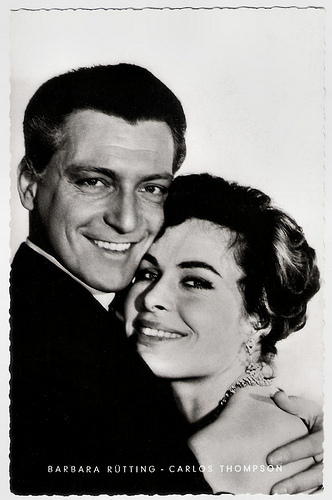
German postcard by Kunst und Bild, Berlin-Charlottenburg, no. A 1544. Photo: Deutsche Cosmopol Film / Haenchen. Publicity still for Ich war ihm hörig/I Was All His (Wolfgang Becker, 1958) with Carlos Thompson .
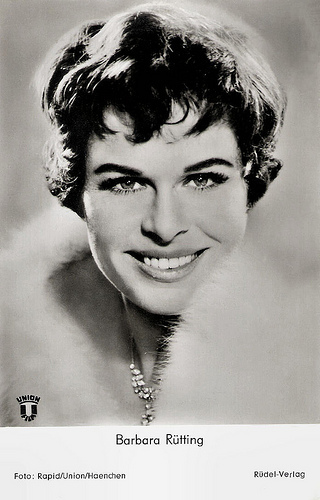
German postcard by Rüdel-Verlag, Hamburg-Bergedorf, no. 2632. Photo: Rapid / Union / Haenchen.
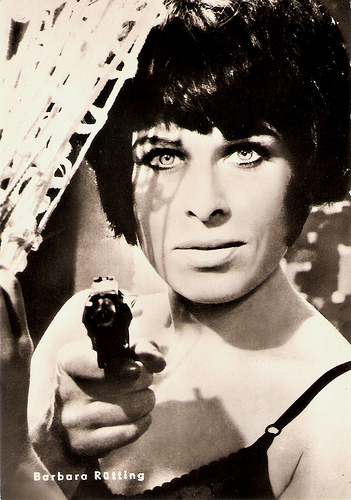
East-German postcard by VEB Progress Film-Vertrieb, Berlin, no. 172/70, 1970. Photo: Progress. Publicity still for Neues vom Hexer/Again the Ringer (Alfred Vohrer, 1965).
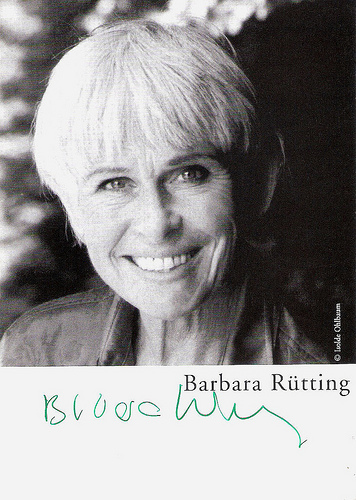
German autograph card by Goldmann Verlag. Photo: Isolde Ohlbaum.
British trailer for Der Zinker/The Squeaker (1963). Source: Rialto Film (YouTube).
Trailer Neues vom Hexer (1965). Source: Rialto Film (YouTube).
Sources: BarbaraRuetting.de (German), Wikipedia (German and English), and .

German postcard by UFA (Universum-Film Aktiengesellschaft), Berlin-Tempelhof, no. CK-168. Retail price: 30 Pfg. Photo: Klaus Collignon / UFA.

German postcard by WS-Druck, Wanne-Eickel, no F 16. Photo: Klaus Collignon.

German postcard by WS-Druck, Wanne-Eickel, no. F 115. Photo: Ringpress / Vogelmann / Bavaria.
Best Newcomer
Barbara Rütting was born as Waltraut Irmgard Goltz in Ludwigsfelde-Wietstock, Germany in 1927. She was one of the five children of Johanna and Richard Goltz, who were both teachers.
After her graduation in 1945, she fled to Denmark, where she worked first as a servant and later in a library and as a foreign correspondent. In 1946 she married Hans Rütting.
In 1952 she made her stage debut in the city of Krefeld in Die Tochter des Brunnenmachers (The Daughter of the Well Maker). Many stage roles in theatres all over Germany followed.
That year she also made her first film appearance as the female lead in the comedy Postlagernd Turteltaube/Poste restante turtledove (Gerhard T. Buchholz, 1952). Next she played a Russian soldier in Die Spur führt nach Berlin/International Counterfeiters (Frantisek Cáp, 1952). For this role she was awarded with the Bundesfilmpreis for Best Newcomer.
In the following decade, she played leading roles in such films as the war drama Die letzte Brücke/The Last Bridge (Helmut Käutner, 1954) with Maria Schell , the biographical drama Canaris (Alfred Weidenmann, 1954) opposite O.E. Hasse as the chief of the intelligence service of Nazi Germany, the Heimatfilm Die Geierwally (Frantisek Cáp, 1954) with Carl Möhner , and the crime film Herz ohne Gnade/Heart Without Pity (Viktor Tourjansky, 1958) with Hansjörg Felmy .
Rütting also appeared in foreign films, such as A Time to Love and a Time to Die (Douglas Sirk, 1958) based on the novel by Erich Maria Remarque and starring John Gavin.

German postcard by Rüdel-Verlag, Hamburg-Bergedorf, no. 1215. Photo: TRANS-RHEIN / Columbia / Vogelmann. Publicity still for Das Zweite Leben/A Double Life (Victor Vicas, 1954).

French postcard by Editions P.I., Paris, no. 18H. Photo: Czerwonski / Neusser / Hope Film / Herzog Film. Publicity still for Spionage/Espionage (Franz Antel, 1955).

East-German postcard by VEB Progress Film-Vertrieb, no. P 24/480, 1957. Photo: Michaelis / Real-Film. Publicity still for Glücksritter/A Modern Story (Arthur Maria Rabenalt, 1957).

East-German postcard by VEB Progress Filmvertrieb, Berlin, no. P 76/479, 1958. Retail price: 0,20 DM. Photo: Real Film / Michaelis. Publicity still for Glücksritter/A Modern Story (Arthur Maria Rabenalt, 1957).

German postcard by Kunst und Bild, Berlin, no. S 726. Photo: Michaelis / Real-Film / Europa. Publicity still for Glücksritter/A Modern Story (Arthur Maria Rabenalt, 1957).

German postcard by Kolibri-Verlag, Minden/Westf. Photo: Real Film. Publicity still for Glücksritter/A Modern Story (Arthur Maria Rabenalt, 1957).
Edgar Wallace Krimis
Barbara Rütting played the female lead opposite Kirk Douglas in Town Without Pity (Gottfried Reinhardt, 1961), a hard hitting, depressing and brutal courtroom drama about the rape of a 16-year old girl ( Christine Kaufmann ).
At IMDb , Michael Elliott writes that there was a lot of controversy around the film at the time: “United Artists put a warning on the film and asked theater owners not to let anyone under 17 into the film. Several theater owners wouldn't even show the film due to its subject matter. I think all of this controversy hurt the film when it was released but I think it's about time film buffs and film historians go back and take a look at this film and include it with the greatest courtroom films out there. This film still manages to shock and be outrageous nearly forty-five years after being released.”
Rütting appeared with Martin Held in the romantic comedy Liebe will gelernt sein/Love wants to be learned (Kurt Hoffmann, 1963), based on a play by Erich Kästner.
She played in such Edgar Wallace krimis as Der Zinker/The Squeaker (Alfred Vohrer, 1963) with Heinz Drache, and Das Phantom von Soho/Murder by Proxy (Franz Josef Gottlieb, 1964) with Dieter Borsche .
Rütting also had a supporting part in the war drama Operation Crossbow (Michael Anderson, 1965) starring Sophia Loren .
When the German cinema got in a deep crisis, Rütting appeared more and more on TV. She guest starred in such popular krimi series as Der Kommissar/The Commissioner (1975), Der Alte/The Old Fox (1980) and Derrick (1981).
In the meanwhile she also was active as an author and since her debut novel Die maßlose Zärtlichkeit (1970, The immoderate tenderness), she wrote several successful children's and (vegetarian) cook books.
In 1983 she retired from acting and since then she became a well known human rights and animal welfare activist. She organised help projects and taught cooking in hospitals for victims of the Chernobyl disaster.
In 2003, she was elected into the Landtag (state parliament) of Bavaria for the Green Party. In 2008 she left both the Landtag and the Green party.
Barbara Rütting was married to Hans Rütting (1946-1951) and to count Heinrich von Einsiedel (1955-1964). Both marriages ended in a divorce. Between 1969 and 1988 her partner was Lutz Hochstraate.

German postcard by Franz Josef Rüdel, Filmpostkartenverlag, Hamburg-Bergedorf. Photo: Real-Film / NF / Gabriele.

German postcard by WS-Druck, Wanne-Eickel, no. 308. Photo: Rapid / Union / Reiter.

German postcard by Kunst und Bild, Berlin-Charlottenburg, no. A 1544. Photo: Deutsche Cosmopol Film / Haenchen. Publicity still for Ich war ihm hörig/I Was All His (Wolfgang Becker, 1958) with Carlos Thompson .

German postcard by Rüdel-Verlag, Hamburg-Bergedorf, no. 2632. Photo: Rapid / Union / Haenchen.

East-German postcard by VEB Progress Film-Vertrieb, Berlin, no. 172/70, 1970. Photo: Progress. Publicity still for Neues vom Hexer/Again the Ringer (Alfred Vohrer, 1965).

German autograph card by Goldmann Verlag. Photo: Isolde Ohlbaum.
British trailer for Der Zinker/The Squeaker (1963). Source: Rialto Film (YouTube).
Trailer Neues vom Hexer (1965). Source: Rialto Film (YouTube).
Sources: BarbaraRuetting.de (German), Wikipedia (German and English), and .
Published on May 18, 2018 22:00
May 17, 2018
Unione Cinematografica Italiana
The Unione Cinematografica Italiana or UCI published postcards of stars and scenes of its Italian silent films of the early 1920s. In 1919, a fusion of most of the existing Italian film companies had been realised by the producers Barattolo and Fassini of Caesar Film and Cines in order to secure the Italians a better international position. The main pre-war companies like Ambrosio, Itala and Gloria had merged in UCI. The initiative to counter the Americans and Germans failed by lack of funding, production facilities and artistic renewal. The bankruptcy of the Banca di Sconto, UCI's main financial backer, in 1921 didn't help too. UCI was mainly a distribution company, not a production company. In 1926 it went bankrupt and its malfortune and final demise marginalised Italian silent film production.

Lucy di San Germano . Italian postcard by Unione Cinematografica Italiana / Ed. G. Vettori, Bologna, no. 13, 1058.

Francesca Bertini . Italian postcard by Unione Cinematografica Italiana / La Rotofotografica, no. 44.
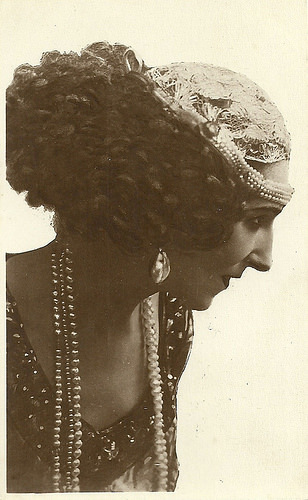
Italian postcard by Unione Cinematografica Italiana. Photo: publicity still for La nave/The Ship (Gabriellino D'Annunzio, Mario Roncoroni, 1921), starring the Russian dancer and actress Ida Rubinstein . La nave was based on the homonymous play by Gabriele D'Annunzio.
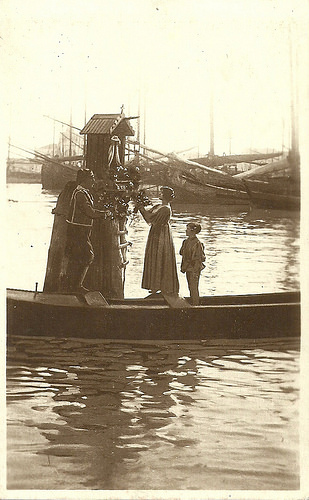
Italian postcard by Unione Cinematografica Italiana. Photo: publicity still for Il ponte dei sospiri/The Bridge of Sighs (Domenico Gaido, 1921). Caption: Juana, Scalabrino's adopted daughter, performs a sweet pilgrimage to the Madonna to protect Rolando. The four-part serial Il ponte dei sospiri, starring Luciano Albertini, Antonietta Calderari, Garaveo Onorato and Carolina White, was set in Venice. The actress pictured is Magda Chirotti, who played Juana.
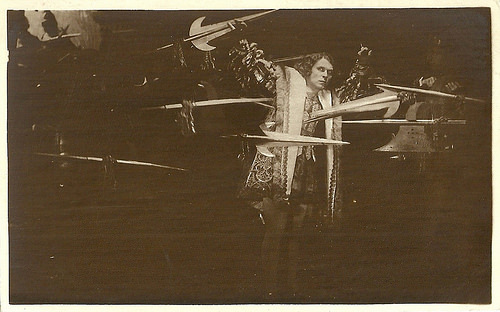
Italian postcard by Unione Cinematografica Italiana. Photo: publicity still for Il ponte dei sospiri (Domenico Gaido, 1921) with Luciano Albertini as Rolando. Caption: The young and very brave son of Doge Candiano, Rolando, is pushed into prison by halberds.
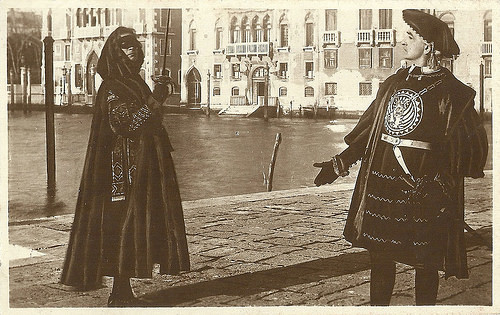
Italian postcard by Unione Cinematografica Italiana. Photo: publicity still for Il ponte dei sospiri (Domenico Gaido, 1921). Caption: Altieri stops Dandolo for a duel. Luigi Stinchi as Altieri, one of the conspirators, and Bonaventura Ibanez as Dandolo, Leonora's father.
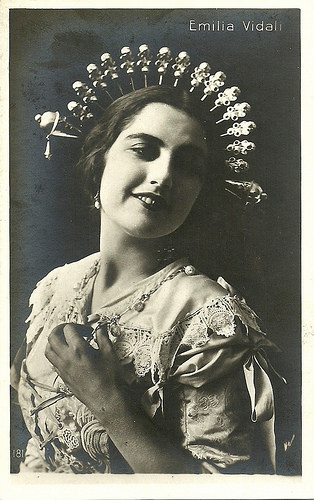
Italian postcard by Unione Cinematografica Italiana / G. Vettori, Bologna, no. 181. Photo: publicity still for I promessi sposi (Mario Bonnard, 1922). Emilia Vidali played the female lead of Lucia in Mario Bonnard's adaptation of Alessandro Manzoni's I promessi sposi/The Betrothed (1922), opposite Domenico Serra as Renzo and Mario Parpagnoli as don Rodrigo.
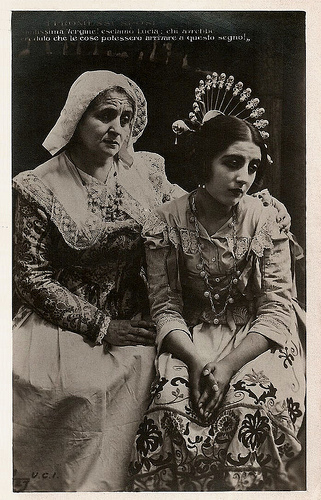
Italian postcard by Unione Cinematografica Italiana / G. Vettori, Bologna. Emilia Vidali (Lucia) and Ida Carloni Talli (Agnese) in I promessi sposi (Mario Bonnard 1922).
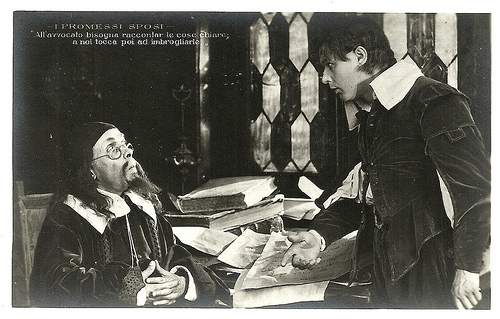
Italian postcard by Unione Cinematografica Italiana / G. Vettori, Bologna. Publicity still for I promessi sposi (Mario Bonnard, 1922). Renzo ( Domenico Serra ) at the lying and cheating lawyer Azzeccagarbugli. Caption: To the lawyer we need to set things straight, so that we can mess them up.
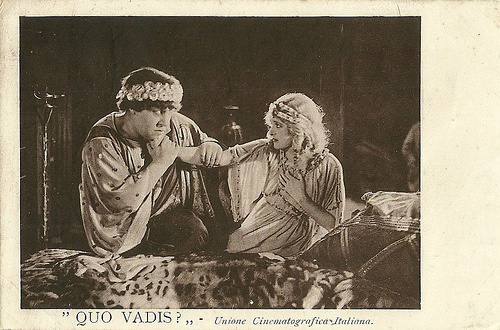
Italian postcard by Unione Cinematografica Italiana. Photo: publicity still for Quo Vadis? (Gabriellino D'Annunzio, Georg Jacoby, 1925). This German-Italian epic was one of the many adaptations of the classic novel by Henryk Sienkiewicz, and starring Emil Jannings as Nero, Elena Sangro as Poppea, Alphons Fryland as Vinicius and Lilian Hall-Davis as Licia. Here we see Nero menacing Licia, after having 'saved her from the clutches of Vinicius'.
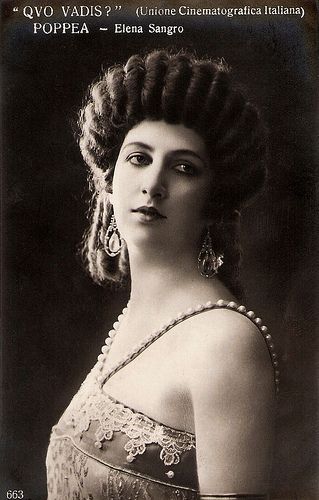
Italian postcard by Unione Cinematografica Italiana / Ed. A. Traldi, Milano, no. 663. Elena Sangro as the Empress Poppea in Quo vadis? (Gabriellino D'Annunzio, Georg Jacoby, 1925).
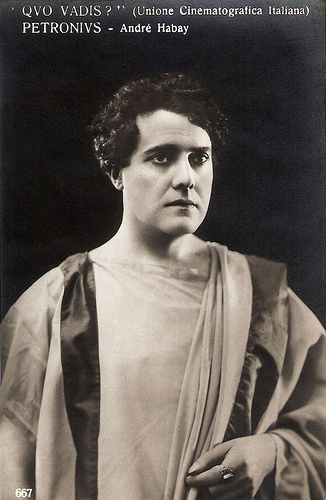
Italian postcard by Unione Cinematografica Italiana / Ed. A. Traldi, Milano, no. 667. Photo: André Habay as Petronius in Quo Vadis? (Gabriellino D'Annunzio, Georg Jacoby, 1925).

Lucy di San Germano . Italian postcard by Unione Cinematografica Italiana / Ed. G. Vettori, Bologna, no. 13, 1058.

Francesca Bertini . Italian postcard by Unione Cinematografica Italiana / La Rotofotografica, no. 44.

Italian postcard by Unione Cinematografica Italiana. Photo: publicity still for La nave/The Ship (Gabriellino D'Annunzio, Mario Roncoroni, 1921), starring the Russian dancer and actress Ida Rubinstein . La nave was based on the homonymous play by Gabriele D'Annunzio.

Italian postcard by Unione Cinematografica Italiana. Photo: publicity still for Il ponte dei sospiri/The Bridge of Sighs (Domenico Gaido, 1921). Caption: Juana, Scalabrino's adopted daughter, performs a sweet pilgrimage to the Madonna to protect Rolando. The four-part serial Il ponte dei sospiri, starring Luciano Albertini, Antonietta Calderari, Garaveo Onorato and Carolina White, was set in Venice. The actress pictured is Magda Chirotti, who played Juana.

Italian postcard by Unione Cinematografica Italiana. Photo: publicity still for Il ponte dei sospiri (Domenico Gaido, 1921) with Luciano Albertini as Rolando. Caption: The young and very brave son of Doge Candiano, Rolando, is pushed into prison by halberds.

Italian postcard by Unione Cinematografica Italiana. Photo: publicity still for Il ponte dei sospiri (Domenico Gaido, 1921). Caption: Altieri stops Dandolo for a duel. Luigi Stinchi as Altieri, one of the conspirators, and Bonaventura Ibanez as Dandolo, Leonora's father.

Italian postcard by Unione Cinematografica Italiana / G. Vettori, Bologna, no. 181. Photo: publicity still for I promessi sposi (Mario Bonnard, 1922). Emilia Vidali played the female lead of Lucia in Mario Bonnard's adaptation of Alessandro Manzoni's I promessi sposi/The Betrothed (1922), opposite Domenico Serra as Renzo and Mario Parpagnoli as don Rodrigo.

Italian postcard by Unione Cinematografica Italiana / G. Vettori, Bologna. Emilia Vidali (Lucia) and Ida Carloni Talli (Agnese) in I promessi sposi (Mario Bonnard 1922).

Italian postcard by Unione Cinematografica Italiana / G. Vettori, Bologna. Publicity still for I promessi sposi (Mario Bonnard, 1922). Renzo ( Domenico Serra ) at the lying and cheating lawyer Azzeccagarbugli. Caption: To the lawyer we need to set things straight, so that we can mess them up.

Italian postcard by Unione Cinematografica Italiana. Photo: publicity still for Quo Vadis? (Gabriellino D'Annunzio, Georg Jacoby, 1925). This German-Italian epic was one of the many adaptations of the classic novel by Henryk Sienkiewicz, and starring Emil Jannings as Nero, Elena Sangro as Poppea, Alphons Fryland as Vinicius and Lilian Hall-Davis as Licia. Here we see Nero menacing Licia, after having 'saved her from the clutches of Vinicius'.

Italian postcard by Unione Cinematografica Italiana / Ed. A. Traldi, Milano, no. 663. Elena Sangro as the Empress Poppea in Quo vadis? (Gabriellino D'Annunzio, Georg Jacoby, 1925).

Italian postcard by Unione Cinematografica Italiana / Ed. A. Traldi, Milano, no. 667. Photo: André Habay as Petronius in Quo Vadis? (Gabriellino D'Annunzio, Georg Jacoby, 1925).
Published on May 17, 2018 22:00
May 16, 2018
Gustav Fröhlich
Smart German actor Gustav Fröhlich (1902-1987) played Freder Fredersen, the young hero in Fritz Lang's silent classic Metropolis (1927). During the 1930s he became the fresh-faced gentleman in light comedies and musicals, and was one of the four most popular male stars of the German cinema during the Third Reich (with Willy Fritsch, Hans Albers and Heinz Rühmann). After the war he tried to escape from his standard roles as the charming gentleman playing a doomed painter in Die Sünderin (1951), but his effort went down in a scandal.
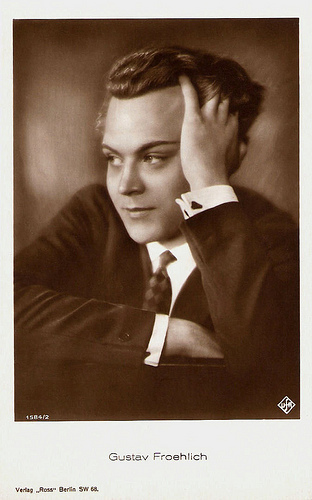
German postcard by Ross Verlag, no. 1584/2, 1927-1938. Photo: Ufa.
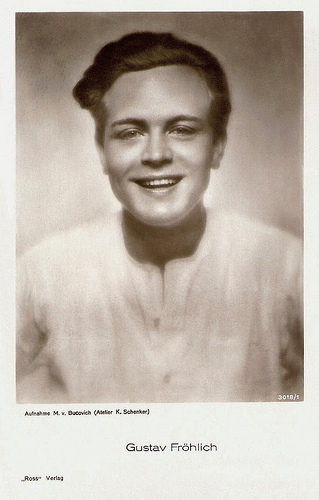
German postcard by Ross Verlag, no. 3018/1, 1928-1929. Photo: M. v. Bucovich (Atelier K. Schenker).
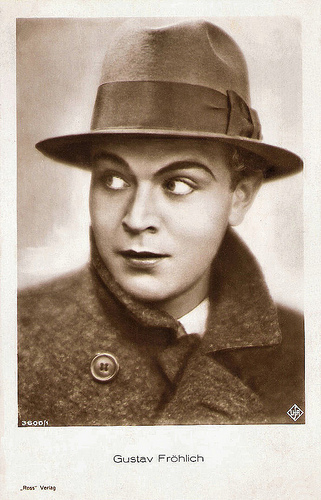
German postcard by Ross Verlag, no. 3600/1, 1928-1929. Photo: Ufa.
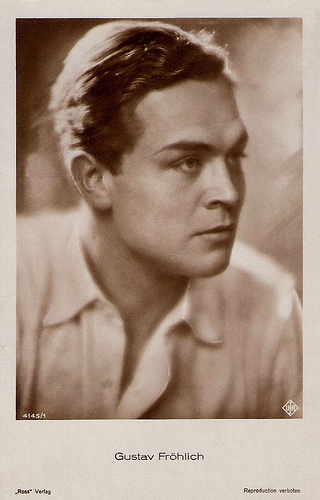
German postcard by Ross Verlag, no. 4145/1, 1929-1930. Photo: Ufa.
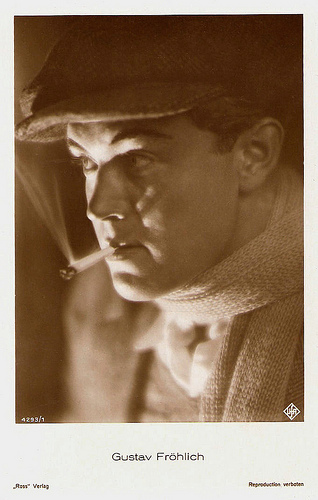
German postcard by Ross Verlag, no. 4293/1, 1929-1930. Photo: Ufa.
Metropolis
Gustav Friedrich Fröhlich was born an illegitimate child in Hannover, Germany in 1902. His father, Gustav König, was a well-known engineer, and his mother Hedwig Therese Sophie Fröhlich, the daughter of a worker. Gustav was raised by foster parents. His foster family moved around western Germany a lot while he was growing up, living in cities like Wiesbaden and Wurzburg.
He studied at the Homuth Realgymnasium Friedenau in Berlin. During World War I the young Gustav volunteered for a duty in occupied Brussels as supervisioner of the press.
In 1919 he started his career as a trainee at a newspaper, but he spent his spare time as a emcee at local variety shows. He also wrote two issues of a dime novel, Heinz Brandt, der Fremdenlegionär/Heinz Brandt, the Foreign Legionnaire.
After some entrances at a vaudeville theater under the stage name Gustav Geef he took acting lessons in Heilbronn. In the next few years he appeared on different minor German stages. In Berlin he played from 1923 till 1925 at the Volksbühne am Bülowplatz under the direction of Erwin Piscator. Later he appeared as The Prince of Homburg at the Deutsche Theater under the direction of Max Reinhardt.
His film debut was a small role in a Dutch-German film produced in Germany, De bruut/Ein neues Leben/The Brute (Theo Frenkel, 1922) with Erna Morena and Adolphe Engers .
He then played a secondary role as composer Franz Liszt in Paganini (Heinz Goldberg, 1923) featuring Conrad Veidt. The following years, he played in such films as Friesenblut (1925) opposite Jenny Jugo.
Then Fröhlich landed his breakthrough role as Freder Fredersen in Metropolis (Fritz Lang, 1927) by chance. He was only scheduled to play one of the workmen but four weeks after the beginning he was discovered on the set by Thea von Harbou, Fritz Lang's wife. Lang immediately cast him in the lead because of his striking good looks. A new star was born.
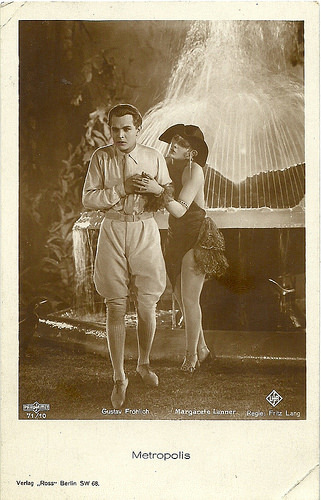
German postcard by Ross Verlag, Berlin, no. 71/10. Photo: Ufa / Parufamet. Publicity still for Metropolis (Fritz Lang, 1927). Collection: Didier Hanson.
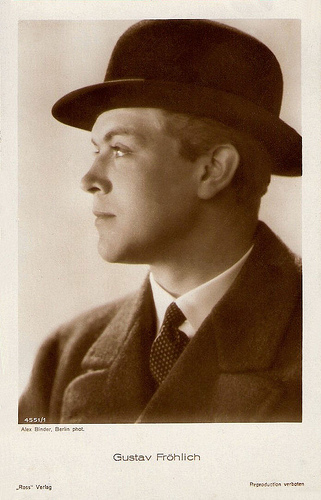
German postcard by Ross Verlag, no. 4551/1, 1929-1930. Photo: Atelier Binder, Berlin.
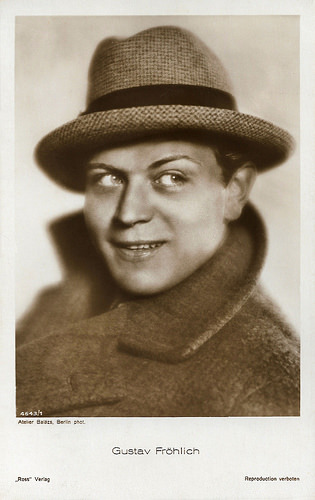
German postcard by Ross Verlag, no. 4643/1, 1929-1930. Photo: Atelier Balázs, Berlin.
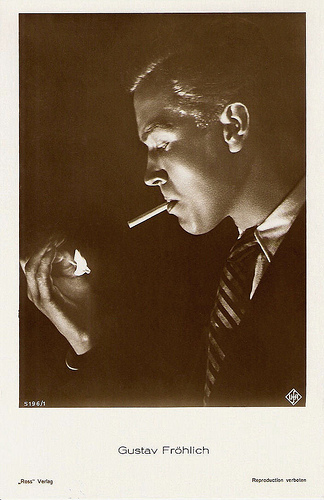
German postcard by Ross Verlag, no. 5196/1, 1930-1931. Photo: Ufa.
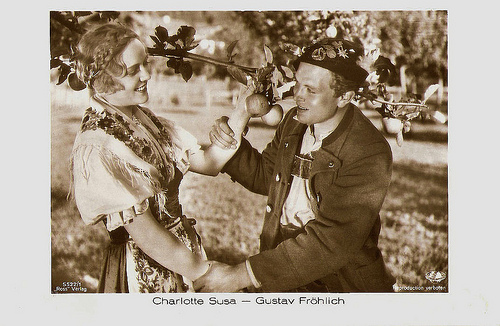
German postcard by Ross Verlag, no. 5522/1, 1930-1931. Photo: Deutsche Universal Film. Publicity Still for Zwei Menschen/Two People (Erich Waschneck, 1930) with Charlotte Susa .
Warner Brothers
After Metropolis, Gustav Fröhlich was typecast as the fresh-faced, naive 'boy next door' in such silent films as Die elf Teufel/The Eleven Devils (Zoltan Korda, Carl Boese, 1927) with Evelyn Holt , Heimkehr/Homecoming (Joe May, 1928) opposite Lars Hanson, and Asphalt (Joe May, 1929), in which he played a honest policeman who is seduced by a crook ( Betty Amann ).
In 1930, Fröhlich was called to Hollywood by Warner Brothers to do German versions of American sound films, such as Die heilige Flamme/The Holy Flames (William Dieterle (as Wilhelm Dieterle), Berthold Viertel, 1931) and Kismet (William Dieterle, 1931), both with Dita Parlo .
Back in Germany, he soon was subscribed for Max Ophüls’ musical comedy Die verliebte Firma/The Company's in Love (1931) next to Lien Deyers , and for Robert Siodmak's crime drama Voruntersuchung/Inquest (1931) with Albert Bassermann .
He often worked with director Géza von Bolváry. Between 1931 and 1933 they made six films together. These include Ich will nicht wissen, wer du bist/I Do Not Want to Know Who You Are (Géza von Bolváry, 1932) with Liane Haid , and Was Frauen träumen/What Women Dream (Géza von Bolváry, 1933), which was co-written by Billy Wilder.
Fröhlich often played smart gentlemen in lighthearted musicals and romances. Because of his carefree attendance, Fröhlich was seldom allowed to play other characters. One of his greatest successes was his part of the helpful and likable policeman in Oberwachtmeister Schwenke (Carl Froelich, 1935).
He also directed films like Rakoczy-Marsch/Rakoczy march (Gustav Fröhlich, Steve Sekely, 1933), Abenteuer eines jungen Herrn in Polen/Love and Alarm (1934), and after the war Wege im Zwielicht/Paths in Twilight (1948), Der Bagnosträfling/The Prisoner (1949) with Paul Dahlke , and the crime drama Die Lüge/The Lie (1950) with Otto Gebühr .
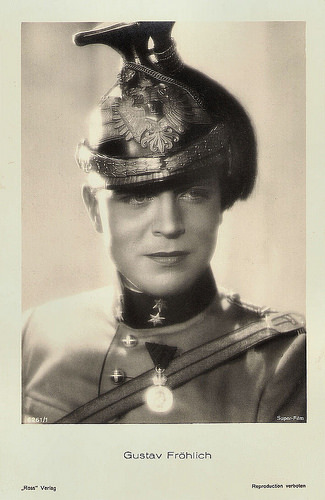
German postcard by Ross Verlag, no. 6261/1, 1931-1932. Photo: Super-Film. Publicity still for Liebeskommando/Love's Command (Géza von Bolváry, 1931).
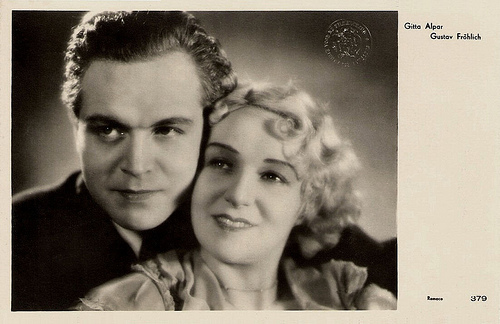
Dutch postcard by JosPe, Arnhem, no. 379. Photo: Remaco. Gitta Alpár and Gustav Fröhlich co-starred in Gitta entdeckt ihr Herz/Gitta Discovers Her Heart (Carl Froelich, 1932).
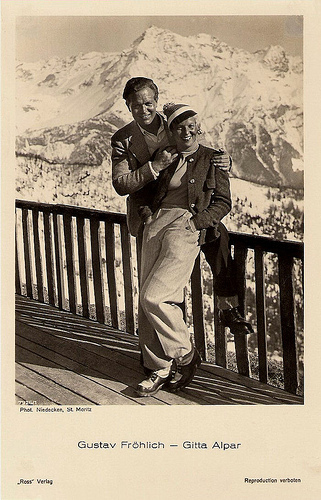
German postcard by Ross Verlag, no. 7926/1, 1932-1933. Photo: Niedecken, St. Moritz. With Gitta Alpár .
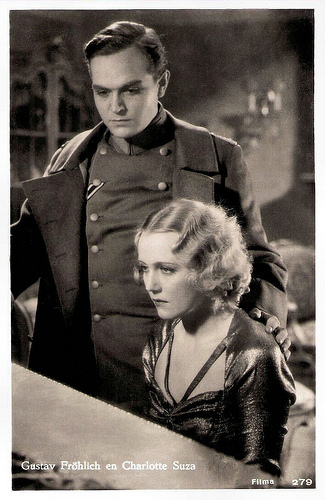
Dutch postcard by JosPe, Arnhem, no. 279. Photo: Filma. Publicity still for Unter falscher Flagge/Under False Flagg (Johannes Meyer, 1932) with Charlotte Susa .
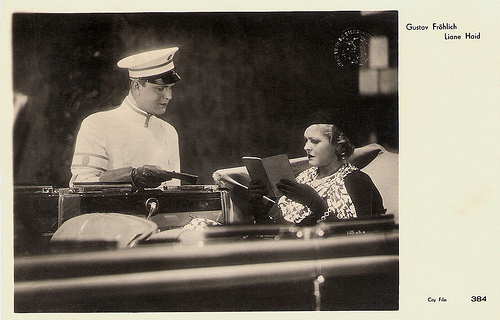
Dutch postcard by JosPe, Arnhem, no. 384. Photo: City Film. Publicity still for Ich will nicht wissen, wer du bist/I Don't Want To Know Who You Are (Géza von Bolváry, 1932) with Liane Haid .
Goebbels
Between 1931 and 1935 Gustav Fröhlich was married with Hungarian Opera star and actress Gitta Alpár . When she was pregnant form their daughter Julika, he left her. According to Alpár, because she was Jewish and he did not want to hurt his career in Nazi Germany.
After the war, Fröhlich tried a reconciliation with Gitta Alpár but she never forgave him. Reportedly this gave him a tough time at old-age.
From 1936 till 1938 he lived together with actress Lída Baarová , his costar in Barcarole (Gerhard Lamprecht, 1935) and Leutnant Bobby, der Teufelskerl/A Devil of a Fellow (Georg Jacoby, 1935).
After losing Lída to Joseph Goebbels, Froelich had a quarrel with him. There is an urban legend that the quarrel culminated in a slap in the face of the powerful and feared Propaganda-Minister. Allegedly, Froehlich was banned from playing his trade for two years (1941-1943). Lída Baarová later denied this in her memoirs.
In 1937, he rented his house in Berchtesgaden to Adolph Hitler's architect, Albert Speer. In 1941 Fröhlich remarried with Maria Hajek. Since 1941 he had to serve for the Wehrmacht, interrupted by film engagements like Der Grosse König/The Great King (Veit Harlan, 1942) starring Otto Gebühr as Prussian king Friedrich the Second.
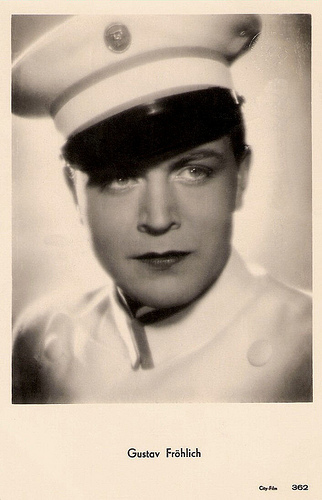
Dutch Postcard by City-Film, no. 362.
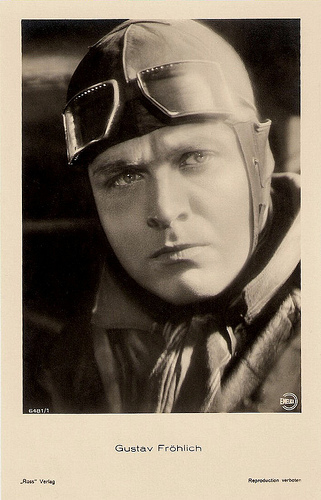
German postcard by Ross Verlag, no. 6481/1, 1931-1932. Photo: Emelka. Publicity still for Gloria (Hans Behrendt, 1932).
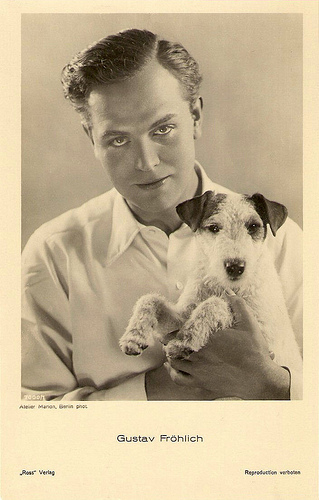
German postcard by Ross Verlag, no. 7000/1, 1932-1933. Photo: Atelier Marion, Berlin.
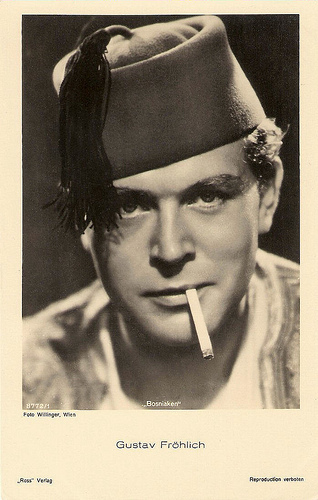
German postcard by Ross Verlag, no. 8772/1, 1933-1934. Photo: Willinger, Wien.
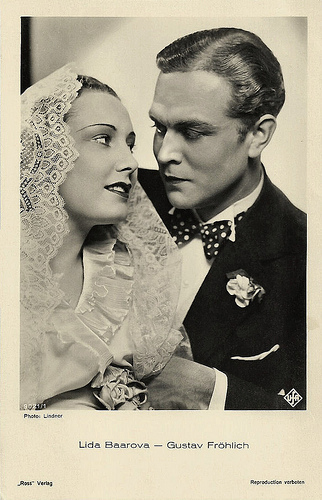
German postcard by Ross Verlag, no. 9021/1, 1935-1936. Photo: Ufa / Lindner. Publicity still for Barcarole (Gerhard Lamprecht, 1936) with Lída Baarová .
Scandal
Gustav Fröhlich was seldom involved in Nazi Propaganda films, a fact that helped him to establish a new film career after World War II.
He tried to escape from standard roles of the charming gentleman by playing a doomed painter in Die Sünderin/The Sinner (Willi Forst, 1951). The effort went down in the chaos of a scandal because of the film's open treatment of several taboos such as suicide and euthanasia, plus a brief nude performance by Hildegard Knef .
He went on to play leads in light entertainment films including Haus des Lebens/House of Life (Karl Hartl, 1952) with Cornell Borchers , and Die kleine Stadt will schlafen gehen/The Little Town Will Go to Sleep (Hans H. König, 1954) with Jester Naefe .
He remained a busy actor after the war but his roles changed from leading men to supporting parts as he got older. From the 1960s on, he had only a few TV film entrances including a part in the comedy Laubenkolonie/Allotment area (Heribert Wenk, Bertold Sakmann, 1968) with Paul Dahlke .
He was more active in the theatre, a.o. for the Renaissance-Theater in Berlin and the Schauspielhaus in Zürich. In 1973 he was honoured with the Filmband in Gold, the German Film Award for Lifetime Achievements. Ten years later, he published his autobiography Waren das Zeiten - Mein Film-Heldenleben/Those Were Times - My Life as a Film Hero (1983). His last public appearance was in 1986, when Giorgio Moroder presented his revised version of Metropolis.
From 1956 on, Gustav Fröhlich lived in Lugano, Switzerland. There he died in 1987 of a complication after surgery, at age 85. His wife Maria Hajek had passed away earlier that same year.
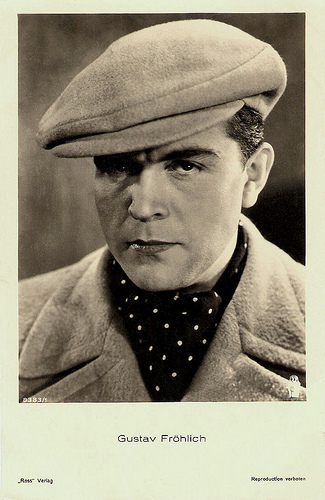
German postcard by Ross Verlag, no. 8383/1, 1933-1934.
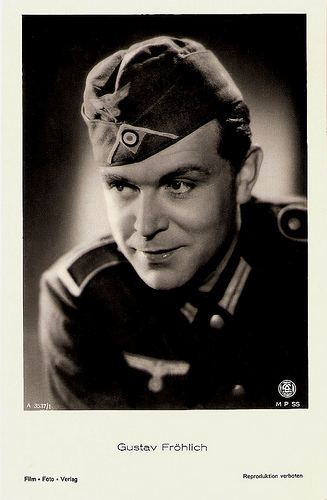
German postcard by Film-Foto-Verlag, no. A 3537/1, 1941-1944. Photo: M P SS.
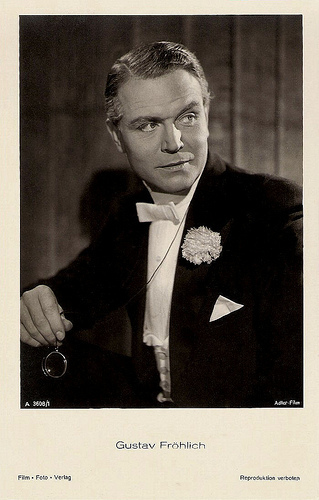
German postcard by Film-Foto-Verlag, no. A 3608/1. Photo: Adler Film.
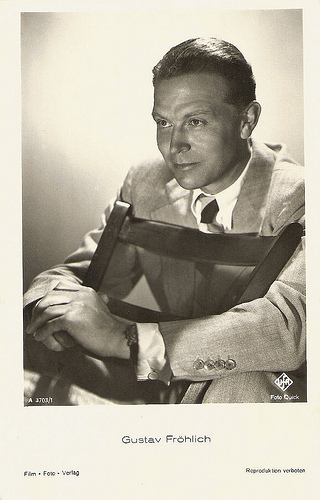
German postcard by Film-Foto-Verlag, no. A 3703/1, 1941-1944. Photo: Quick / Ufa.
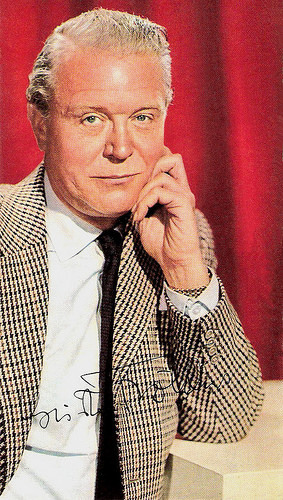
German collectors card by Lux.
Sources: Lara Goeke (The Gustav Fröhlich Fan Page), Bruce Eder (AllMovie), Thomas Staedeli (Cyranos), Wikipedia (English and German), and .

German postcard by Ross Verlag, no. 1584/2, 1927-1938. Photo: Ufa.

German postcard by Ross Verlag, no. 3018/1, 1928-1929. Photo: M. v. Bucovich (Atelier K. Schenker).

German postcard by Ross Verlag, no. 3600/1, 1928-1929. Photo: Ufa.

German postcard by Ross Verlag, no. 4145/1, 1929-1930. Photo: Ufa.

German postcard by Ross Verlag, no. 4293/1, 1929-1930. Photo: Ufa.
Metropolis
Gustav Friedrich Fröhlich was born an illegitimate child in Hannover, Germany in 1902. His father, Gustav König, was a well-known engineer, and his mother Hedwig Therese Sophie Fröhlich, the daughter of a worker. Gustav was raised by foster parents. His foster family moved around western Germany a lot while he was growing up, living in cities like Wiesbaden and Wurzburg.
He studied at the Homuth Realgymnasium Friedenau in Berlin. During World War I the young Gustav volunteered for a duty in occupied Brussels as supervisioner of the press.
In 1919 he started his career as a trainee at a newspaper, but he spent his spare time as a emcee at local variety shows. He also wrote two issues of a dime novel, Heinz Brandt, der Fremdenlegionär/Heinz Brandt, the Foreign Legionnaire.
After some entrances at a vaudeville theater under the stage name Gustav Geef he took acting lessons in Heilbronn. In the next few years he appeared on different minor German stages. In Berlin he played from 1923 till 1925 at the Volksbühne am Bülowplatz under the direction of Erwin Piscator. Later he appeared as The Prince of Homburg at the Deutsche Theater under the direction of Max Reinhardt.
His film debut was a small role in a Dutch-German film produced in Germany, De bruut/Ein neues Leben/The Brute (Theo Frenkel, 1922) with Erna Morena and Adolphe Engers .
He then played a secondary role as composer Franz Liszt in Paganini (Heinz Goldberg, 1923) featuring Conrad Veidt. The following years, he played in such films as Friesenblut (1925) opposite Jenny Jugo.
Then Fröhlich landed his breakthrough role as Freder Fredersen in Metropolis (Fritz Lang, 1927) by chance. He was only scheduled to play one of the workmen but four weeks after the beginning he was discovered on the set by Thea von Harbou, Fritz Lang's wife. Lang immediately cast him in the lead because of his striking good looks. A new star was born.

German postcard by Ross Verlag, Berlin, no. 71/10. Photo: Ufa / Parufamet. Publicity still for Metropolis (Fritz Lang, 1927). Collection: Didier Hanson.

German postcard by Ross Verlag, no. 4551/1, 1929-1930. Photo: Atelier Binder, Berlin.

German postcard by Ross Verlag, no. 4643/1, 1929-1930. Photo: Atelier Balázs, Berlin.

German postcard by Ross Verlag, no. 5196/1, 1930-1931. Photo: Ufa.

German postcard by Ross Verlag, no. 5522/1, 1930-1931. Photo: Deutsche Universal Film. Publicity Still for Zwei Menschen/Two People (Erich Waschneck, 1930) with Charlotte Susa .
Warner Brothers
After Metropolis, Gustav Fröhlich was typecast as the fresh-faced, naive 'boy next door' in such silent films as Die elf Teufel/The Eleven Devils (Zoltan Korda, Carl Boese, 1927) with Evelyn Holt , Heimkehr/Homecoming (Joe May, 1928) opposite Lars Hanson, and Asphalt (Joe May, 1929), in which he played a honest policeman who is seduced by a crook ( Betty Amann ).
In 1930, Fröhlich was called to Hollywood by Warner Brothers to do German versions of American sound films, such as Die heilige Flamme/The Holy Flames (William Dieterle (as Wilhelm Dieterle), Berthold Viertel, 1931) and Kismet (William Dieterle, 1931), both with Dita Parlo .
Back in Germany, he soon was subscribed for Max Ophüls’ musical comedy Die verliebte Firma/The Company's in Love (1931) next to Lien Deyers , and for Robert Siodmak's crime drama Voruntersuchung/Inquest (1931) with Albert Bassermann .
He often worked with director Géza von Bolváry. Between 1931 and 1933 they made six films together. These include Ich will nicht wissen, wer du bist/I Do Not Want to Know Who You Are (Géza von Bolváry, 1932) with Liane Haid , and Was Frauen träumen/What Women Dream (Géza von Bolváry, 1933), which was co-written by Billy Wilder.
Fröhlich often played smart gentlemen in lighthearted musicals and romances. Because of his carefree attendance, Fröhlich was seldom allowed to play other characters. One of his greatest successes was his part of the helpful and likable policeman in Oberwachtmeister Schwenke (Carl Froelich, 1935).
He also directed films like Rakoczy-Marsch/Rakoczy march (Gustav Fröhlich, Steve Sekely, 1933), Abenteuer eines jungen Herrn in Polen/Love and Alarm (1934), and after the war Wege im Zwielicht/Paths in Twilight (1948), Der Bagnosträfling/The Prisoner (1949) with Paul Dahlke , and the crime drama Die Lüge/The Lie (1950) with Otto Gebühr .

German postcard by Ross Verlag, no. 6261/1, 1931-1932. Photo: Super-Film. Publicity still for Liebeskommando/Love's Command (Géza von Bolváry, 1931).

Dutch postcard by JosPe, Arnhem, no. 379. Photo: Remaco. Gitta Alpár and Gustav Fröhlich co-starred in Gitta entdeckt ihr Herz/Gitta Discovers Her Heart (Carl Froelich, 1932).

German postcard by Ross Verlag, no. 7926/1, 1932-1933. Photo: Niedecken, St. Moritz. With Gitta Alpár .

Dutch postcard by JosPe, Arnhem, no. 279. Photo: Filma. Publicity still for Unter falscher Flagge/Under False Flagg (Johannes Meyer, 1932) with Charlotte Susa .

Dutch postcard by JosPe, Arnhem, no. 384. Photo: City Film. Publicity still for Ich will nicht wissen, wer du bist/I Don't Want To Know Who You Are (Géza von Bolváry, 1932) with Liane Haid .
Goebbels
Between 1931 and 1935 Gustav Fröhlich was married with Hungarian Opera star and actress Gitta Alpár . When she was pregnant form their daughter Julika, he left her. According to Alpár, because she was Jewish and he did not want to hurt his career in Nazi Germany.
After the war, Fröhlich tried a reconciliation with Gitta Alpár but she never forgave him. Reportedly this gave him a tough time at old-age.
From 1936 till 1938 he lived together with actress Lída Baarová , his costar in Barcarole (Gerhard Lamprecht, 1935) and Leutnant Bobby, der Teufelskerl/A Devil of a Fellow (Georg Jacoby, 1935).
After losing Lída to Joseph Goebbels, Froelich had a quarrel with him. There is an urban legend that the quarrel culminated in a slap in the face of the powerful and feared Propaganda-Minister. Allegedly, Froehlich was banned from playing his trade for two years (1941-1943). Lída Baarová later denied this in her memoirs.
In 1937, he rented his house in Berchtesgaden to Adolph Hitler's architect, Albert Speer. In 1941 Fröhlich remarried with Maria Hajek. Since 1941 he had to serve for the Wehrmacht, interrupted by film engagements like Der Grosse König/The Great King (Veit Harlan, 1942) starring Otto Gebühr as Prussian king Friedrich the Second.

Dutch Postcard by City-Film, no. 362.

German postcard by Ross Verlag, no. 6481/1, 1931-1932. Photo: Emelka. Publicity still for Gloria (Hans Behrendt, 1932).

German postcard by Ross Verlag, no. 7000/1, 1932-1933. Photo: Atelier Marion, Berlin.

German postcard by Ross Verlag, no. 8772/1, 1933-1934. Photo: Willinger, Wien.

German postcard by Ross Verlag, no. 9021/1, 1935-1936. Photo: Ufa / Lindner. Publicity still for Barcarole (Gerhard Lamprecht, 1936) with Lída Baarová .
Scandal
Gustav Fröhlich was seldom involved in Nazi Propaganda films, a fact that helped him to establish a new film career after World War II.
He tried to escape from standard roles of the charming gentleman by playing a doomed painter in Die Sünderin/The Sinner (Willi Forst, 1951). The effort went down in the chaos of a scandal because of the film's open treatment of several taboos such as suicide and euthanasia, plus a brief nude performance by Hildegard Knef .
He went on to play leads in light entertainment films including Haus des Lebens/House of Life (Karl Hartl, 1952) with Cornell Borchers , and Die kleine Stadt will schlafen gehen/The Little Town Will Go to Sleep (Hans H. König, 1954) with Jester Naefe .
He remained a busy actor after the war but his roles changed from leading men to supporting parts as he got older. From the 1960s on, he had only a few TV film entrances including a part in the comedy Laubenkolonie/Allotment area (Heribert Wenk, Bertold Sakmann, 1968) with Paul Dahlke .
He was more active in the theatre, a.o. for the Renaissance-Theater in Berlin and the Schauspielhaus in Zürich. In 1973 he was honoured with the Filmband in Gold, the German Film Award for Lifetime Achievements. Ten years later, he published his autobiography Waren das Zeiten - Mein Film-Heldenleben/Those Were Times - My Life as a Film Hero (1983). His last public appearance was in 1986, when Giorgio Moroder presented his revised version of Metropolis.
From 1956 on, Gustav Fröhlich lived in Lugano, Switzerland. There he died in 1987 of a complication after surgery, at age 85. His wife Maria Hajek had passed away earlier that same year.

German postcard by Ross Verlag, no. 8383/1, 1933-1934.

German postcard by Film-Foto-Verlag, no. A 3537/1, 1941-1944. Photo: M P SS.

German postcard by Film-Foto-Verlag, no. A 3608/1. Photo: Adler Film.

German postcard by Film-Foto-Verlag, no. A 3703/1, 1941-1944. Photo: Quick / Ufa.

German collectors card by Lux.
Sources: Lara Goeke (The Gustav Fröhlich Fan Page), Bruce Eder (AllMovie), Thomas Staedeli (Cyranos), Wikipedia (English and German), and .
Published on May 16, 2018 22:00
May 15, 2018
Giuditta e Oloferne (1929)
Giuditta e Oloferne/Judith and Holofernes (Baldassarre Negroni, 1929) is an Italian silent historical film starring Bartolomeo Pagano, Jia Ruskaja and Franz Sala. It was the final film of Pagano, who had been famous during the silent era for his portrayals of Maciste. For the Russian dancer Jia Ruskaja, it was her only screen appearance. The film is based on the Biblical story of Judith beheading Holofernes and mixes this with a modern story about an engineer who tries to save a mountain village from the shady affairs of speculating entrepreneurs lead by a beautiful woman. There were several film adaptations of
Judith and Holofernes
, including a Louis Feuillade version in 1909 and D.W. Griffith' famous 1914 version Judith of Bethulia.
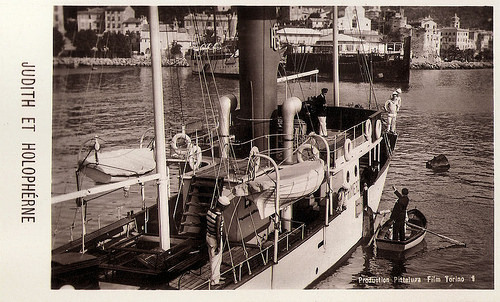
Italian postcard by G.B. Falci, Milano (Milan), no. 1. Photo: Production Pittaluga Film, Torino (Turin). Publicity still for Giuditta e Oloferne/Judith and Holofernes (Baldassarre Negroni, 1929).
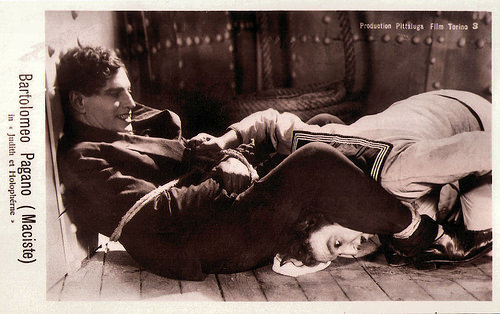
Italian postcard by G.B. Falci, Milano (Milan), no. 3. Photo: Production Pittaluga Film, Torino (Turin). Publicity still for Giuditta e Oloferne/Judith and Holofernes (Baldassarre Negroni, 1929) with Bartolomeo Pagano .
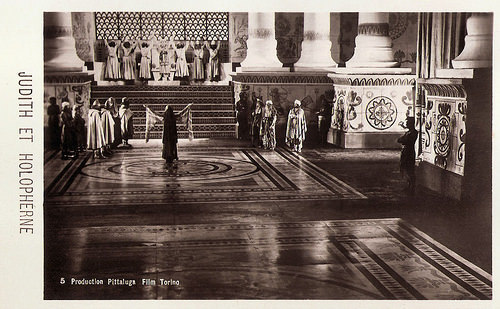
Italian postcard by G.B. Falci, Milano (Milan), no. 5. Photo: Production Pittaluga Film, Torino (Turin). Publicity still for Giuditta e Oloferne/Judith and Holofernes (Baldassarre Negroni, 1929).
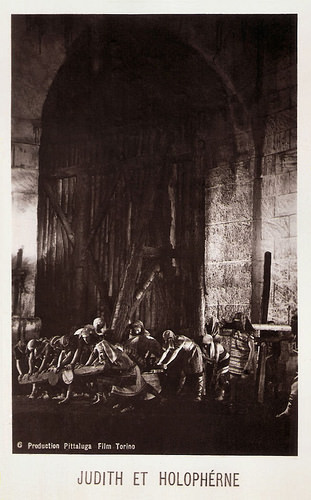
Italian postcard by G.B. Falci, Milano (Milan), no. 6. Photo: Production Pittaluga Film, Torino (Turin). Publicity still for Giuditta e Oloferne/Judith and Holofernes (Baldassarre Negroni, 1929).
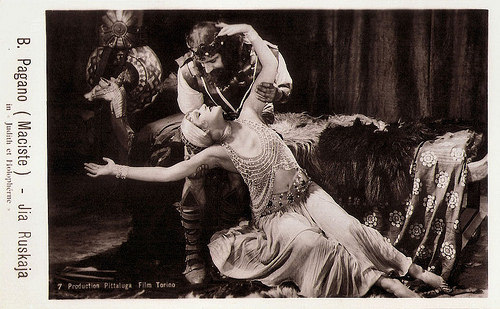
Italian postcard by G.B. Falci, Milano (Milan), no. 7. Photo: Production Pittaluga Film, Torino (Turin). Publicity still for Giuditta e Oloferne/Judith and Holofernes (Baldassarre Negroni, 1929) with Bartolomeo Pagano and Jia Ruskaja.

Italian postcard by G.B. Falci, Milano (Milan), no. 10. Photo: Production Pittaluga Film, Torino (Turin). Publicity still for Giuditta e Oloferne/Judith and Holofernes (Baldassarre Negroni, 1929).
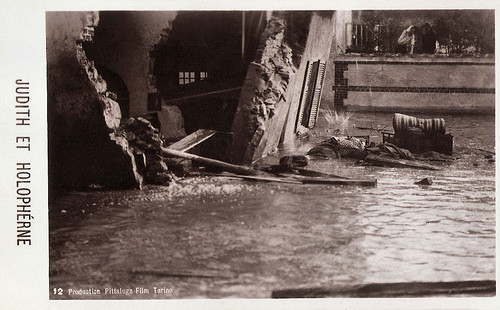
Italian postcard by G.B. Falci, Milano (Milan), no. 12. Photo: Production Pittaluga Film, Torino (Turin). Publicity still for Giuditta e Oloferne/Judith and Holofernes (Baldassarre Negroni, 1929).
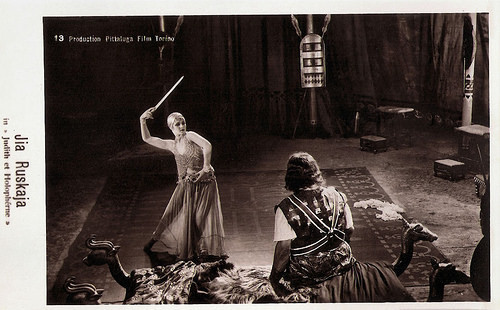
Italian postcard by G.B. Falci, Milano (Milan), no. 13. Photo: Production Pittaluga Film, Torino (Turin). Publicity still for Giuditta e Oloferne/Judith and Holofernes (Baldassarre Negroni, 1929) with Jia Ruskaja.
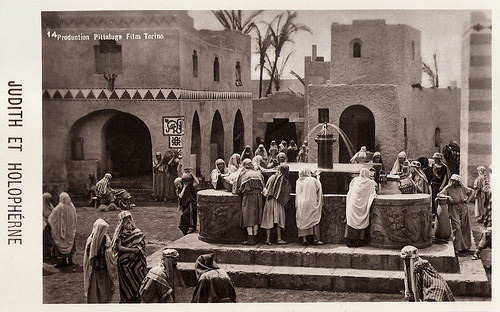
Italian postcard by G.B. Falci, Milano (Milan), no. 14. Photo: Production Pittaluga Film, Torino (Turin). Publicity still for Giuditta e Oloferne/Judith and Holofernes (Baldassarre Negroni, 1929).
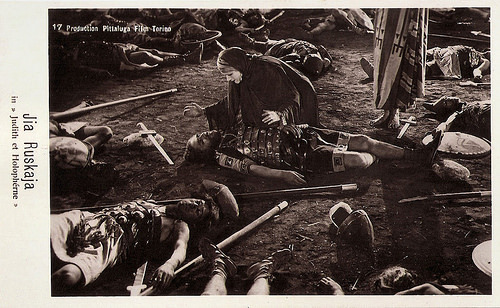
Italian postcard by G.B. Falci, Milano (Milan), no. 17. Photo: Production Pittaluga Film, Torino (Turin). Publicity still for Giuditta e Oloferne/Judith and Holofernes (Baldassarre Negroni, 1929) with Jia Ruskaja.
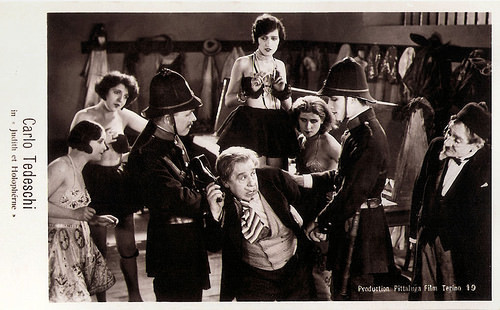
Italian postcard by G.B. Falci, Milano (Milan), no. 19. Photo: Production Pittaluga Film, Torino (Turin). Publicity still for Giuditta e Oloferne/Judith and Holofernes (Baldassarre Negroni, 1929) with Carlo Tedeschi.
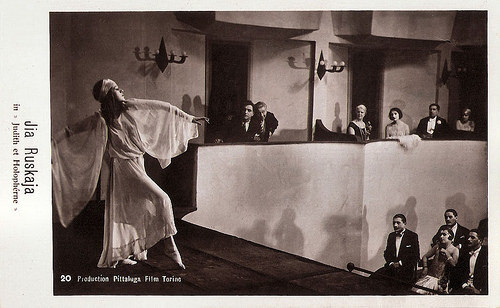
Italian postcard by G.B. Falci, Milano (Milan), no. 20. Photo: Production Pittaluga Film, Torino (Turin). Publicity still for Giuditta e Oloferne/Judith and Holofernes (Baldassarre Negroni, 1929) with Jia Ruskaja.
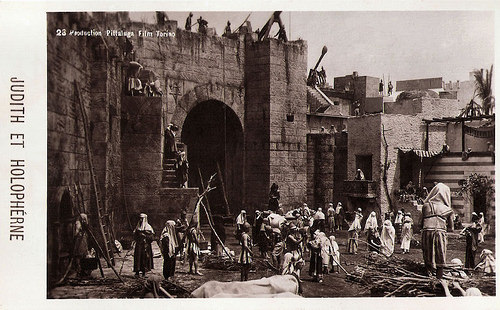
Italian postcard by G.B. Falci, Milano (Milan), no. 23. Photo: Production Pittaluga Film, Torino (Turin). Publicity still for Giuditta e Oloferne/Judith and Holofernes (Baldassarre Negroni, 1929).
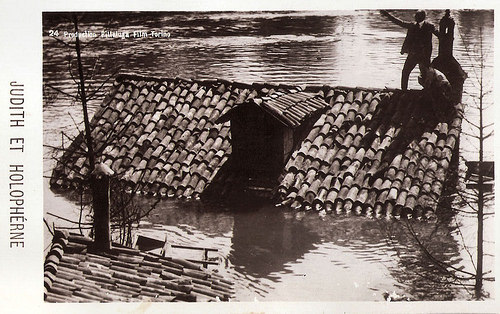
Italian postcard by G.B. Falci, Milano (Milan), no. 24. Photo: Production Pittaluga Film, Torino (Turin). Publicity still for Giuditta e Oloferne/Judith and Holofernes (Baldassarre Negroni, 1929).
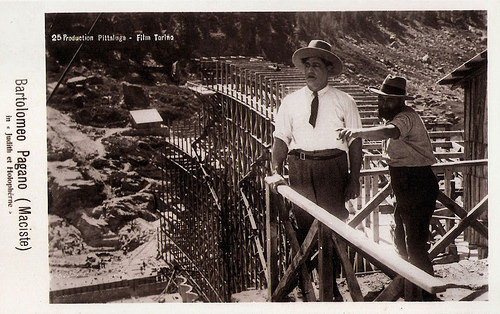
Italian postcard by G.B. Falci, Milano (Milan), no. 25. Photo: Production Pittaluga Film, Torino (Turin). Publicity still for Giuditta e Oloferne/Judith and Holofernes (Baldassarre Negroni, 1929) with Bartolomeo Pagano .
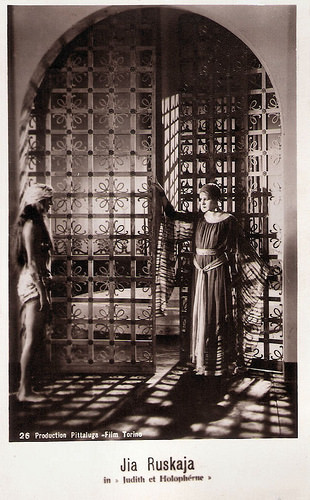
Italian postcard by G.B. Falci, Milano (Milan), no. 26. Photo: Production Pittaluga Film, Torino (Turin). Publicity still for Giuditta e Oloferne/Judith and Holofernes (Baldassarre Negroni, 1929) with Jia Ruskaja.
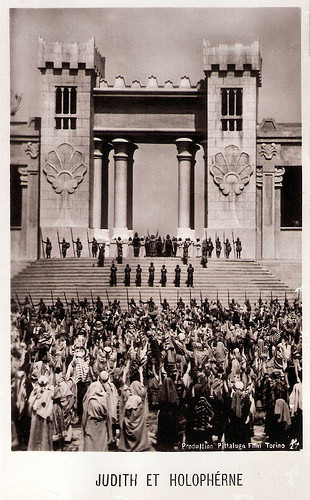
Italian postcard by G.B. Falci, Milano (Milan), no. 27. Photo: Production Pittaluga Film, Torino (Turin). Publicity still for Giuditta e Oloferne/Judith and Holofernes (Baldassarre Negroni, 1929).
Sources: Vittorio Martinelli (Il Cinema Muto Italiano - 1923-1931 - Italian) and Wikipedia.

Italian postcard by G.B. Falci, Milano (Milan), no. 1. Photo: Production Pittaluga Film, Torino (Turin). Publicity still for Giuditta e Oloferne/Judith and Holofernes (Baldassarre Negroni, 1929).

Italian postcard by G.B. Falci, Milano (Milan), no. 3. Photo: Production Pittaluga Film, Torino (Turin). Publicity still for Giuditta e Oloferne/Judith and Holofernes (Baldassarre Negroni, 1929) with Bartolomeo Pagano .

Italian postcard by G.B. Falci, Milano (Milan), no. 5. Photo: Production Pittaluga Film, Torino (Turin). Publicity still for Giuditta e Oloferne/Judith and Holofernes (Baldassarre Negroni, 1929).

Italian postcard by G.B. Falci, Milano (Milan), no. 6. Photo: Production Pittaluga Film, Torino (Turin). Publicity still for Giuditta e Oloferne/Judith and Holofernes (Baldassarre Negroni, 1929).

Italian postcard by G.B. Falci, Milano (Milan), no. 7. Photo: Production Pittaluga Film, Torino (Turin). Publicity still for Giuditta e Oloferne/Judith and Holofernes (Baldassarre Negroni, 1929) with Bartolomeo Pagano and Jia Ruskaja.

Italian postcard by G.B. Falci, Milano (Milan), no. 10. Photo: Production Pittaluga Film, Torino (Turin). Publicity still for Giuditta e Oloferne/Judith and Holofernes (Baldassarre Negroni, 1929).

Italian postcard by G.B. Falci, Milano (Milan), no. 12. Photo: Production Pittaluga Film, Torino (Turin). Publicity still for Giuditta e Oloferne/Judith and Holofernes (Baldassarre Negroni, 1929).

Italian postcard by G.B. Falci, Milano (Milan), no. 13. Photo: Production Pittaluga Film, Torino (Turin). Publicity still for Giuditta e Oloferne/Judith and Holofernes (Baldassarre Negroni, 1929) with Jia Ruskaja.

Italian postcard by G.B. Falci, Milano (Milan), no. 14. Photo: Production Pittaluga Film, Torino (Turin). Publicity still for Giuditta e Oloferne/Judith and Holofernes (Baldassarre Negroni, 1929).

Italian postcard by G.B. Falci, Milano (Milan), no. 17. Photo: Production Pittaluga Film, Torino (Turin). Publicity still for Giuditta e Oloferne/Judith and Holofernes (Baldassarre Negroni, 1929) with Jia Ruskaja.

Italian postcard by G.B. Falci, Milano (Milan), no. 19. Photo: Production Pittaluga Film, Torino (Turin). Publicity still for Giuditta e Oloferne/Judith and Holofernes (Baldassarre Negroni, 1929) with Carlo Tedeschi.

Italian postcard by G.B. Falci, Milano (Milan), no. 20. Photo: Production Pittaluga Film, Torino (Turin). Publicity still for Giuditta e Oloferne/Judith and Holofernes (Baldassarre Negroni, 1929) with Jia Ruskaja.

Italian postcard by G.B. Falci, Milano (Milan), no. 23. Photo: Production Pittaluga Film, Torino (Turin). Publicity still for Giuditta e Oloferne/Judith and Holofernes (Baldassarre Negroni, 1929).

Italian postcard by G.B. Falci, Milano (Milan), no. 24. Photo: Production Pittaluga Film, Torino (Turin). Publicity still for Giuditta e Oloferne/Judith and Holofernes (Baldassarre Negroni, 1929).

Italian postcard by G.B. Falci, Milano (Milan), no. 25. Photo: Production Pittaluga Film, Torino (Turin). Publicity still for Giuditta e Oloferne/Judith and Holofernes (Baldassarre Negroni, 1929) with Bartolomeo Pagano .

Italian postcard by G.B. Falci, Milano (Milan), no. 26. Photo: Production Pittaluga Film, Torino (Turin). Publicity still for Giuditta e Oloferne/Judith and Holofernes (Baldassarre Negroni, 1929) with Jia Ruskaja.

Italian postcard by G.B. Falci, Milano (Milan), no. 27. Photo: Production Pittaluga Film, Torino (Turin). Publicity still for Giuditta e Oloferne/Judith and Holofernes (Baldassarre Negroni, 1929).
Sources: Vittorio Martinelli (Il Cinema Muto Italiano - 1923-1931 - Italian) and Wikipedia.
Published on May 15, 2018 22:00
May 14, 2018
Hans Adalbert Schlettow
German actor Hans Adalbert Schlettow (1888–1945) appeared between 1917 and 1945 in about 150 films. He played sinister characters in some of the masterpieces of the German silent cinema, including Fritz Lang's Die Nibelungen (1924) and Joe May's Asphalt (1929). But in real life Schlettow proved to be a sinister character as well.

German postcard by Ross Verlag, Berlin, no. 672/5. Photo: Decla-Ufa-Film. Hans Adalbert Schlettow as Hagen (von) Tronje, in Fritz Lang's saga Die Nibelungen (1924).
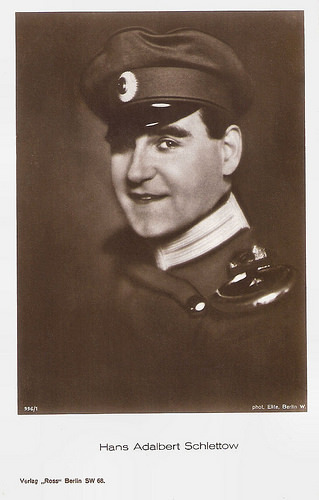
German postcard by Ross Verlag, no. 996/1, 1925-1926. Photo: Elite, Berlin W.
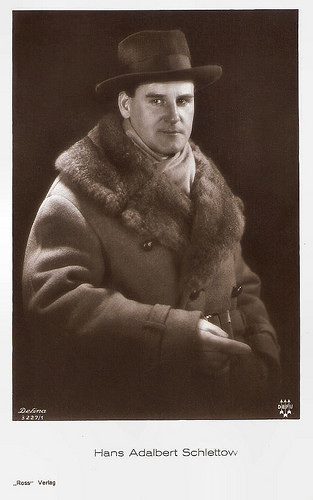
German postcard by Ross Verlag, no. 3227/1, 1928-1929. Photo: Defina / Defu.
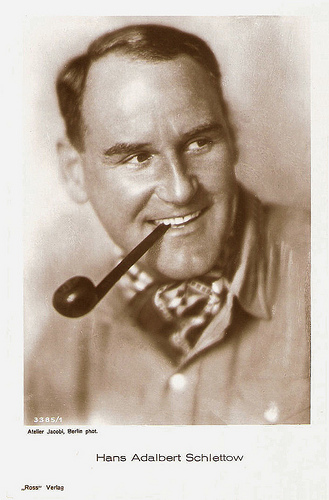
German postcard by Ross Verlag, no. 3385/1, 1928-1929. Photo: Atelier Jacobi, Berlin.
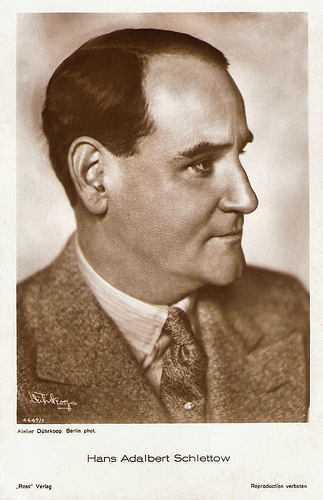
German postcard by Ross Verlag, no. 4647/1, 1929-1930. Photo: Atelier Dührkoop, Berlin.
Passionate About the Arts
Hans Adelbert Droescher von Schlettow was born in Frankfurt am Main, Germany in 1887 or 1888 (sources differ; his gravestone says the latter). He was the son of an officer and he himself also strived for a career in the army. He had to stop his military studies because of health problems.
Passionate about the arts, he then turned towards acting. Under his real name, he began his career as a trainee at the Schauspielhaus in Frankfurt in 1908. Then he went to Barmen, and from 1915 to 1919 he was committed to the Hoftheater Mannheim (Mannheim court theatre). In 1920 he joined the Phantastischen Theater in Berlin-Charlottenburg.
Under the stage name Hans Adalbert Schlettow, he made his film debut in three silent productions by director Urban Gad: Die Gespensterstunde/The Ghost Hour (Urban Gad, 1916), Der breite weg/The wide way (Urban Gad, 1916), and Klosterfriede/Monastery Peace (Urban Gad, 1917), all opposite Maria Widal and Olga Engl.
During his career, Schlettow kept changing his names, and was sometimes credited as Hans Adalbert von Schlettow, Adalbert or Adalberg von Schlettow, or Hans Schlettow. After his first film appearances he already worked with such famous stars as Pola Negri in Komtesse Doddy/Countess Doddy (Georg Jacoby, 1918), and Emil Jannings in the Sci-Fi film Algol (Hans Werckmeister, 1919), about an alien from the planet Algol who gives a man a device for superpowers.
Initially, Schlettow often played the lover, such as in the title role of Don Juan (Albert Heine, Robert Land, 1922) opposite Margarete Lanner . Gradually he specialised in sinister characters, such as Satan in Hiob/Job (Kurt Matull, 1918) with Eduard von Winterstein, a murderer in the Emile Zola adaptation Thérèse Raquin/Shadows of Fear (Jacques Feyder, 1928) with Gina Manès, and a criminal in Asphalt (Joe May, 1929).
Schlettow’s most famous films are two Fritz Lang classics, the two-part thriller Dr. Mabuse, der Spieler/Dr. Mabuse, The Gambler (Fritz Lang, 1922) in which he played the chauffeur of bad genius Dr. Mabuse ( Rudolf Klein-Rogge ), and the lushly produced UFA epic Die Nibelungen (Fritz Lang, 1924), based on the German myth of the Nibelungen, in which he played the villainous Hagen Tronje who discovers the weak spot of the great German hero Siegfried ( Paul Richter ) and pierces it with a spear.
Schlettow worked also with another legendary director of the silent cinema, David Wark Griffith on Isn't Life Wonderful (D.W. Griffith, 1924). It was Griffith's last independent production, filmed in Berlin, before he was forced to sell his Mamaroneck studio to help pay off mounting debts. At IMDb , Thataw reviews: “Though little known today (...) this little film, in my opinion, is Griffith's last great film. It incorporates the best elements of intimate dramas like Broken Blossoms with a large scale backdrop like Hearts of the World. (...) This story of a poor family's trials and tribulations in inflation ravaged post World War I Germany is remarkably grim and is presented realistically. Griffith came under heavy criticism for presenting a sympathetic portrait of a family in Germany (they had to be changed from German to Polish although one character still tears up a picture of the Kaiser) and for shooting the film in Germany itself.”
Twice Schlettow appeared as Stenka Razin, the leader of the 17th-century uprising of peasants against the Tsarist Russian establishment. In 1928 he starred in Wolga Wolga/Volga Volga, a silent film directed by Russian emigré director Viktor Tourjansky and co-starring Lilian Hall-Davies and Rudolf Klein-Rogge . In 1936 followed a sound version, Stjenka Rasin/Wolga-Wolga (1936), directed by another anti-Soviet émigré Alexandre Volkoff and co-starring Wera Engels and Heinrich George . Razin died in 1671, during the reign of Tsar Aleksei Mikhailovich (father of Peter the Great).
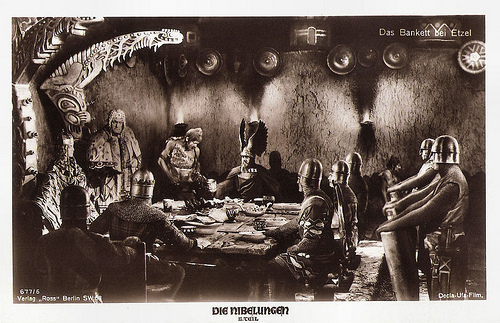
German postcard by Ross Verlag, no. 677/6. Photo: Decla-Ufa-Film. Publicity still for Die Nibelungen, II, Kriemhilds Rache/Kriemhild's Revenge (Fritz Lang, 1924). Das Bankett bei Etzel (The Banquet at Etzel's, King of the Huns). During the banquet the knights discover it is a trap. Hagen von Tronje (Hans Adalbert Schlettow) kills the child of Etzel ( Rudolf Klein-Rogge ) and Kriemhild ( Margarete Schön ), after which Etzel swears to kill all Burgunds. Several are killed in fights. Finally, the banqueting hall is set on fire, killing all but Hagen and king Gunther. Most sets of the film were done by Erich Kettelhut, in collaboration with Otto Hunte and Karl Vollbrecht.

German postcard by Ross Verlag, Berlin, no. 677/7. Photo: Decla-Ufa-Film. Hagen von Tronje (Hans Adalbert Schlettow) protects king Gunther (Theodoor Loos) in the burning palace of Etzel.
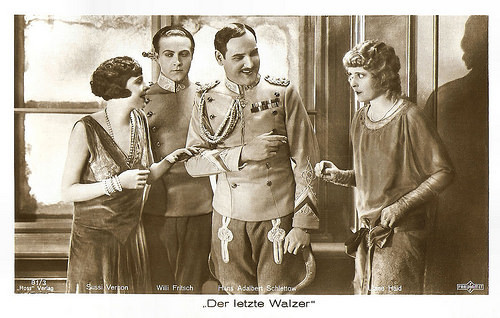
German postcard by Ross Verlag, no. 81/3, 1925-1935. Photo: Parufamet. Publicity still for Der Letzte Walzer/The Last Waltz (Arthur Robison, 1927) with Suzy Vernon , Willy Fritsch , Hans Adalbert Schlettow and Liane Haid .
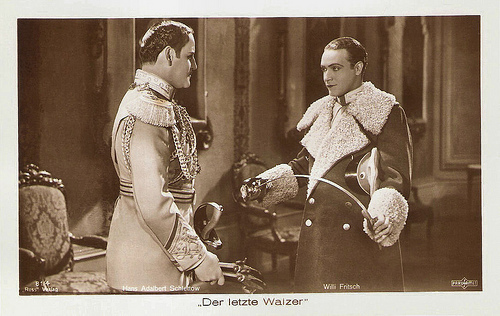
German postcard by Ross Verlag, no. 81/4, 1925-1935. Photo: Parufamet. Publicity still for Der Letzte Walzer/The Last Waltz (Arthur Robison, 1927) with Willy Fritsch and Hans Adalbert Schlettow.
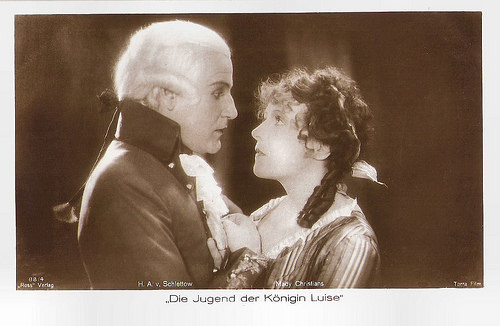
German postcard by Ross Verlag, no. 88/4. Photo: Terra Film. Publicity still for Königin Luise, 1. Teil - Die Jugend der Königin Luise/Queen Louise (Karl Grune, 1927) with Mady Christians .
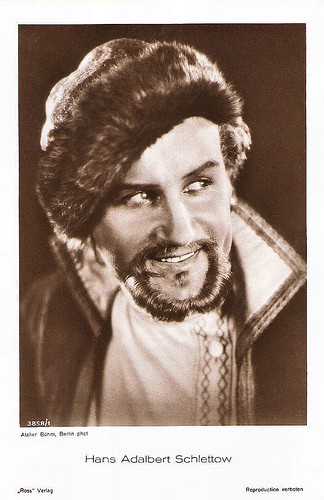
German postcard by Ross Verlag, no. 3859/1, 1928-1929. Photo: Atelier Böhm, Berlin. Publicity still for Wolga Wolga/Volga Volga (Viktor Tourjansky, 1928).
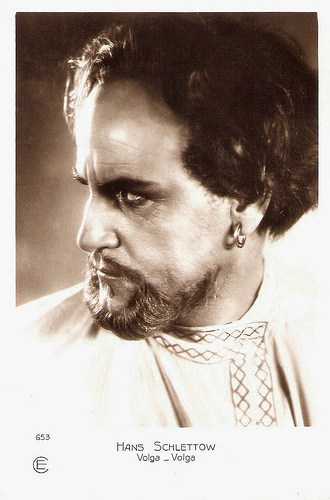
French postcard by Cinémagazine-Edition, Paris, no. 653. Photo: publicity still for Wolga Wolga/Volga Volga (Viktor Tourjansky, 1928).
The Informer
In 1930, Hans Adalbert Schlettow played Harry the farmer in one of the first English sound films, the thriller A cottage in Dartmoor (Anthony Asquith, 1930) with Swedish actor Uno Henning as an escaped prisoner. The sound of this production, filmed in Sweden, has been lost and the film can now only be shown in a silent version.
After the arrival of sound, Schlettow first appeared in leading parts, such as in the comedy Der tolle Bomberg/The Mad Bomberg (Georg Asagaroff, 1932) with Vivian Gibson , and Der Jäger aus Kurpfalz/The hunter from the Palatinate (Carl Behr, 1932) with Fritz Kampers.
Later he mainly worked as a supporting actor. During the 1930s, he often appeared in Heimat-films, films with a regional background, such as An heiligen Wassern/Sacred Waters (Erich Waschneck, 1932) with Karin Hardt , Die Nacht im Forsthaus/The Roberts Case (Erich Engels, 1933) and Der Jäger von Fall/The Hunter of Fall (Hans Deppe, 1936).
In 1940, he played the role of Santer, the opponent of Winnetou, at the Karl-May-Spielen, a Karl May festival in Werder. Long before the coming to power of Adolph Hitler, Schlettow had been a sympathizer of the Nazis and their anti-Semitic theories. After 1933, Schlettow was regarded by colleagues as an informer.
During the war time he played in such productions as Die Rothschilds/The Rothschilds (Erich Waschneck, 1941), an anti-Semitic and anti-British propaganda film about the rise of the Jewish bankers (the Rothschild family) at the beginning of the 19th century, and Ohm Krüger/Uncle Krüger (Hans Steinhoff, 1941), the second-most expensive prestige and propaganda project of the Nazi period justifying the annihilation politics of the concentration camps, while claiming this to be a creation of the British in South Africa during the Boer war.
He also played in popular entertainment films as the circus spectacle Die grosse Nummer/The Big Number (Karl Anton, 1943), starring Leny Marenbach and Rudolf Prack . In August 1944 in the final phase of the Second World War, Joseph Goebbels placed him on the list of the ‘Gottbegnadeten-Liste der wichtigsten Filmschauspieler’ (the God gifted list of the main film actors), so he did not have to fight at the front.
Hans Adalbert Schlettow died anyway shortly before the end of the war in April 1945. In a burst of patriotism, he had joined the army and during the Battle of Berlin, when the Third Reich started its desperate final offensive, he became a war casualty. About his private life is known that he loved to travel often to sunny, fascist Italy with actor Eduard von Winterstein, with whom he also often worked together.
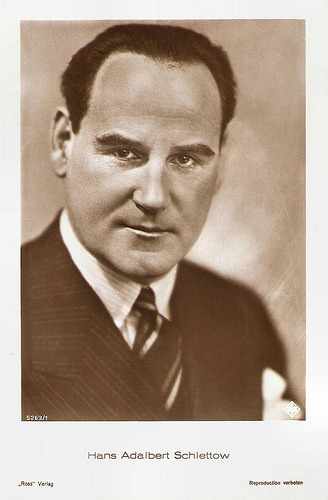
German postcard by Ross Verlag, no. 5263/1, 1930-1931. Photo: Ufa.
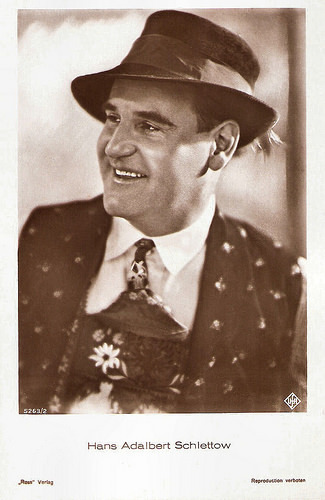
German postcard by Ross Verlag, no. 5263/2, 1930-1931. Photo: Ufa.
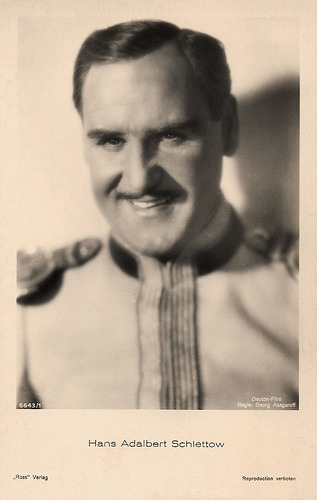
German postcard by Ross Verlag, no. 6643/1, 1931-1932. Photo: Deuton-Film. Publicity still for Der tolle Bomberg/The Mad Bomberg (Georg Asagaroff, 1932).
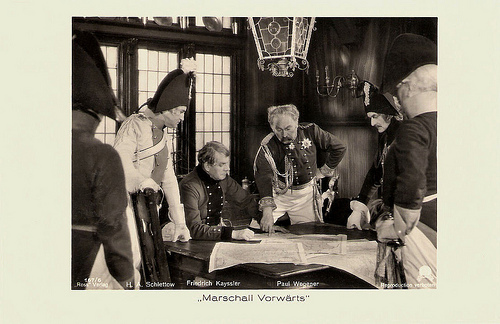
German postcard by Ross Verlag, no. 167/6. Photo: publicity still for Marschall Vorwärts/Marshal Forward (Heinz Paul, 1932) with Paul Wegener and Friedrich Kayssler.
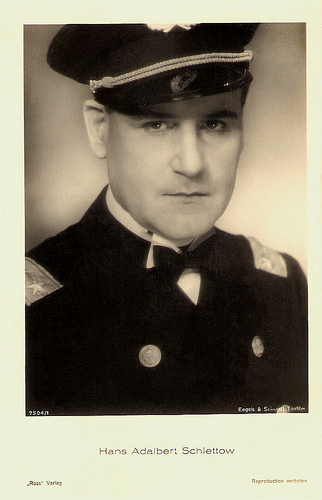
German postcard by Ross Verlag, no. 7504/1, 1932-1933. Photo: Engels & Schmidt Tonfilm.
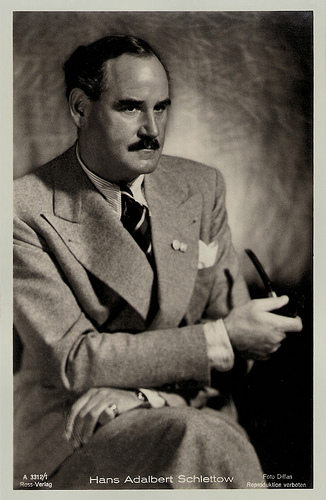
German postcard by Ross Verlag, no. A 3312/1, 1941-1944. Photo: Dillan.
Segment from Die Nibelungen (1924). Source: Dionysus Cinema (YouTube).
Sources: Thomas Staedeli (Cyranos), Philippe Pelletier (CinéArtistes - French), Steven P. Hill (IMDb), AllMovie, Filmportal.de, Wikipedia (German) and .

German postcard by Ross Verlag, Berlin, no. 672/5. Photo: Decla-Ufa-Film. Hans Adalbert Schlettow as Hagen (von) Tronje, in Fritz Lang's saga Die Nibelungen (1924).

German postcard by Ross Verlag, no. 996/1, 1925-1926. Photo: Elite, Berlin W.

German postcard by Ross Verlag, no. 3227/1, 1928-1929. Photo: Defina / Defu.

German postcard by Ross Verlag, no. 3385/1, 1928-1929. Photo: Atelier Jacobi, Berlin.

German postcard by Ross Verlag, no. 4647/1, 1929-1930. Photo: Atelier Dührkoop, Berlin.
Passionate About the Arts
Hans Adelbert Droescher von Schlettow was born in Frankfurt am Main, Germany in 1887 or 1888 (sources differ; his gravestone says the latter). He was the son of an officer and he himself also strived for a career in the army. He had to stop his military studies because of health problems.
Passionate about the arts, he then turned towards acting. Under his real name, he began his career as a trainee at the Schauspielhaus in Frankfurt in 1908. Then he went to Barmen, and from 1915 to 1919 he was committed to the Hoftheater Mannheim (Mannheim court theatre). In 1920 he joined the Phantastischen Theater in Berlin-Charlottenburg.
Under the stage name Hans Adalbert Schlettow, he made his film debut in three silent productions by director Urban Gad: Die Gespensterstunde/The Ghost Hour (Urban Gad, 1916), Der breite weg/The wide way (Urban Gad, 1916), and Klosterfriede/Monastery Peace (Urban Gad, 1917), all opposite Maria Widal and Olga Engl.
During his career, Schlettow kept changing his names, and was sometimes credited as Hans Adalbert von Schlettow, Adalbert or Adalberg von Schlettow, or Hans Schlettow. After his first film appearances he already worked with such famous stars as Pola Negri in Komtesse Doddy/Countess Doddy (Georg Jacoby, 1918), and Emil Jannings in the Sci-Fi film Algol (Hans Werckmeister, 1919), about an alien from the planet Algol who gives a man a device for superpowers.
Initially, Schlettow often played the lover, such as in the title role of Don Juan (Albert Heine, Robert Land, 1922) opposite Margarete Lanner . Gradually he specialised in sinister characters, such as Satan in Hiob/Job (Kurt Matull, 1918) with Eduard von Winterstein, a murderer in the Emile Zola adaptation Thérèse Raquin/Shadows of Fear (Jacques Feyder, 1928) with Gina Manès, and a criminal in Asphalt (Joe May, 1929).
Schlettow’s most famous films are two Fritz Lang classics, the two-part thriller Dr. Mabuse, der Spieler/Dr. Mabuse, The Gambler (Fritz Lang, 1922) in which he played the chauffeur of bad genius Dr. Mabuse ( Rudolf Klein-Rogge ), and the lushly produced UFA epic Die Nibelungen (Fritz Lang, 1924), based on the German myth of the Nibelungen, in which he played the villainous Hagen Tronje who discovers the weak spot of the great German hero Siegfried ( Paul Richter ) and pierces it with a spear.
Schlettow worked also with another legendary director of the silent cinema, David Wark Griffith on Isn't Life Wonderful (D.W. Griffith, 1924). It was Griffith's last independent production, filmed in Berlin, before he was forced to sell his Mamaroneck studio to help pay off mounting debts. At IMDb , Thataw reviews: “Though little known today (...) this little film, in my opinion, is Griffith's last great film. It incorporates the best elements of intimate dramas like Broken Blossoms with a large scale backdrop like Hearts of the World. (...) This story of a poor family's trials and tribulations in inflation ravaged post World War I Germany is remarkably grim and is presented realistically. Griffith came under heavy criticism for presenting a sympathetic portrait of a family in Germany (they had to be changed from German to Polish although one character still tears up a picture of the Kaiser) and for shooting the film in Germany itself.”
Twice Schlettow appeared as Stenka Razin, the leader of the 17th-century uprising of peasants against the Tsarist Russian establishment. In 1928 he starred in Wolga Wolga/Volga Volga, a silent film directed by Russian emigré director Viktor Tourjansky and co-starring Lilian Hall-Davies and Rudolf Klein-Rogge . In 1936 followed a sound version, Stjenka Rasin/Wolga-Wolga (1936), directed by another anti-Soviet émigré Alexandre Volkoff and co-starring Wera Engels and Heinrich George . Razin died in 1671, during the reign of Tsar Aleksei Mikhailovich (father of Peter the Great).

German postcard by Ross Verlag, no. 677/6. Photo: Decla-Ufa-Film. Publicity still for Die Nibelungen, II, Kriemhilds Rache/Kriemhild's Revenge (Fritz Lang, 1924). Das Bankett bei Etzel (The Banquet at Etzel's, King of the Huns). During the banquet the knights discover it is a trap. Hagen von Tronje (Hans Adalbert Schlettow) kills the child of Etzel ( Rudolf Klein-Rogge ) and Kriemhild ( Margarete Schön ), after which Etzel swears to kill all Burgunds. Several are killed in fights. Finally, the banqueting hall is set on fire, killing all but Hagen and king Gunther. Most sets of the film were done by Erich Kettelhut, in collaboration with Otto Hunte and Karl Vollbrecht.

German postcard by Ross Verlag, Berlin, no. 677/7. Photo: Decla-Ufa-Film. Hagen von Tronje (Hans Adalbert Schlettow) protects king Gunther (Theodoor Loos) in the burning palace of Etzel.

German postcard by Ross Verlag, no. 81/3, 1925-1935. Photo: Parufamet. Publicity still for Der Letzte Walzer/The Last Waltz (Arthur Robison, 1927) with Suzy Vernon , Willy Fritsch , Hans Adalbert Schlettow and Liane Haid .

German postcard by Ross Verlag, no. 81/4, 1925-1935. Photo: Parufamet. Publicity still for Der Letzte Walzer/The Last Waltz (Arthur Robison, 1927) with Willy Fritsch and Hans Adalbert Schlettow.

German postcard by Ross Verlag, no. 88/4. Photo: Terra Film. Publicity still for Königin Luise, 1. Teil - Die Jugend der Königin Luise/Queen Louise (Karl Grune, 1927) with Mady Christians .

German postcard by Ross Verlag, no. 3859/1, 1928-1929. Photo: Atelier Böhm, Berlin. Publicity still for Wolga Wolga/Volga Volga (Viktor Tourjansky, 1928).

French postcard by Cinémagazine-Edition, Paris, no. 653. Photo: publicity still for Wolga Wolga/Volga Volga (Viktor Tourjansky, 1928).
The Informer
In 1930, Hans Adalbert Schlettow played Harry the farmer in one of the first English sound films, the thriller A cottage in Dartmoor (Anthony Asquith, 1930) with Swedish actor Uno Henning as an escaped prisoner. The sound of this production, filmed in Sweden, has been lost and the film can now only be shown in a silent version.
After the arrival of sound, Schlettow first appeared in leading parts, such as in the comedy Der tolle Bomberg/The Mad Bomberg (Georg Asagaroff, 1932) with Vivian Gibson , and Der Jäger aus Kurpfalz/The hunter from the Palatinate (Carl Behr, 1932) with Fritz Kampers.
Later he mainly worked as a supporting actor. During the 1930s, he often appeared in Heimat-films, films with a regional background, such as An heiligen Wassern/Sacred Waters (Erich Waschneck, 1932) with Karin Hardt , Die Nacht im Forsthaus/The Roberts Case (Erich Engels, 1933) and Der Jäger von Fall/The Hunter of Fall (Hans Deppe, 1936).
In 1940, he played the role of Santer, the opponent of Winnetou, at the Karl-May-Spielen, a Karl May festival in Werder. Long before the coming to power of Adolph Hitler, Schlettow had been a sympathizer of the Nazis and their anti-Semitic theories. After 1933, Schlettow was regarded by colleagues as an informer.
During the war time he played in such productions as Die Rothschilds/The Rothschilds (Erich Waschneck, 1941), an anti-Semitic and anti-British propaganda film about the rise of the Jewish bankers (the Rothschild family) at the beginning of the 19th century, and Ohm Krüger/Uncle Krüger (Hans Steinhoff, 1941), the second-most expensive prestige and propaganda project of the Nazi period justifying the annihilation politics of the concentration camps, while claiming this to be a creation of the British in South Africa during the Boer war.
He also played in popular entertainment films as the circus spectacle Die grosse Nummer/The Big Number (Karl Anton, 1943), starring Leny Marenbach and Rudolf Prack . In August 1944 in the final phase of the Second World War, Joseph Goebbels placed him on the list of the ‘Gottbegnadeten-Liste der wichtigsten Filmschauspieler’ (the God gifted list of the main film actors), so he did not have to fight at the front.
Hans Adalbert Schlettow died anyway shortly before the end of the war in April 1945. In a burst of patriotism, he had joined the army and during the Battle of Berlin, when the Third Reich started its desperate final offensive, he became a war casualty. About his private life is known that he loved to travel often to sunny, fascist Italy with actor Eduard von Winterstein, with whom he also often worked together.

German postcard by Ross Verlag, no. 5263/1, 1930-1931. Photo: Ufa.

German postcard by Ross Verlag, no. 5263/2, 1930-1931. Photo: Ufa.

German postcard by Ross Verlag, no. 6643/1, 1931-1932. Photo: Deuton-Film. Publicity still for Der tolle Bomberg/The Mad Bomberg (Georg Asagaroff, 1932).

German postcard by Ross Verlag, no. 167/6. Photo: publicity still for Marschall Vorwärts/Marshal Forward (Heinz Paul, 1932) with Paul Wegener and Friedrich Kayssler.

German postcard by Ross Verlag, no. 7504/1, 1932-1933. Photo: Engels & Schmidt Tonfilm.

German postcard by Ross Verlag, no. A 3312/1, 1941-1944. Photo: Dillan.
Segment from Die Nibelungen (1924). Source: Dionysus Cinema (YouTube).
Sources: Thomas Staedeli (Cyranos), Philippe Pelletier (CinéArtistes - French), Steven P. Hill (IMDb), AllMovie, Filmportal.de, Wikipedia (German) and .
Published on May 14, 2018 22:00
May 13, 2018
Petula Clark
Singer, actress and composer Petula Clark (1932) is the most successful British female solo recording artist. She began as as Britain's Shirley Temple, and appeared in over 30 films. During the 1960s she became internationally known for her upbeat hits, including the evergreen Downtown.
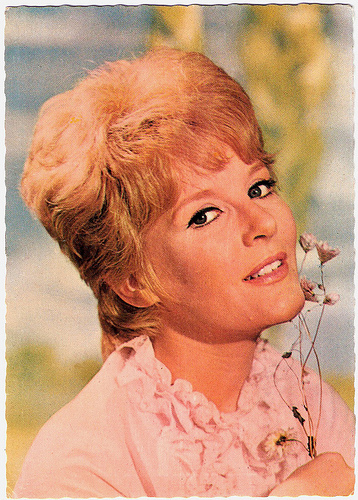
French postcard by Publistar, Marseille, no. 885. Photo: Nisak / Vogue.
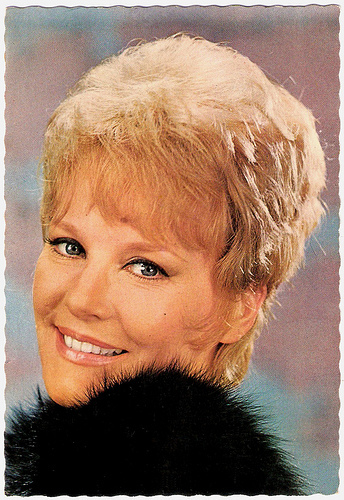
French postcard by Publistar, Marseille, no. 886. Photo: Nisak / Vogue.
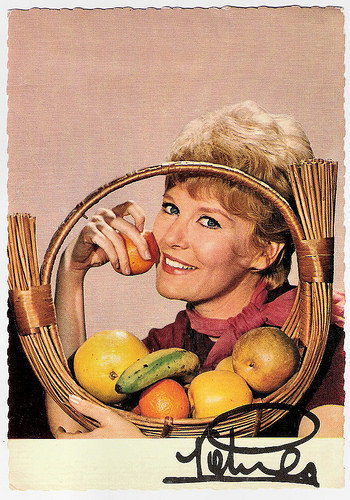
French postcard by Editions Starama, no. S-817. Photo: Disque Vogue.
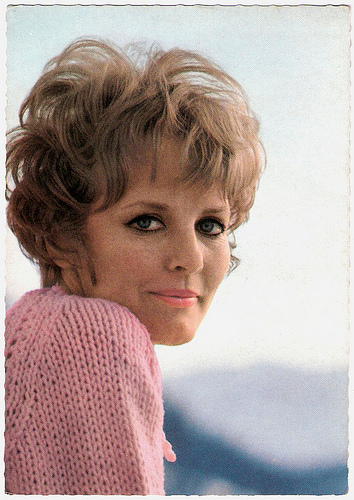
German postcard by ISV, no. 136.
Britain's Shirley Temple
Petula Sally Olwen Clark was born in Epsom, Great-Britain in 1932, to an English father, Leslie Norman Clark, and a Welsh mother Doris Clark-Phillips, who were both nurses at Long Grove Hospital in Epsom.
As a child, Petulasang in the chapel choir. In 1942, she made her radio debut while attending a BBC broadcast with her father, hoping to send a message to an uncle stationed overseas. During an air raid, the producer requested that someone perform to settle the jittery audience.
Clark volunteered a rendition of Mighty Lak a Rose to an enthusiastic response in the theatre. She then repeated her performance for the broadcast audience, launching a series of some 500 appearances in programmes to entertain the troops.
In addition to this radio work, Clark frequently toured the UK with fellow child performer Julie Andrews . 'Britain's Shirley Temple' was considered a mascot by the RAF . In 1944, while performing at London's Royal Albert Hall, Clark was discovered by film director Maurice Elvey.
Elvey cast her as an orphaned waif in his weepy war drama Medal for the General (1944). In quick succession, she starred in Strawberry Roan (Maurice Elvey, 1945) and I Know Where I'm Going! (Michael Powell, Emeric Pressburger, 1945) starring Wendy Hiller.
Then followed London Town (Wesley Ruggles, 1946), and Here Come the Huggetts (Ken Annakin, 1948), the first in a series of Huggett Family films based on a British radio series.
Although most of the other 24 films she made during the 1940s and 1950s were B-films, she did work with Anthony Newley in Vice Versa (Peter Ustinov, 1948) and Alec Guinness in The Card (Ronald Neame, 1952).
In 1946, she launched her television career with an appearance on a BBC variety show, Cabaret Cartoons, which led to her being signed to host her own afternoon series, titled simply Petula Clark. A second, Pet's Parlour, followed in 1949. In later years, she starred in This is Petula Clark (1966-1967) and The Sound of Petula (1972-1974).
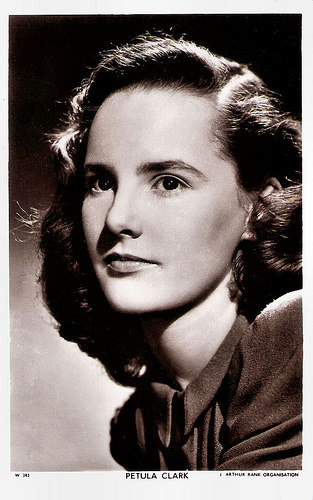
British postcard in the Picturegoer Series, London, no. W 385. Photo: J. Arthur Rank Organisation.
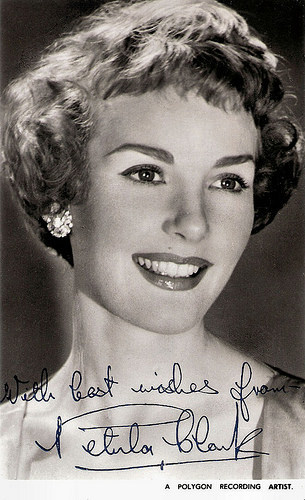
British autograph card by Polygon. Photo: John Vickers.

Italian postcard by Rotalfoto, Milano, no. 129. Photo: Rank Film. Publicity still for The Card (Ronald Neame, 1952).
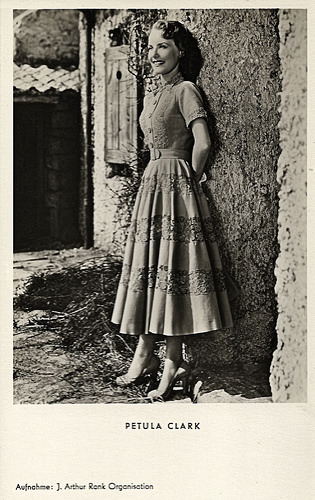
German postcard by Kunst und Bild, Berlin, no. A 776. Photo: J. Arthur Rank. Publicity still for Made in Heaven (John Paddy Carstairs, 1952).
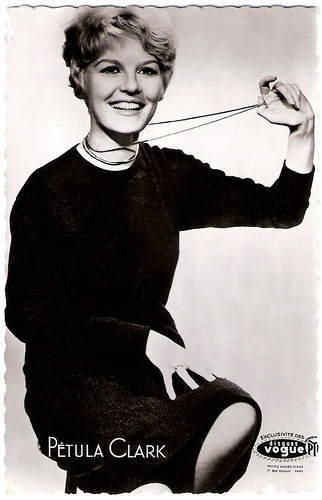
Dutch postcard, sent by mail in 1965. Photo: Vogue.
Mr. Piano
In 1949, Petula Clark recorded her first songs Music, Music, Music and Put Your Shoes On, Lucy. Because neither EMI nor Decca, for whom she had recorded, were keen to sign her to a long-term contract, Clark's father teamed with Alan A. Freeman to form their own label, Polygon Records.
She scored a number of major hits in the UK during the 1950s, including The Little Shoemaker (1954), Majorca (1955), Suddenly There's a Valley (1955) and With All My Heart (1956).
It was around 1955 that Clark became romantically linked with Joe 'Mr Piano' Henderson. Their relationship lasted a couple of years, professionally culminating in a BBC Radio series in which they performed together.
Near the end of 1955, Polygon Records was sold to Pye Records, for whom she would record for the remainder of the 1950s, throughout the 1960s and early into the 1970s. In 1958, Clark was invited to appear at the Olympia in Paris where, despite her misgivings, she was received with acclaim.
At the office of Vogue Records she met publicist Claude Wolff, to whom she was attracted, and when told he would work with her if she signed with the label, she agreed. Her initial French recordings were huge successes. Gradually she moved further into the continent, recording in German, French, Italian and Spanish, and establishing herself as a multi-lingual performer.
In 1961, Clark married Wolff. Wanting to escape the strictures of child stardom imposed upon her by the British public, and anxious to escape the influence of her father, she relocated to France, where she and Wolff had two daughters, Barbara Michelle and Katherine Natalie. Their son Patrick was born in 1972.
While she focused on her new career in France, she continued to achieve hit records in the UK into the early 1960s, developing a parallel career on both sides of the Channel. Her 1961 recording of Sailor became her first #1 hit in the UK. In France, Ya Ya Twist (the only successful recording of a twist song by a female) and Chariot (the original version of I Will Follow Him) became smash hits in 1962.
Released in four different languages in late 1964, Downtown was a success in the UK, France, Netherlands, Germany, Australia, Italy, and even in Rhodesia, Japan, and India, and it went to #1 on the US charts in January 1965.
It was the first of fifteen consecutive Top 40 hits Clark scored in the USA, including I Know a Place, , A Sign of the Times, I Couldn't Live Without Your Love, This Is My Song, and Don't Sleep in the Subway. She was honoured with Grammy Awards for Downtown in 1964 and for I Know a Place in 1965. In 2003, Downtown was inducted into the Grammy Hall of Fame.
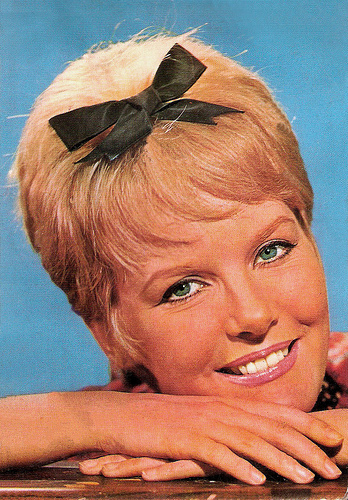
French postcard by E.P.M.B., no. 767. Photo: Vogue.
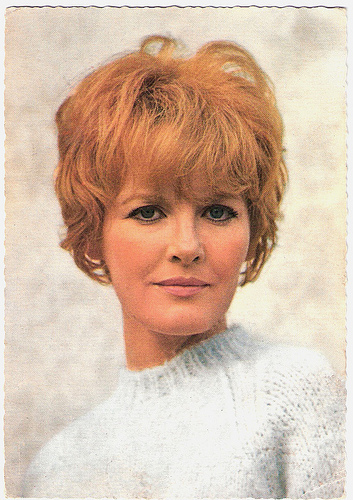
French postcard by PSG, no 1129. Offered by Korès.
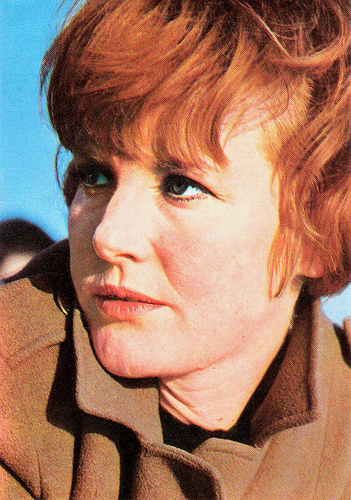
Italian postcard Photo: SAAR.
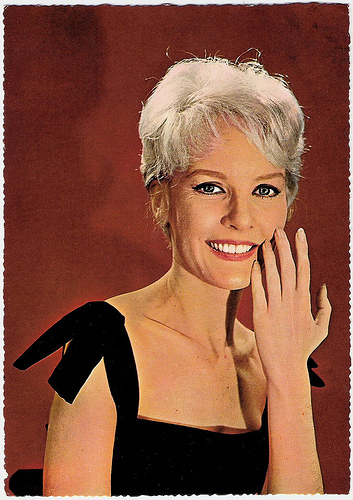
Belgian postcard by Uitg. Best (SB), Antwerpen.
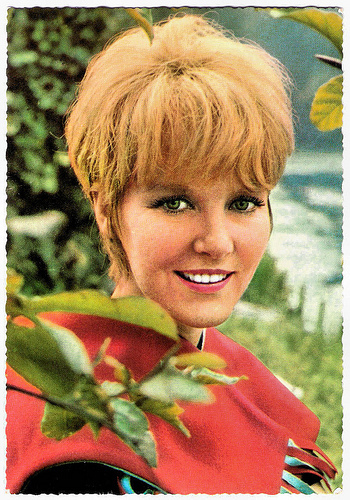
German postcard by Krüger, no. 902/264. Photo: Neuvecelle.
Maria von Trapp
In 1964, Petula Clark wrote the musical score for the French crime caper A Couteaux Tirés/Daggers Drawn (1964) and also played a cameo in it as herself. Although it was only a mild success, it added a new dimension — that of film composer — to her career.
In 1968, NBC invited Clark to host her own special in the US, and in doing so she inadvertently made television history. While singing a duet of On the Path of Glory, an anti-war song she had composed, with guest Harry Belafonte, she touched his arm, to the dismay of a representative from Chrysler, the show's sponsor, who feared the brief moment would offend Southern viewers at a time when racial conflict was still a major issue in the US.
When he insisted they substitute a different take, with Clark and Belafonte standing well away from each other, she and husband Wolff, producer of the show, refused, destroyed all other takes of the song, and delivered the finished program to NBC with the touch intact. It aired to high ratings and critical acclaim, and marked the first time a man and woman of different races exchanged physical contact on American television.
Throughout the 1960s and 1970s, Clark toured in concert extensively throughout the States. She revived her film career, starring in two big musical films: Finian's Rainbow (Francis Ford Coppola, 1968) opposite Fred Astaire (for which she was nominated for a Best Actress Golden Globe Award), and Goodbye, Mr. Chips (Herbert Ross, 1969) with Peter O'Toole .
After this, her output of hits in the States diminished markedly, although she continued to record and make television appearances into the 1970s. By the mid-1970s, she scaled back her career to devote more time to her family. Her last film to date is the British production Never Never Land (Paul Annett, 1980).
In 1981, at the urging of her children, she returned to legitimate theatre, starring as Maria von Trapp in The Sound of Music in London's West End. Opening to rave reviews and what was then the largest advance sale in British theatre history, Clark extended her initial six-month run to thirteen to accommodate the huge demand for tickets.
In 1983, she took on the title role in George Bernard Shaw's Candida. Later stage work included Someone Like You (1989-1990), for which she also composed the score; her Broadway debut Blood Brothers (1993), and Sunset Boulevard (1995-2000), appearing in both the West End and US touring productions.
In 1998, Clark was made a CBE (Commander of the Order of the British Empire). With more than 68 million records sold worldwide, she is the most successful British female solo recording artist and is cited as such in the Guinness Book of World Records.

French postcard offered by Corvisart, Épinal, no. 1505.
Scene from the first Huggett film, Here Come The Huggetts (1948). Source: Little Shoemaker (YouTube).
Scene from Finian's Rainbow (1968). Source: M1ckeyJoe (YouTube).
Sources: Petula Clark.net, PetulaClark.co.uk, Wikipedia, and .

French postcard by Publistar, Marseille, no. 885. Photo: Nisak / Vogue.

French postcard by Publistar, Marseille, no. 886. Photo: Nisak / Vogue.

French postcard by Editions Starama, no. S-817. Photo: Disque Vogue.

German postcard by ISV, no. 136.
Britain's Shirley Temple
Petula Sally Olwen Clark was born in Epsom, Great-Britain in 1932, to an English father, Leslie Norman Clark, and a Welsh mother Doris Clark-Phillips, who were both nurses at Long Grove Hospital in Epsom.
As a child, Petulasang in the chapel choir. In 1942, she made her radio debut while attending a BBC broadcast with her father, hoping to send a message to an uncle stationed overseas. During an air raid, the producer requested that someone perform to settle the jittery audience.
Clark volunteered a rendition of Mighty Lak a Rose to an enthusiastic response in the theatre. She then repeated her performance for the broadcast audience, launching a series of some 500 appearances in programmes to entertain the troops.
In addition to this radio work, Clark frequently toured the UK with fellow child performer Julie Andrews . 'Britain's Shirley Temple' was considered a mascot by the RAF . In 1944, while performing at London's Royal Albert Hall, Clark was discovered by film director Maurice Elvey.
Elvey cast her as an orphaned waif in his weepy war drama Medal for the General (1944). In quick succession, she starred in Strawberry Roan (Maurice Elvey, 1945) and I Know Where I'm Going! (Michael Powell, Emeric Pressburger, 1945) starring Wendy Hiller.
Then followed London Town (Wesley Ruggles, 1946), and Here Come the Huggetts (Ken Annakin, 1948), the first in a series of Huggett Family films based on a British radio series.
Although most of the other 24 films she made during the 1940s and 1950s were B-films, she did work with Anthony Newley in Vice Versa (Peter Ustinov, 1948) and Alec Guinness in The Card (Ronald Neame, 1952).
In 1946, she launched her television career with an appearance on a BBC variety show, Cabaret Cartoons, which led to her being signed to host her own afternoon series, titled simply Petula Clark. A second, Pet's Parlour, followed in 1949. In later years, she starred in This is Petula Clark (1966-1967) and The Sound of Petula (1972-1974).

British postcard in the Picturegoer Series, London, no. W 385. Photo: J. Arthur Rank Organisation.

British autograph card by Polygon. Photo: John Vickers.

Italian postcard by Rotalfoto, Milano, no. 129. Photo: Rank Film. Publicity still for The Card (Ronald Neame, 1952).

German postcard by Kunst und Bild, Berlin, no. A 776. Photo: J. Arthur Rank. Publicity still for Made in Heaven (John Paddy Carstairs, 1952).

Dutch postcard, sent by mail in 1965. Photo: Vogue.
Mr. Piano
In 1949, Petula Clark recorded her first songs Music, Music, Music and Put Your Shoes On, Lucy. Because neither EMI nor Decca, for whom she had recorded, were keen to sign her to a long-term contract, Clark's father teamed with Alan A. Freeman to form their own label, Polygon Records.
She scored a number of major hits in the UK during the 1950s, including The Little Shoemaker (1954), Majorca (1955), Suddenly There's a Valley (1955) and With All My Heart (1956).
It was around 1955 that Clark became romantically linked with Joe 'Mr Piano' Henderson. Their relationship lasted a couple of years, professionally culminating in a BBC Radio series in which they performed together.
Near the end of 1955, Polygon Records was sold to Pye Records, for whom she would record for the remainder of the 1950s, throughout the 1960s and early into the 1970s. In 1958, Clark was invited to appear at the Olympia in Paris where, despite her misgivings, she was received with acclaim.
At the office of Vogue Records she met publicist Claude Wolff, to whom she was attracted, and when told he would work with her if she signed with the label, she agreed. Her initial French recordings were huge successes. Gradually she moved further into the continent, recording in German, French, Italian and Spanish, and establishing herself as a multi-lingual performer.
In 1961, Clark married Wolff. Wanting to escape the strictures of child stardom imposed upon her by the British public, and anxious to escape the influence of her father, she relocated to France, where she and Wolff had two daughters, Barbara Michelle and Katherine Natalie. Their son Patrick was born in 1972.
While she focused on her new career in France, she continued to achieve hit records in the UK into the early 1960s, developing a parallel career on both sides of the Channel. Her 1961 recording of Sailor became her first #1 hit in the UK. In France, Ya Ya Twist (the only successful recording of a twist song by a female) and Chariot (the original version of I Will Follow Him) became smash hits in 1962.
Released in four different languages in late 1964, Downtown was a success in the UK, France, Netherlands, Germany, Australia, Italy, and even in Rhodesia, Japan, and India, and it went to #1 on the US charts in January 1965.
It was the first of fifteen consecutive Top 40 hits Clark scored in the USA, including I Know a Place, , A Sign of the Times, I Couldn't Live Without Your Love, This Is My Song, and Don't Sleep in the Subway. She was honoured with Grammy Awards for Downtown in 1964 and for I Know a Place in 1965. In 2003, Downtown was inducted into the Grammy Hall of Fame.

French postcard by E.P.M.B., no. 767. Photo: Vogue.

French postcard by PSG, no 1129. Offered by Korès.

Italian postcard Photo: SAAR.

Belgian postcard by Uitg. Best (SB), Antwerpen.

German postcard by Krüger, no. 902/264. Photo: Neuvecelle.
Maria von Trapp
In 1964, Petula Clark wrote the musical score for the French crime caper A Couteaux Tirés/Daggers Drawn (1964) and also played a cameo in it as herself. Although it was only a mild success, it added a new dimension — that of film composer — to her career.
In 1968, NBC invited Clark to host her own special in the US, and in doing so she inadvertently made television history. While singing a duet of On the Path of Glory, an anti-war song she had composed, with guest Harry Belafonte, she touched his arm, to the dismay of a representative from Chrysler, the show's sponsor, who feared the brief moment would offend Southern viewers at a time when racial conflict was still a major issue in the US.
When he insisted they substitute a different take, with Clark and Belafonte standing well away from each other, she and husband Wolff, producer of the show, refused, destroyed all other takes of the song, and delivered the finished program to NBC with the touch intact. It aired to high ratings and critical acclaim, and marked the first time a man and woman of different races exchanged physical contact on American television.
Throughout the 1960s and 1970s, Clark toured in concert extensively throughout the States. She revived her film career, starring in two big musical films: Finian's Rainbow (Francis Ford Coppola, 1968) opposite Fred Astaire (for which she was nominated for a Best Actress Golden Globe Award), and Goodbye, Mr. Chips (Herbert Ross, 1969) with Peter O'Toole .
After this, her output of hits in the States diminished markedly, although she continued to record and make television appearances into the 1970s. By the mid-1970s, she scaled back her career to devote more time to her family. Her last film to date is the British production Never Never Land (Paul Annett, 1980).
In 1981, at the urging of her children, she returned to legitimate theatre, starring as Maria von Trapp in The Sound of Music in London's West End. Opening to rave reviews and what was then the largest advance sale in British theatre history, Clark extended her initial six-month run to thirteen to accommodate the huge demand for tickets.
In 1983, she took on the title role in George Bernard Shaw's Candida. Later stage work included Someone Like You (1989-1990), for which she also composed the score; her Broadway debut Blood Brothers (1993), and Sunset Boulevard (1995-2000), appearing in both the West End and US touring productions.
In 1998, Clark was made a CBE (Commander of the Order of the British Empire). With more than 68 million records sold worldwide, she is the most successful British female solo recording artist and is cited as such in the Guinness Book of World Records.

French postcard offered by Corvisart, Épinal, no. 1505.
Scene from the first Huggett film, Here Come The Huggetts (1948). Source: Little Shoemaker (YouTube).
Scene from Finian's Rainbow (1968). Source: M1ckeyJoe (YouTube).
Sources: Petula Clark.net, PetulaClark.co.uk, Wikipedia, and .
Published on May 13, 2018 22:00
Paul van Yperen's Blog
- Paul van Yperen's profile
- 13 followers
Paul van Yperen isn't a Goodreads Author
(yet),
but they
do have a blog,
so here are some recent posts imported from
their feed.



